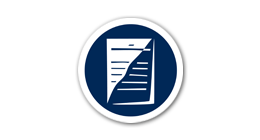Corona Crisis: 07 Central and South America
Newspaper front pages about the Corona Crisis from around the globe are presented here. These are examples from February to May 2020 from both Central and South America.
Newspaper front pages about the Corona Crisis from around the globe are presented here. These are examples from February to May 2020 from both Central and South America.
Websites about the Corona Crisis from around the world are presented here. These are examples from February to May 2020.
Magazine pages about the Corona Crisis from around the world are presented here. These are pages from March to May 2020.
von Norbert Küpper
Der European Newspaper Award hat zum 20. Mal stattgefunden. Einige Online-Projekte werden hier vorgestellt. Links führen zu den Projekten. Alle Arbeiten funktionieren reibungslos am Bildschirm und auf dem Smartphone.
Jahrbuch
Alle ausgezeichneten Projekte in Print und Online findet man im Jahrbuch “Zeitungsdesign 20”, das schon bald auf DVD bzw. USB-Stick erscheinen wird. Preis 35 Euro. Vorbestellungen per Email sind möglich: nkuepper@newspaperaward.org
Statistik
Am 20. European Newspaper Award haben sich 182 Zeitungen aus 27 Ländern beteiligt. In den 18 Kategorien wurden insgesamt 4.625 Arbeiten eingereicht. Kategorien mit den meisten Einreichungen: Fotografie 685, Cover und Coverstory 515, Infografiken Print 506, Nachrichten-Seiten 425, Sektions-Titelseiten 388, Illustration 365, Online 225.
Facebook
Der European Newspaper Award hat viele Freunde auf Facebook. Der LINK.
Hauptpreisträger
Lokalzeitung: Sunnhordland, Norwegen; Regionalzeitung: Adresseavisen, Norwegen; Überregionale Zeitung: fd. Het Financieele Dagblad, Niederlande; Wochenzeitung: der Freitag, Deutschland.
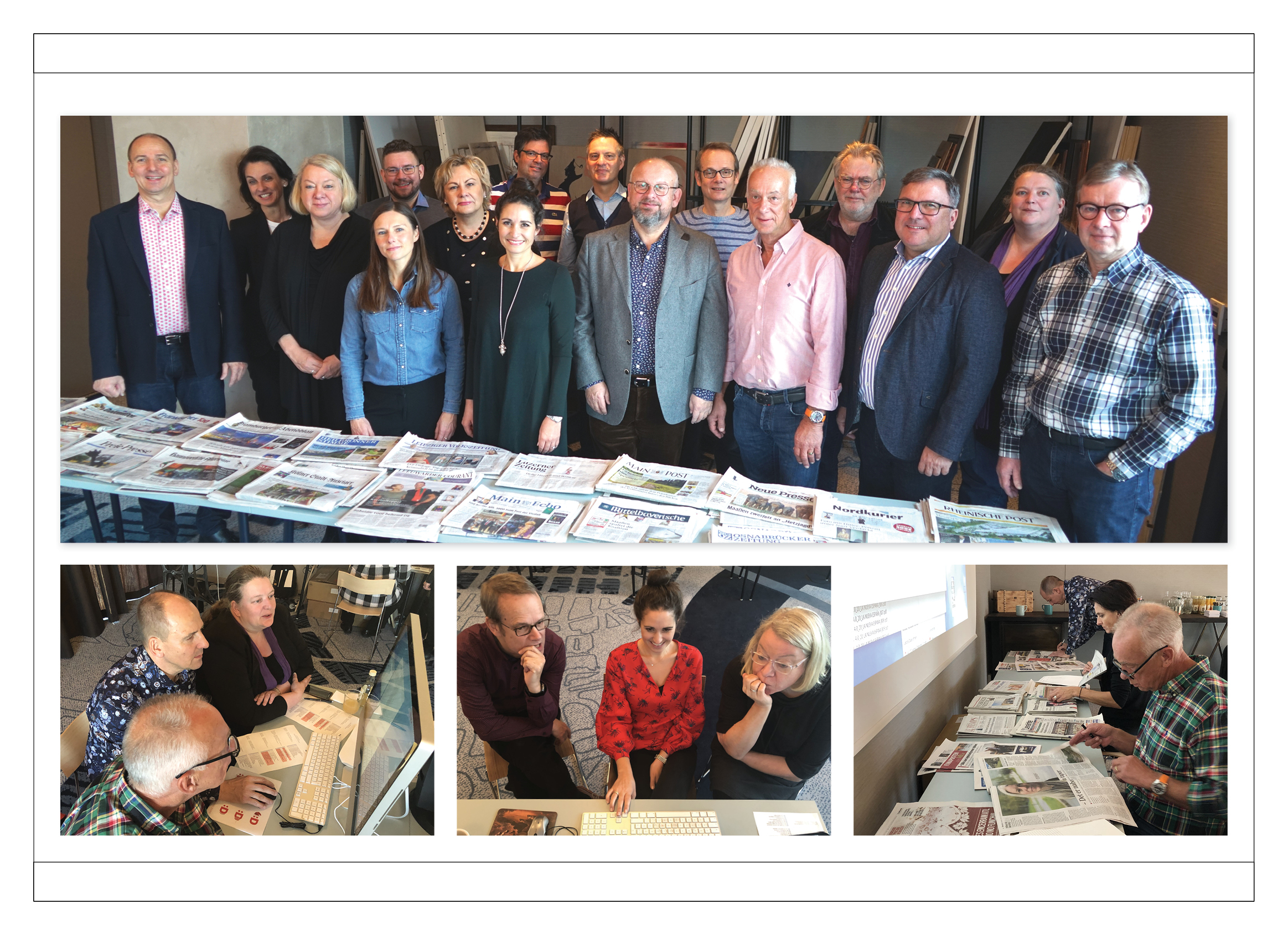 Die Jury des 20. European Newspaper Award (Bild oben, von links)
Die Jury des 20. European Newspaper Award (Bild oben, von links)
– Dirk Steininger, Art-Director, Stuttgarter Zeitung, D
– Marianne Bahl, Art-Director, Børsen, DK
– Marianne Hartz, Art-Director, Lebensmittel Zeitung, D
– Tanja Starkowski, Bildredakteurin, St. Galler Tagblatt, CH
– Björn Heselius, Principal Designer, Nitor, FIN
– Annette Milz, Chefredakteurin MediumMagazin, D
– Marco Grieco, Art-Director, Expresso, P
– Regina Baierl, Art-Director, Handelsblatt, D
– Søren Nyeland, Art-Director, Politiken, DK
– Prof. Dr. Martin Zimper, ZHdK/Cast, CH
– Martin Huisman, Art-Director, Het Nieuwsblad, B
– Walter Jensen, Art-Director, Bergens Tidende, N
– Theo Dersjant, Director Fontys School of Journalism, NL
– Andreas Kemper, Mitglied der Chefredaktion, Main-Post, D
– Alie Veenhuizen, Art-Director, Leeuwarder Courant, NL
– Prof. Joachim Blum, Media-Consultant, D
Mitglieder der Jury sind von der Bewertung der eigenen Arbeit ausgeschlossen.
Die Jury arbeitete in fünf Gruppen. Zwei Gruppen haben die Einreichungen in Online-Kategorien bewertet.
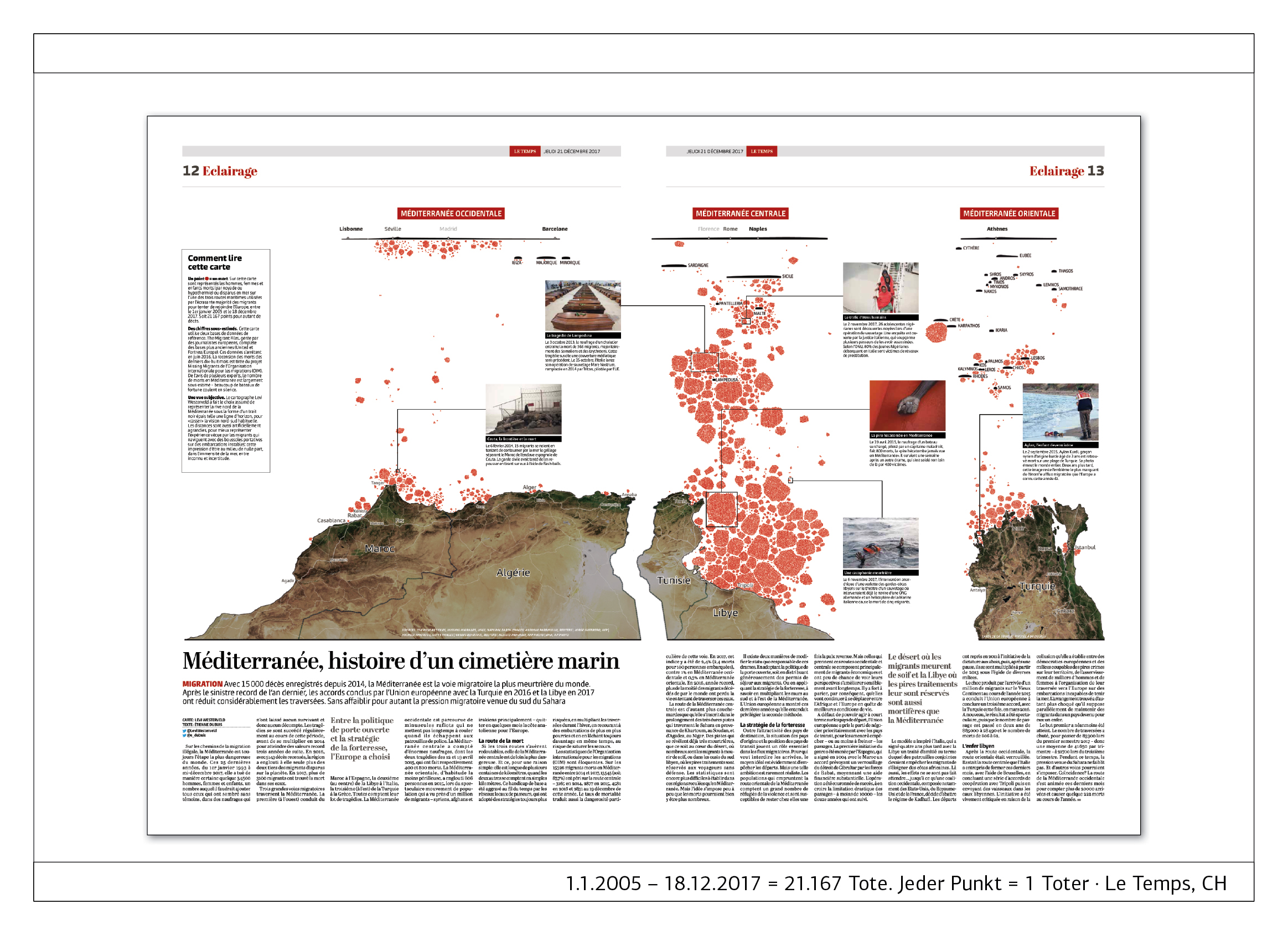
Print: Le Temps, Schweiz. Die Zeitung veröffentlichte eine Doppelseite mit 21.167 roten Punkten. Die Überschrift lautet sinngemäß “Mittelmeer, Geschichte eines maritimen Friedhofs”. Die roten Punkte zeigen, wo zwischen dem 1.1.2005 und dem 18.12.2017 Flüchtlinge im Mittelmeer ums Leben gekommen sind. Es sind drei Schwerpunkte: An der Straße von Gibraltar, vor der Küste Tunesiens und Lybiens und zwischen der Türkei und Griechenland. Es werden jeweils Ausschnitte gezeigt, nicht das gesamte Mittelmeer.
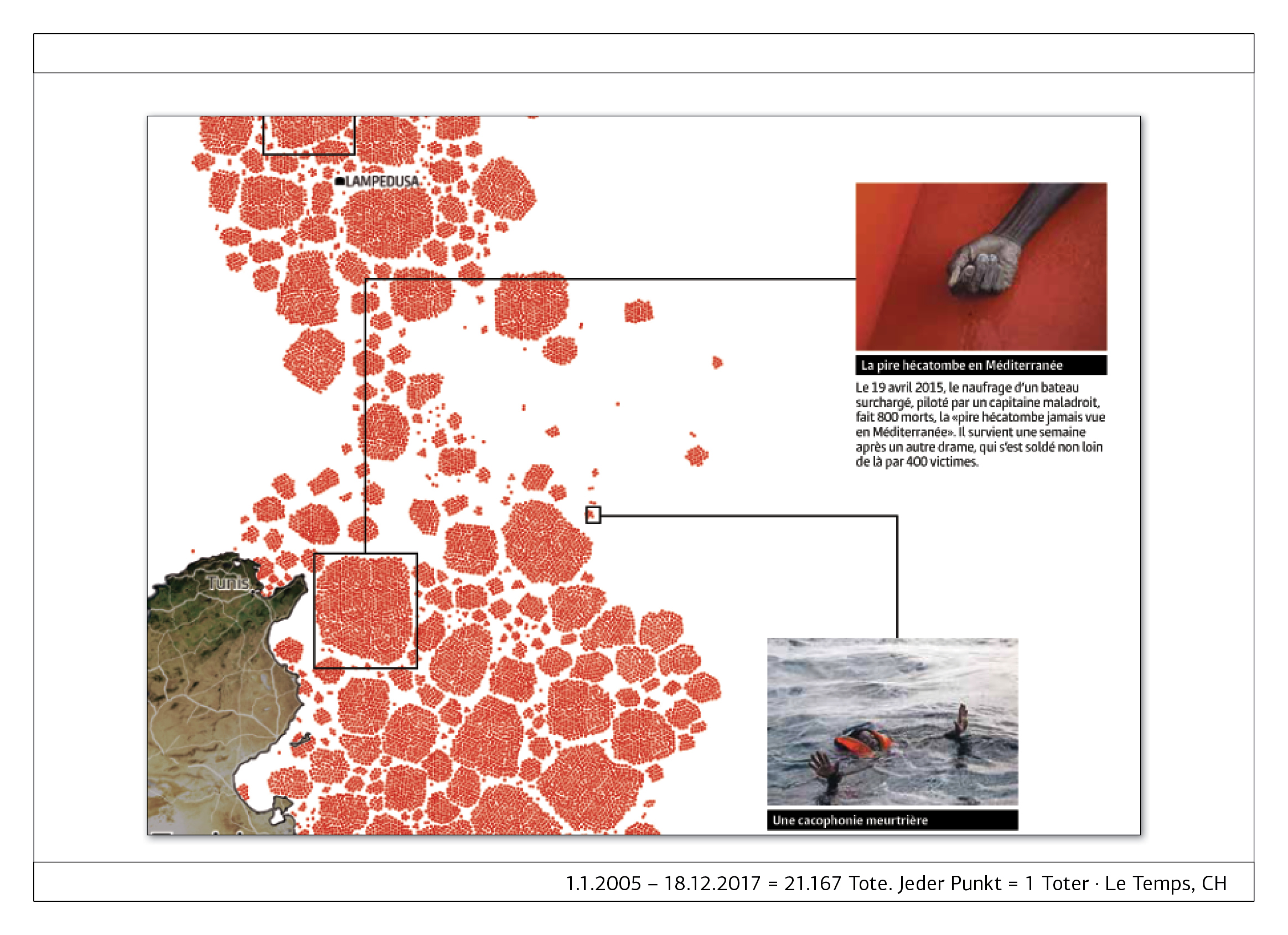
Le Temps, CH. Beispiel für Flüchtlings-Berichterstattung Print, Detailansicht. Jeder rote Punkt symbolisiert einen Toten. Es sind 21.167.
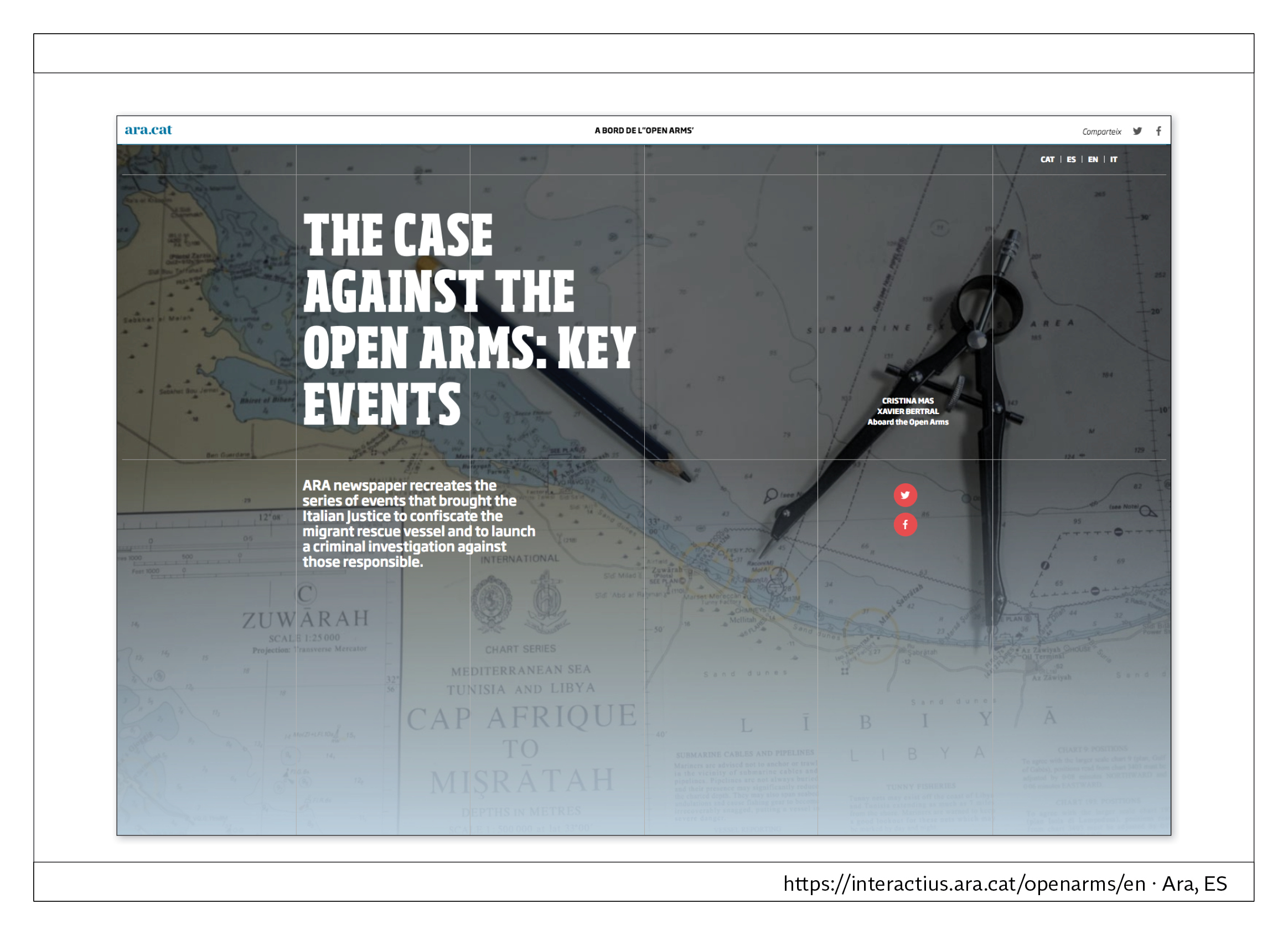
Online: Ara, Spanien. Das Verfahren gegen die ‘Open Arms’: Schlüsselereignisse. Die in Barcelona erscheinende Zeitung ARA stellt in einer Multimedia-Story die Ereignisse dar, die die italienische Justiz veranlassten, das Rettungsschiff „Open Arms“ zu konfiszieren und ein Ermittlungsverfahren gegen die Verantwortlichen einzuleiten. Während einer Rettungsaktion vor der Lybischen Küste hatte die Zeitung ein Team von Reportern an Bord. Die Story finden Sie HIER.
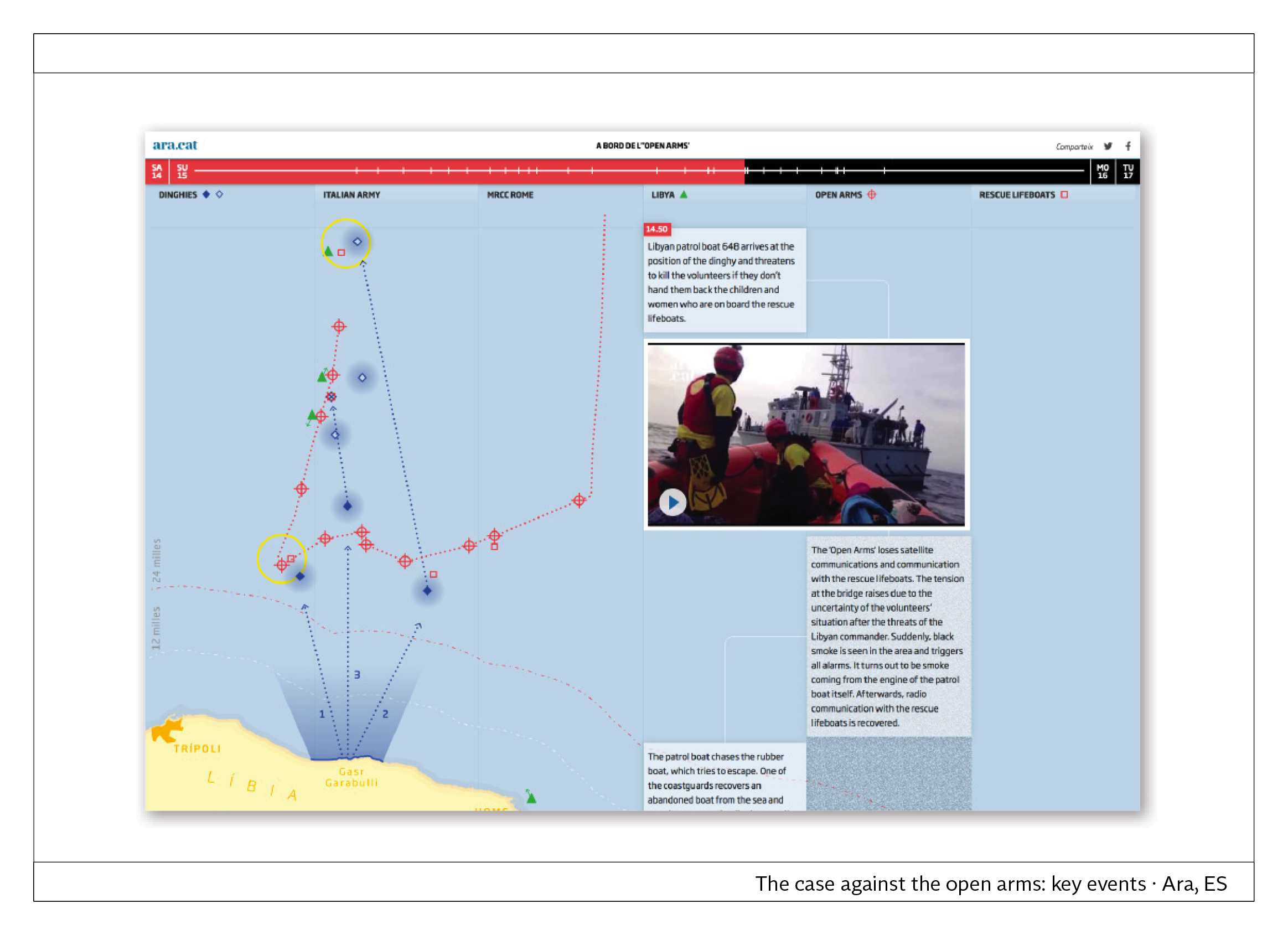
Online: Ara, Spanien. Das Geschehen wird anhand einer Seekarte visualisiert, auf der man sehen kann, wo sich Flüchtlingsboote und das Rettungsschiff befinden. Fotos und kurze Filme geben einen Eindruck vom Geschehen. Die Texte sind mit Uhrzeiten versehen, damit der Leser verfolgen kann, was in welcher Reihenfolge geschehen ist. Oben ist eine Zeitschiene, die sich mit dem Scrollen mehr und mehr rot verfärbt. Dadurch weiß der Leser, an welcher Stelle der Rettungsaktion er sich befindet.
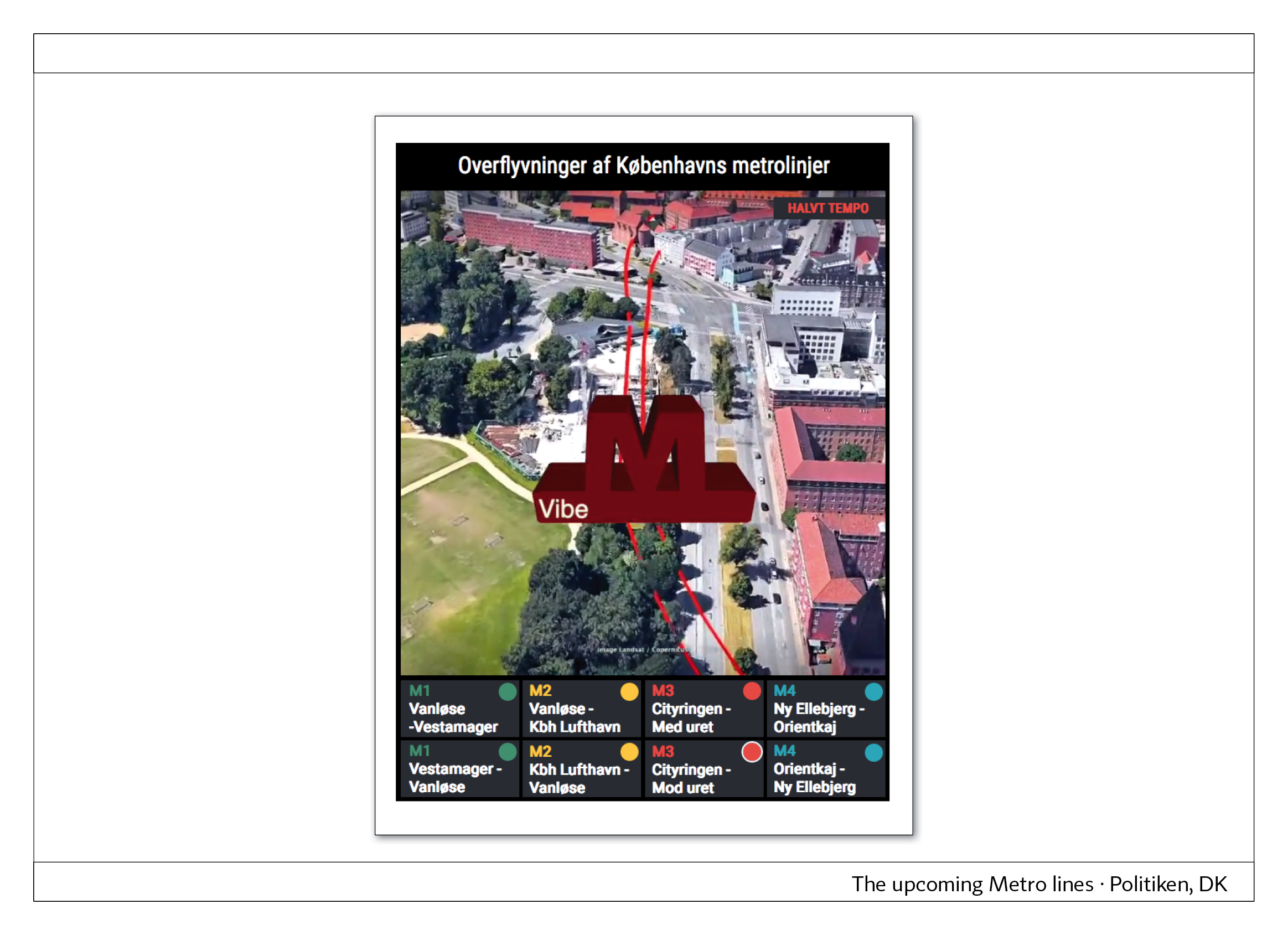
Politiken, DK: Die Zeitung zeigt sehr anschaulich eine geplante U-Bahn-Strecke. Sehr interessantes Projekt, angesiedelt zwischen Film und animierter Infografik. Das Projekt finden Sie HIER.
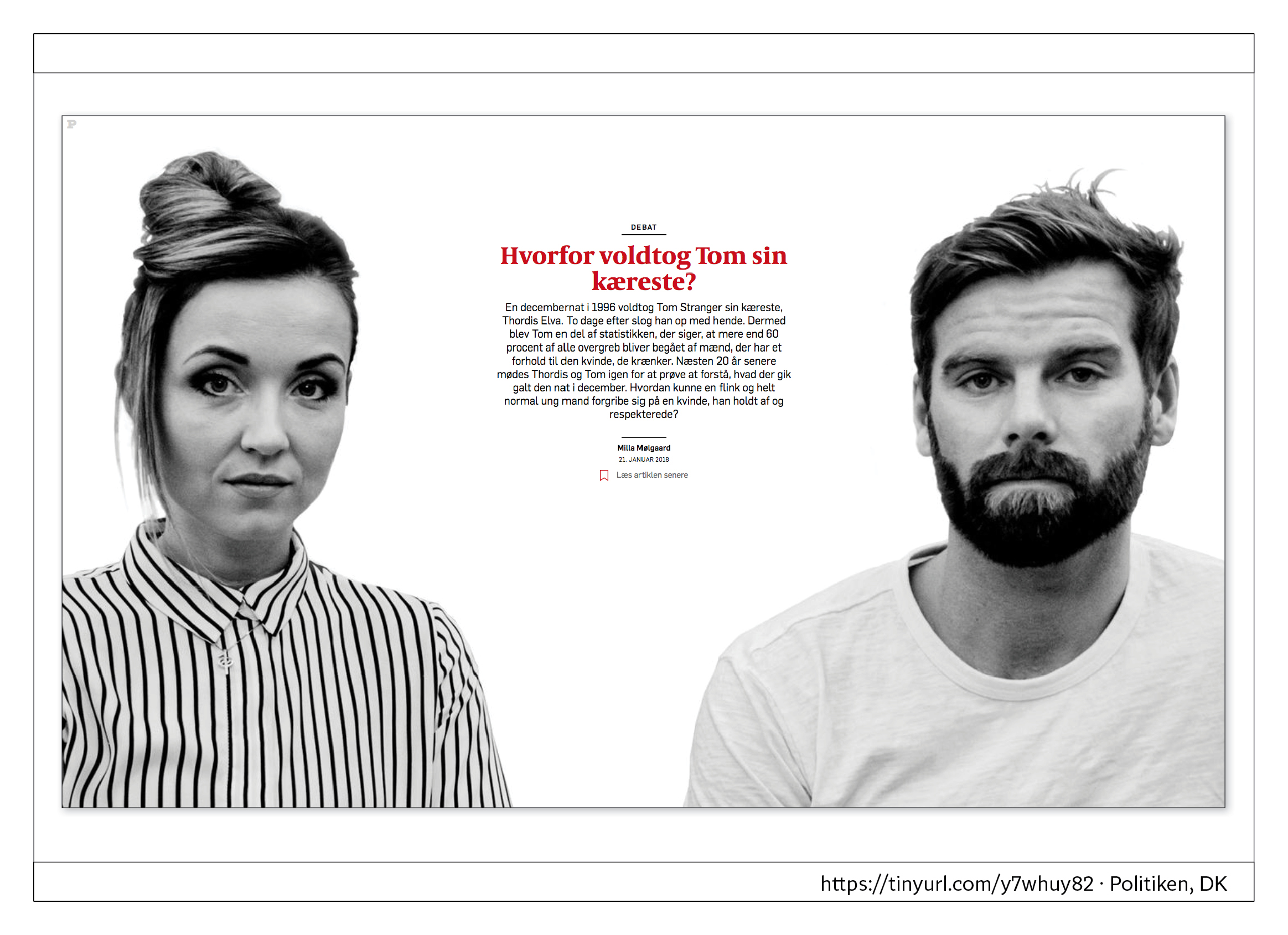
Politiken, DK: Warum hat Tom seine Freundin Thordis vergewaltigt? Fast 20 Jahre nach der Vergewaltigung treffen sich Thordis und Tom erneut, um zu verstehen, was in dieser Nacht im Dezember schiefgegangen ist. Wie konnte ein ganz normaler junger Mann gegenüber der Frau, die er liebte und respektierte, so handeln? Die Geschichte läuft in zwei parallel verlaufenden Spuren. Man kann zwischen den beiden Personen hin- und her wechseln. Die Story finden Sie HIER.
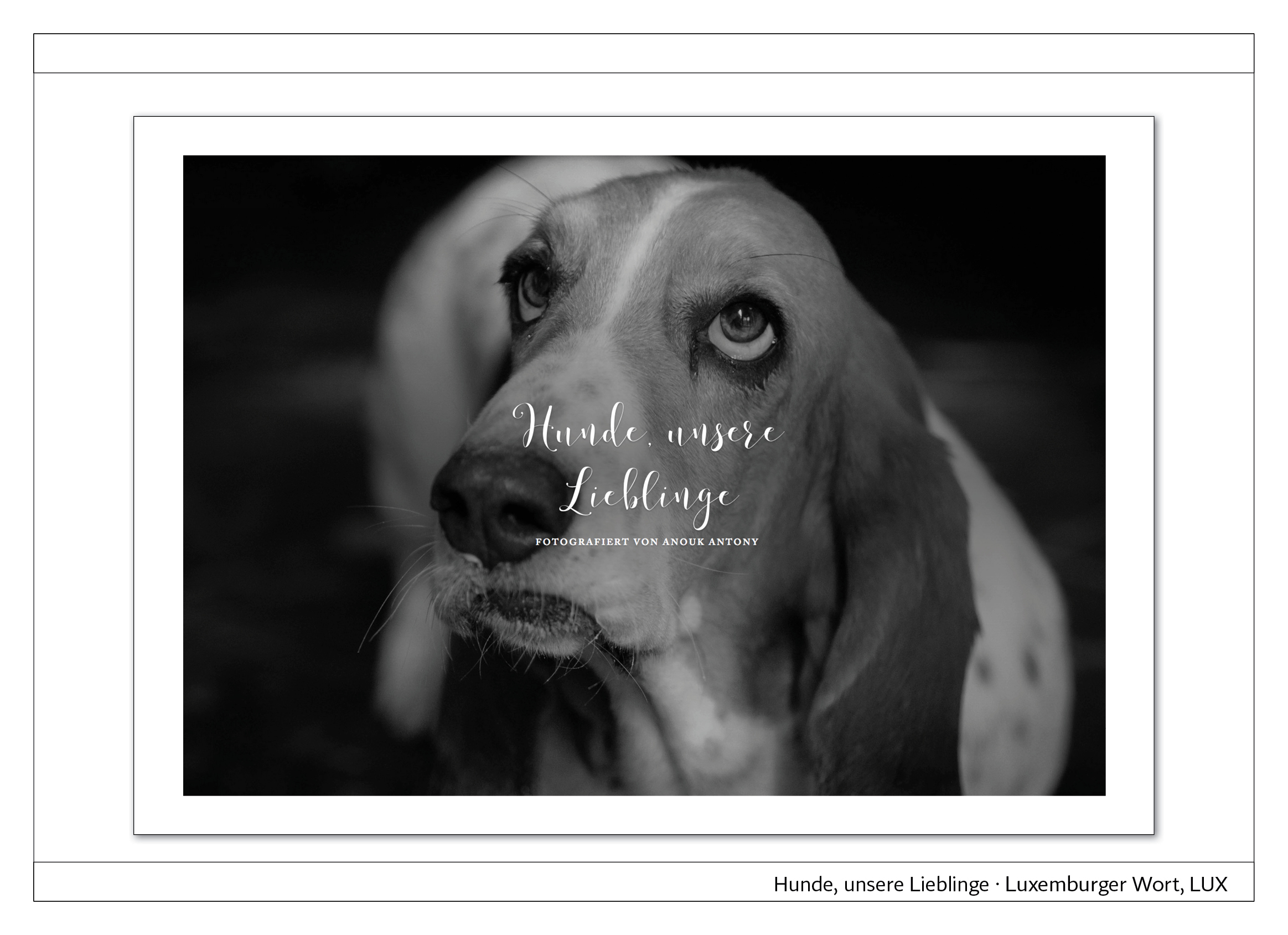
Luxemburger Wort, LUX: Hunde, unsere Lieblinge. Die Zeitung bietet einen enstspannten Blick auf Hunde. Es werden Schwarzweiß-Fotos eingesetzt, fotografiert von Anouk Antony. Die Perspektive wechselt, es gibt Totalen und Nahaufnahmen. Das Projekt wurde mit der Software Adobe Spark realisiert. Die Arbeit mit überlappenden Fotos auf verschiedenen Ebenen ist interessant. Das Projekt finden Sie HIER.
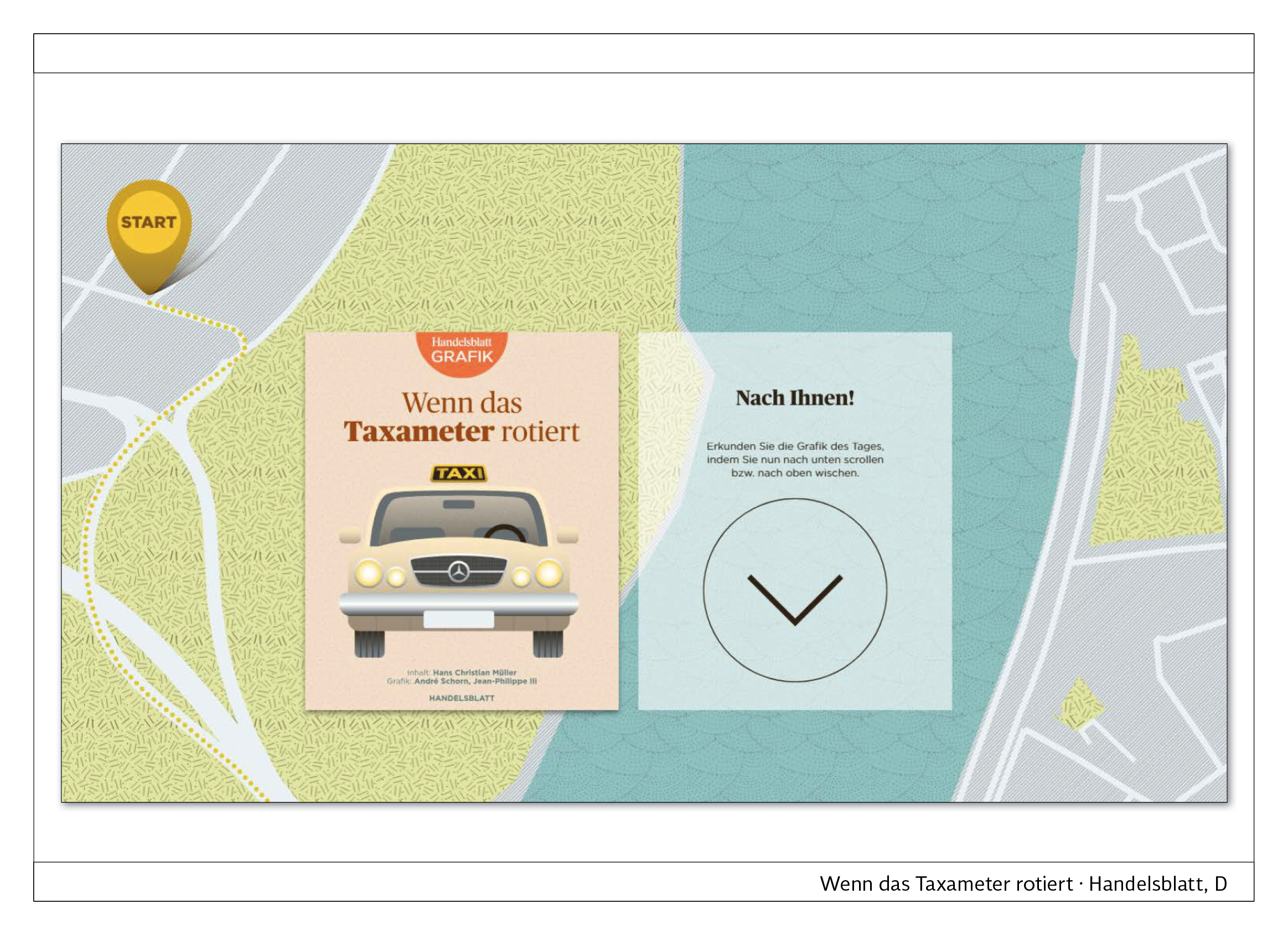
Handelsblatt, D: Wenn das Taxameter rotiert. Die Zeitung gibt anhand von kleinen animierten Infografiken einen Überblick über den Taximarkt in Deutschland. Das Projekt zeigt beispielhaft, wie man komplexe Themen für das Smartphone aufbereitet. Der Trick: Statt einer komplexen Infografik viele kleine einsetzen. Das Projekt finden Sie HIER.
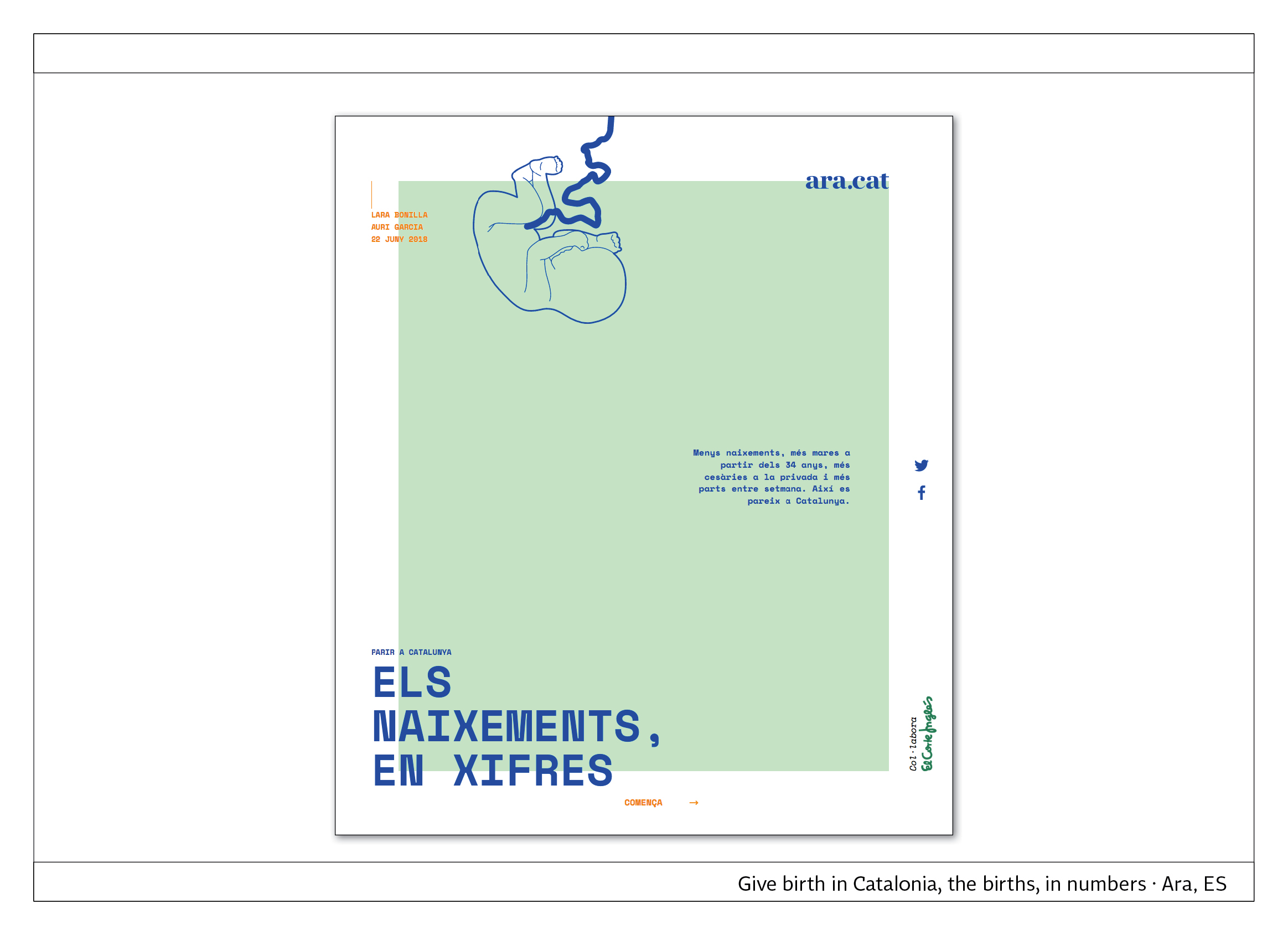
Ara, ES: Geburten in Zahlen. Anhand von 19 animierten Infografiken wird über die Geburtenrate in Katalonien berichet. Beispiele: 1986 waren die Mütter bei der Geburt ihres ersten Kindes im Durchschnitt 26,1 Jahre alt, 2016 sind sie 30,8 Jahre alt. 69 Prozent der Geburten erfolgten in öffentlichen Kiniken, 30,5 Prozent in Privat-Kliniken. Die Infografiken funktionieren sowohl auf dem Bildschirm wie auf dem Smartphone sehr gut. Die Story finden Sie HIER.
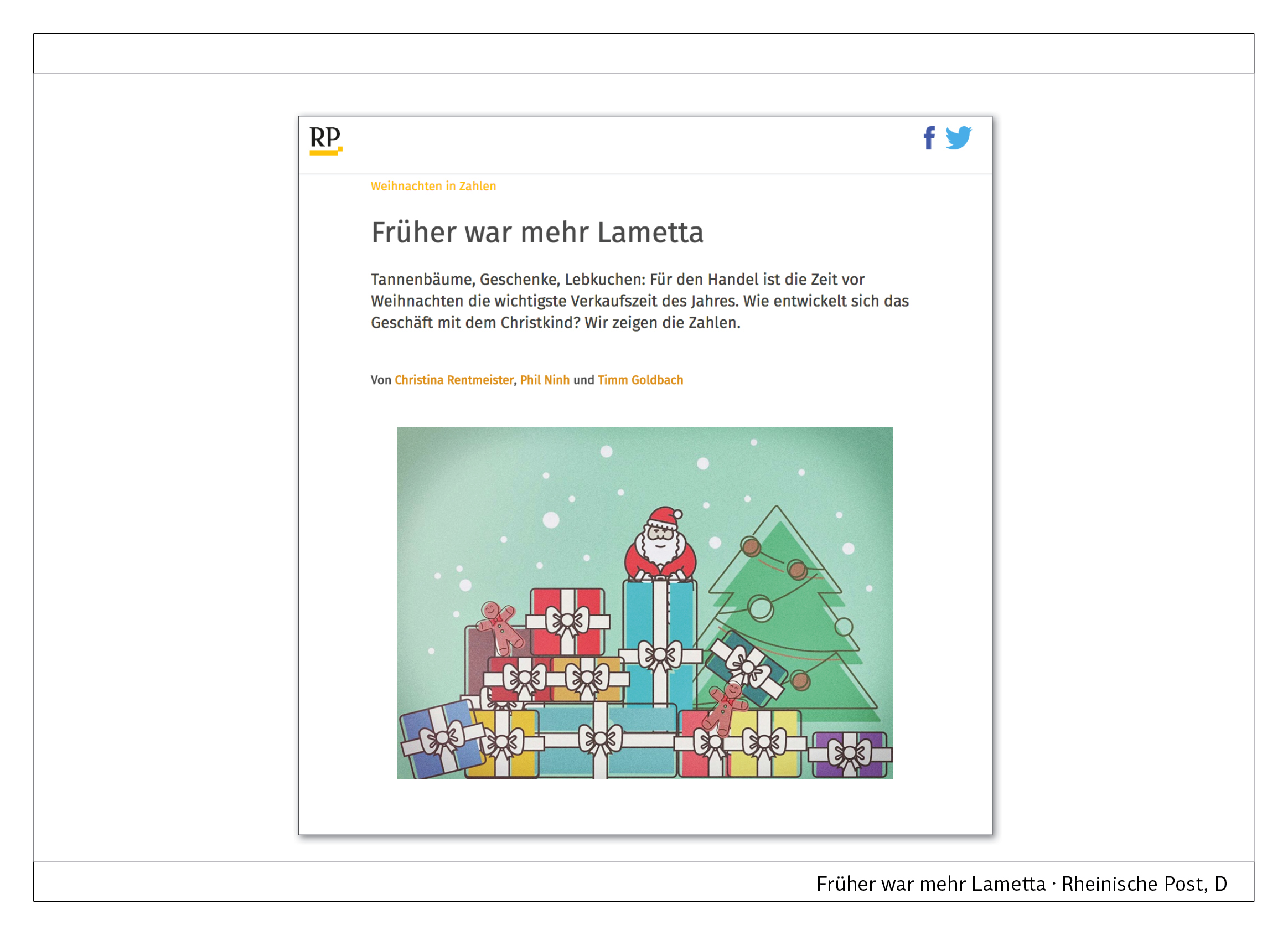
Rheinische Post, D: Früher war mehr Lametta. Im Vorspann heißt es: “Tannenbäume, Geschenke, Lebkuchen: Für den Handel ist die Zeit vor Weihnachten die wichtigste Verkaufszeit des Jahres. Wie entwickelt sich das Geschäft mit dem Christkind? Wir zeigen die Zahlen.” Die Story bietet eine interessante Kombination aus animierten Infografiken und passend dazu platzierten Erläuterungen. Zum Projekt geht es HIER.
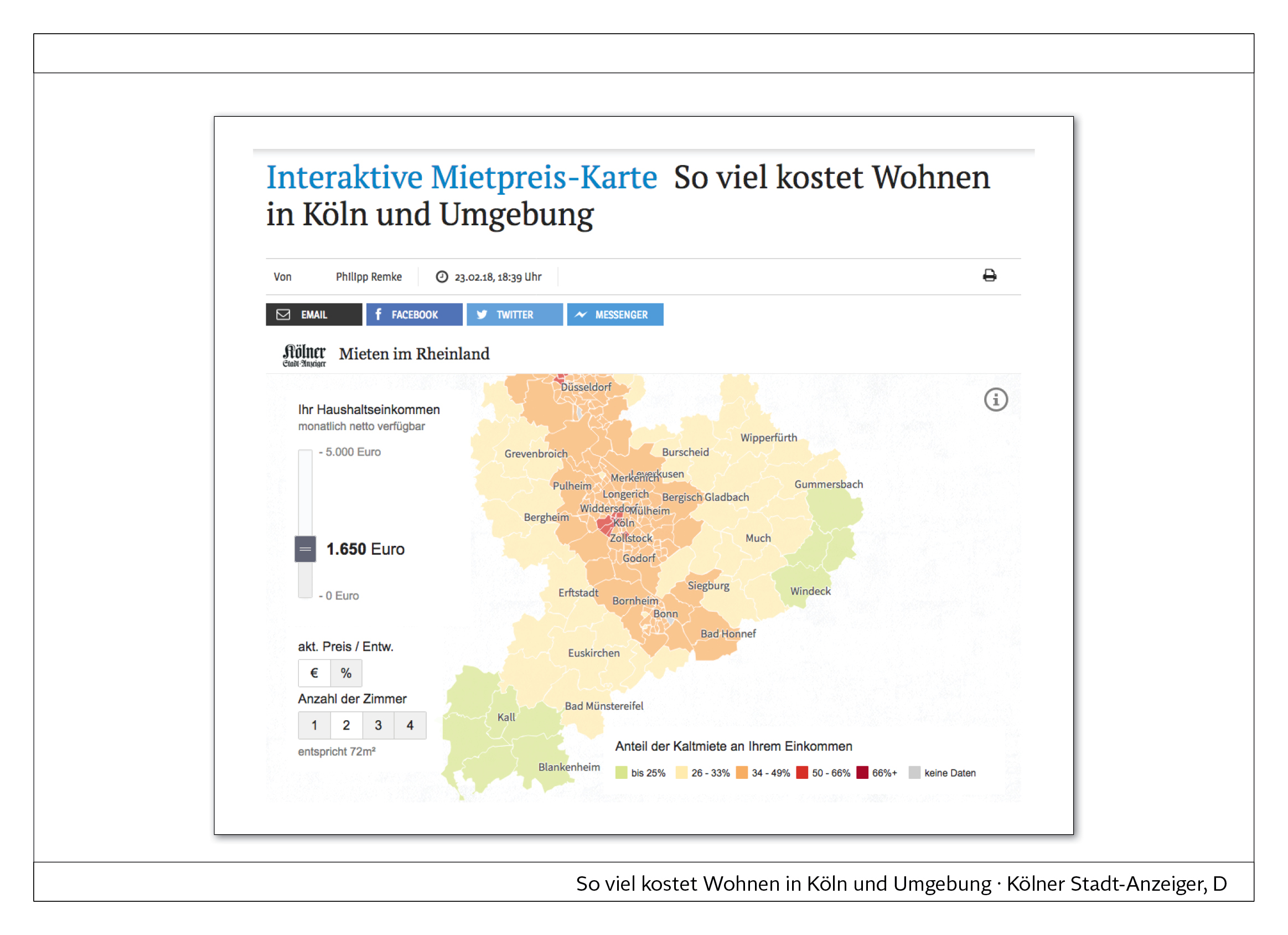
Kölner-Stadt-Anzeiger, D: Interaktive Mietpreis-Karte. So viel kostet Wohnen in Köln und Umgebung. Jury-Mitglied Björn Heselius schreibt: “Die Daten werden intelligent genutzt und Inhalte sehr gut visualisiert. Die Bedürfnisse und Neugier der Nutzer stehen an erster Stelle. Die Navigation ist intuitiv und sehr gut.” Zum Projekt: HIER.
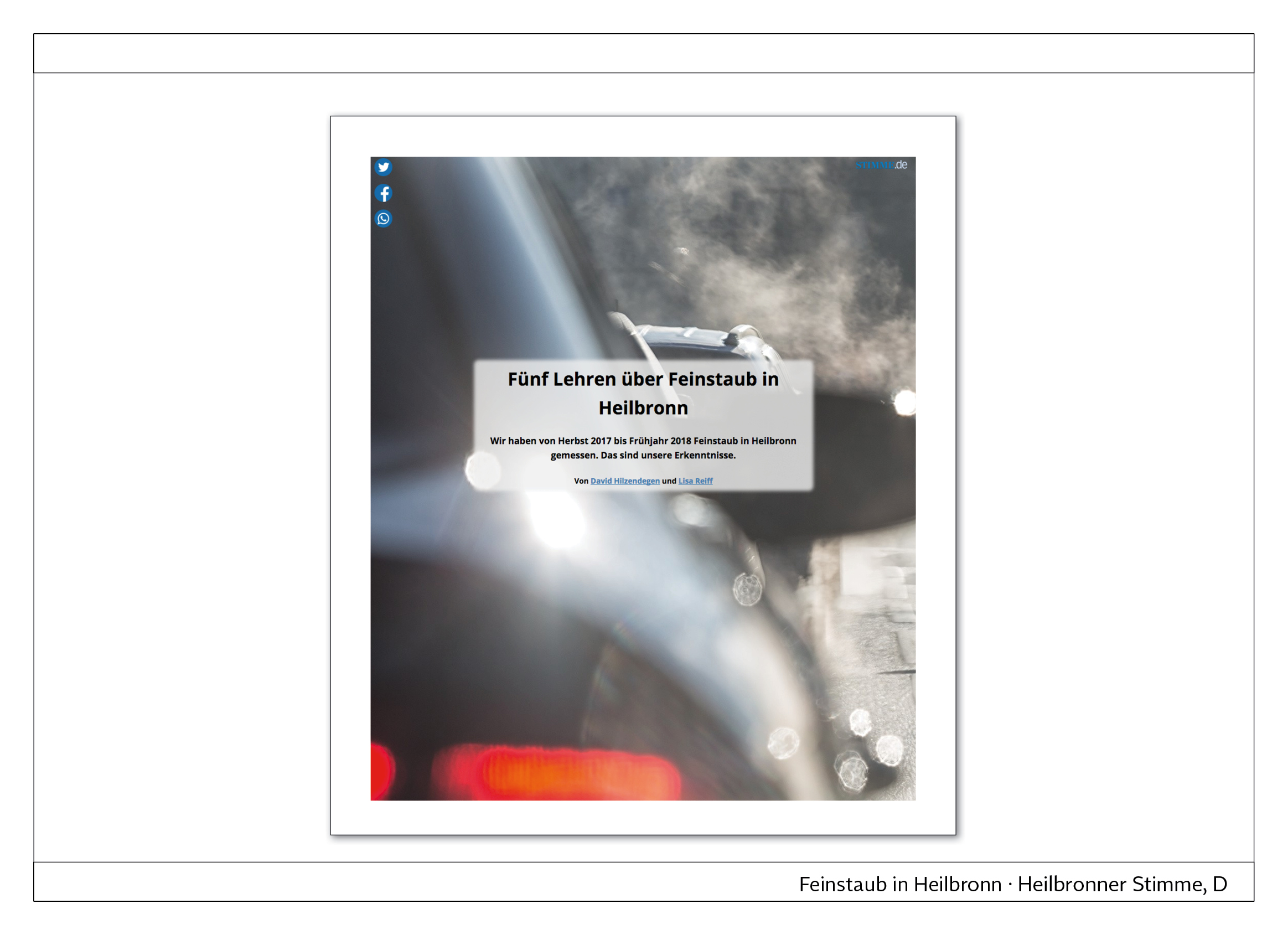
Heilbronner Stimme, D: Fünf Lehren über Feinstaub in Heilbronn. Für das Projekt wurden selbst gebaute Geräte zur Feinstaubmessung verwendet, die in der Stadt verteilt wurden. Die Zeitung wollte den offiziellen Messstationen keine Konkurrenz machen, aber Informationen über zeitlich und örtlich auftretende Feinstaubquellen sammeln. Die Story ist in fünf Punkte gegliedert. Diese beiden fallen besonders auf: 1. Am Wochenanfang gibt es einen deutlichen Peak: Die Luft ist sehr mit Feinstaub belastet, zum Wochenende wird sie besser. 2. Holzofen an, Feinstaubwerte hoch. Auch in verkehrsarmen Vorstädten kann man hohe Feinstaub-Konzentrationen messen, nämlich wenn offene Kamine betrieben werden. Insgesamt sehr klare, übersichtliche Gestaltung. Gutes Verhätnis von Text und Abbildungen, gute Gliederung. Zum Projekt geht es HIER.

Stuttgarter Nachrichten, Stuttgarter Zeitung, D: Feinstaubradar. Im Vorspann heißt es: “Mit dem Feinstaubradar können Bürgerinnen und Bürger in der ganzen Region Stuttgart stündlich überprüfen, wie viel Feinstaub in der Luft ist – vor ihrer Haustür.” Die Story wird begleitet von vier Artikeln, die Hintergründe liefern: 1. So messen wir Feinstaub. Fast 750 Sensoren liefern Daten – wir bereiten sie auf. 2. 45 Ideen für das Feinstaubradar. 3. So basteln Sie Ihr eigenes Messgerät. 4. Feinstaub – der Faktencheck. Was ist Feinstaub, Wo kommt er her? Was kann man tun? Insgesamt ein sehr aufwändiges Projekt, das permanent fortgesetzt wird. Herausragender Service für die Leserinnen und Leser. Die Story finden Sie HIER.
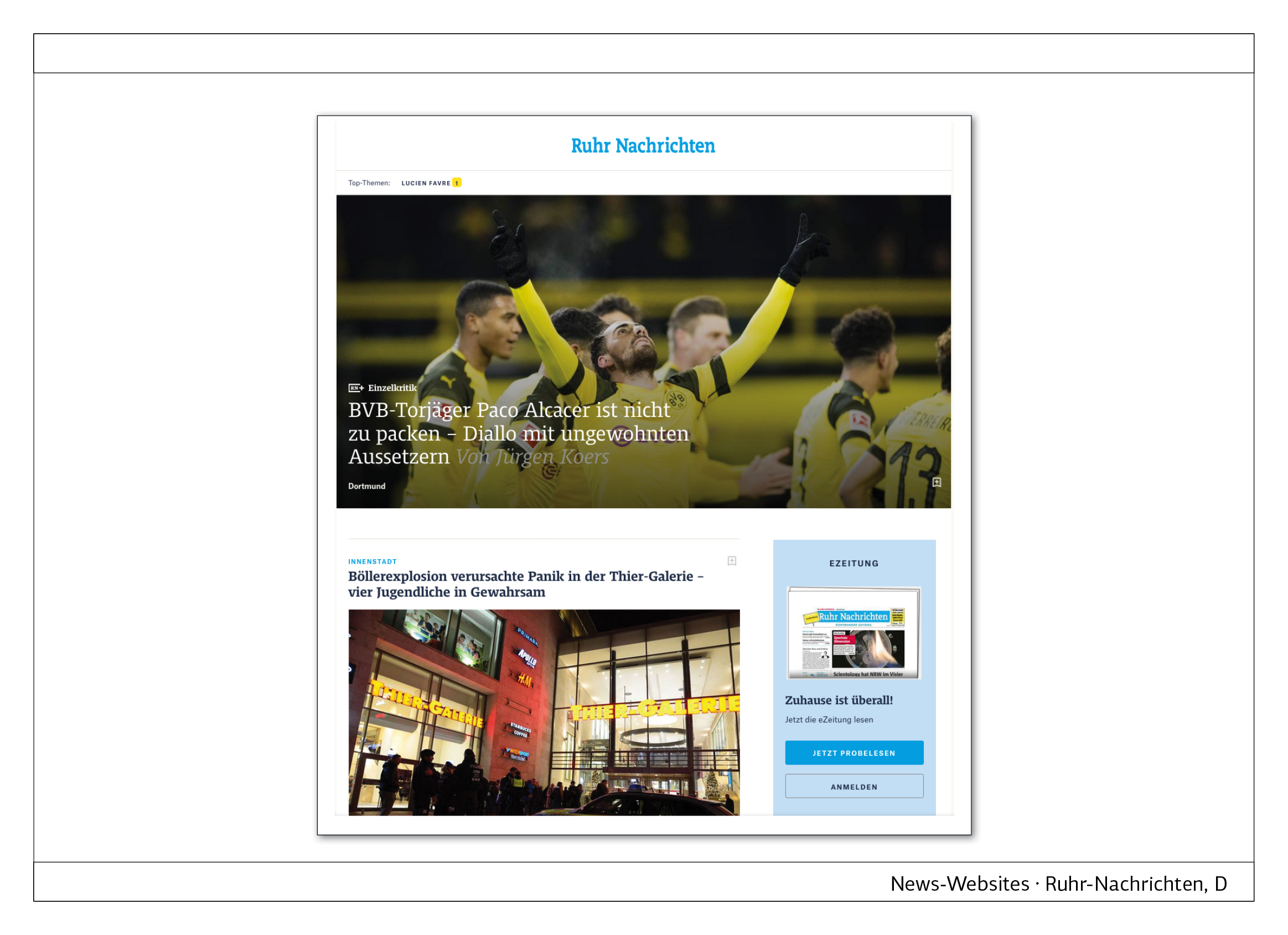
Ruhr-Nachrichten, D: Die Website wurde neugestaltet und ist sowohl für das Smartphone wie für den Bildschirm sehr gut geeignet. Die Navigation ist einfach und intuitiv. Als Grundschrift wird eine Schrift mit Serifen eingesetzt. Das garantiert eine gute Lesbarkeit und einen seriösen Gesamteindruck. Wenn man die Website auf dem Computer nutzt, ist die oberste Story sehr gut als Coverstory gekennzeichnet, denn das Bild wird über die volle Breite des Bildschirms geführt und die Überschrift steht im Bild. Ein sehr leserfreundliches Detail ist die Angabe der Lesedauer am Anfang des Artikels. https://www.ruhrnachrichten.de/
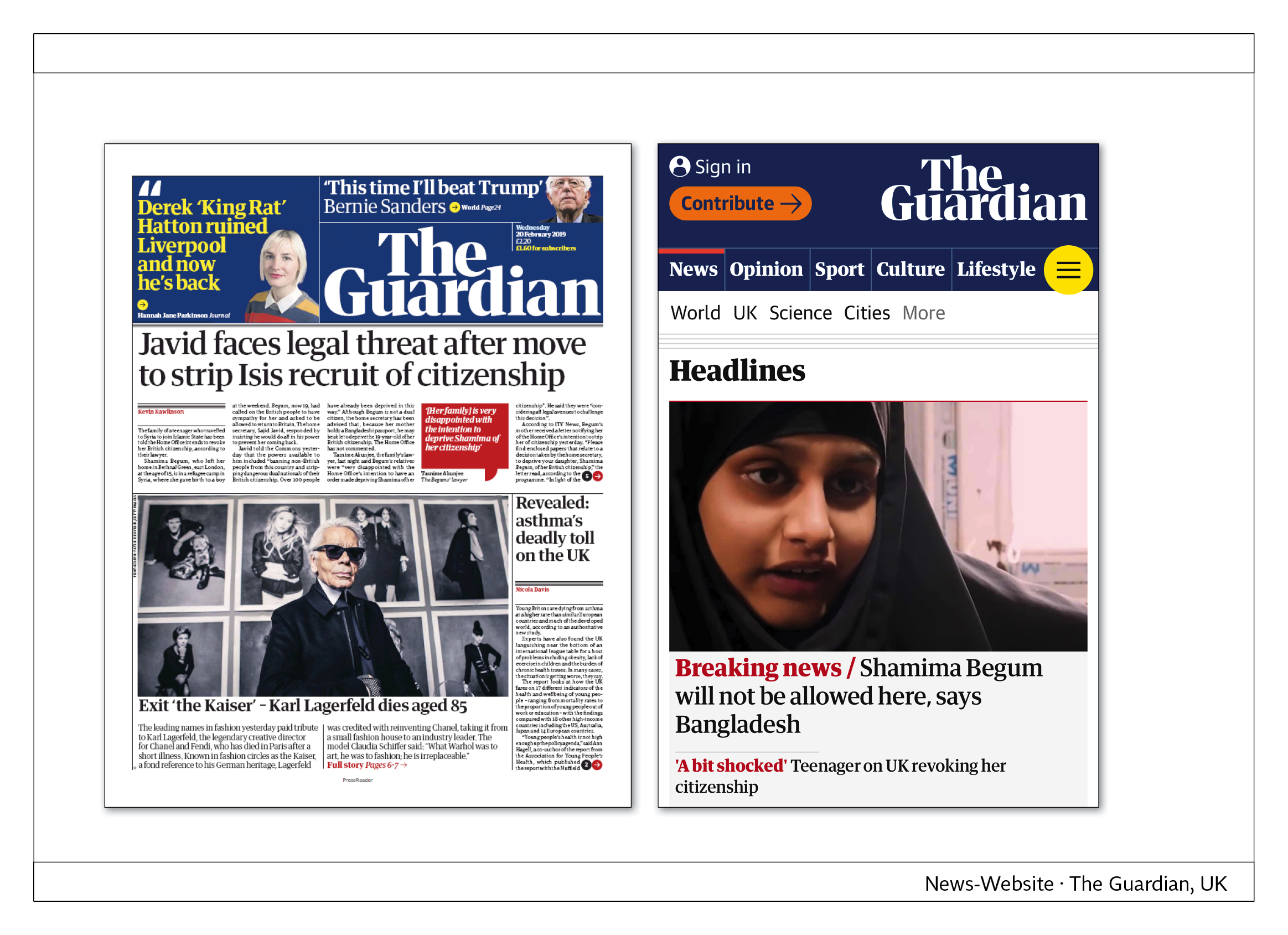
The Guardian, GB: Diese Website ist nicht im Wettbewerb. Es ist aber ein sehr gutes Beispiel für crossmediale Typografie. Links ist die Titelseite Print, rechts die Startseite Online: Die Farben und die Typografie sind identisch. Der Guardian setzt schon seit einigen Jahren eine eigene Hausschrift ein, die für ein unverwechselbares Erscheinungsbild sorgt. https://www.theguardian.com/international
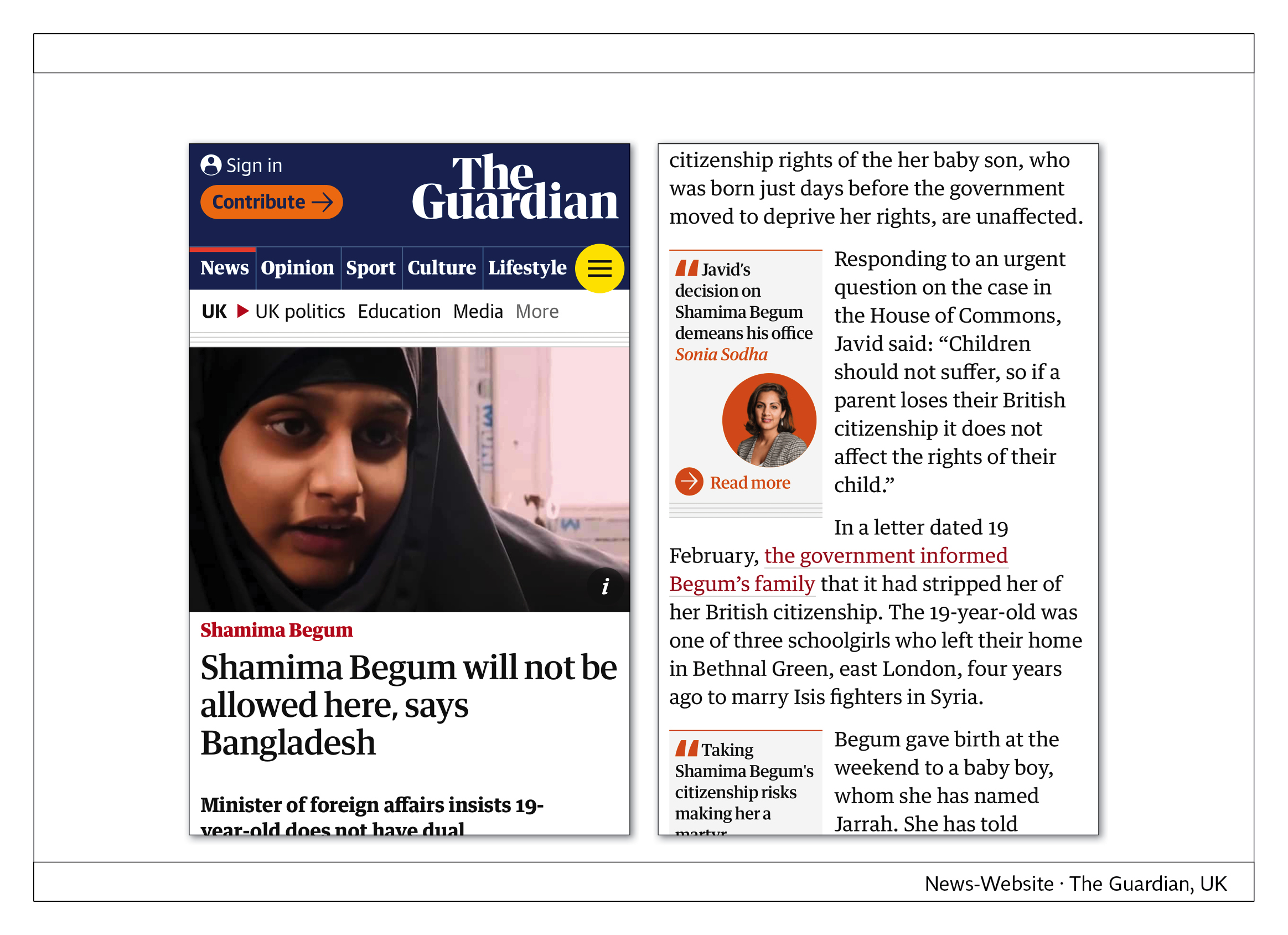
The Guardian, GB: Ein Artikel startet normalerweise mit einem Bild, wie hier gezeigt. Danach folgt die Überschrift mit einem Stichwort. Zwei Featueres sind besonders interessant: 1. Auf dem Smartphone hat der Text links eingeschobene Zitate, die oft zu Hintergrund-Themen führen. Der Grundtext läuft rechts vorbei. In englischer Sprache ist das kein Problem, denn die Worte sind viel kürzer als beispielsweise im Deutschen 2. Auf dem Smartphone kann man die Grundschriftgröße stufenlos verändern und an seine Bedürfnisse anpassen. Das ist bei den meisten News-Websites nicht möglich. https://www.theguardian.com/international
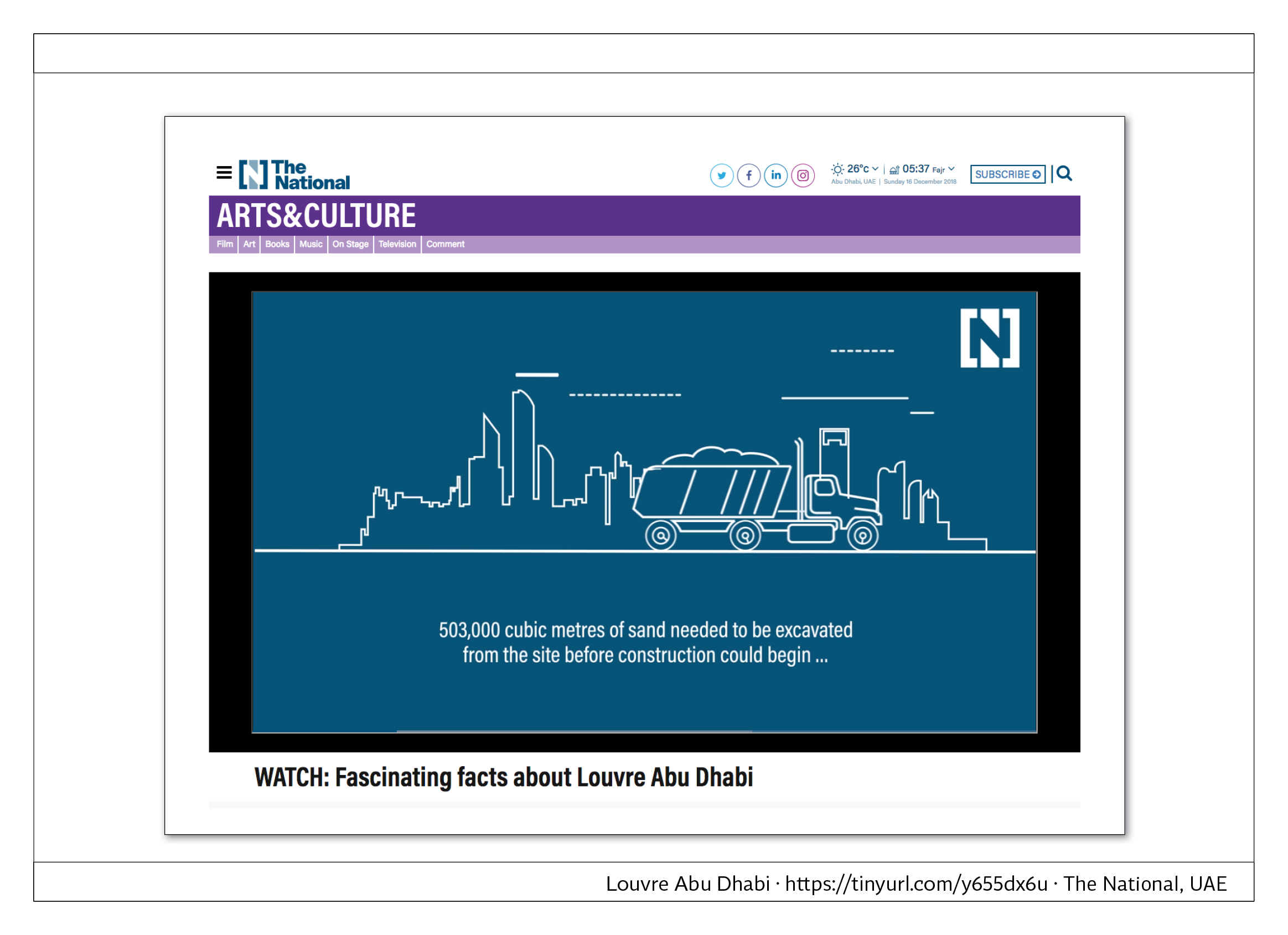
The National, UAE: Faszinierende Fakten über den Louvre Abu Dhabi. Die Zeitung aus den Vereinigten Arabischen Emiraten ist auf den European Newspaper Award aufmerksam geworden und es spricht nichts dagegen, Zeitungen außerhalb Europas teilnehmen zu lassen. Die Jury meinte zu dem Projekt: “Hübscher Animations-Stil. Gute Kombination von Zeichnung und Musik.” In der Tat kommt der Trickfilm ohne Sprache aus. LINK.

Sächsische Zeitung, D: Die kleine Deutsche Einheit. Die Geschichte beginnt im Jahr 1964: Ein Luftballon mit einer Postkarte überquert die innerdeutsche Grenze. Aus einer Brieffreundschaft zwischen zwei Mädchen wird ein Beziehungsgeflecht, das bis heute hält. Die Beteiligten werden interviewt und anhand von eigenen Fotos und von historischen Aufnahmen wird die Story erzählt. Es ist nicht nur die Geschichte von zwei Personen, sondern der kleinen Deutschen Einheit, wie es in der Überschrift ganz richtig heißt, denn historische Ereignisse werden in das Geschehen eingeflochten. Sehr gute Kombiantion aus Drohnenaufnahmen, gesprochenen Texten und authentischen Interview-Szenen. http://tinyurl.com/y22p755j
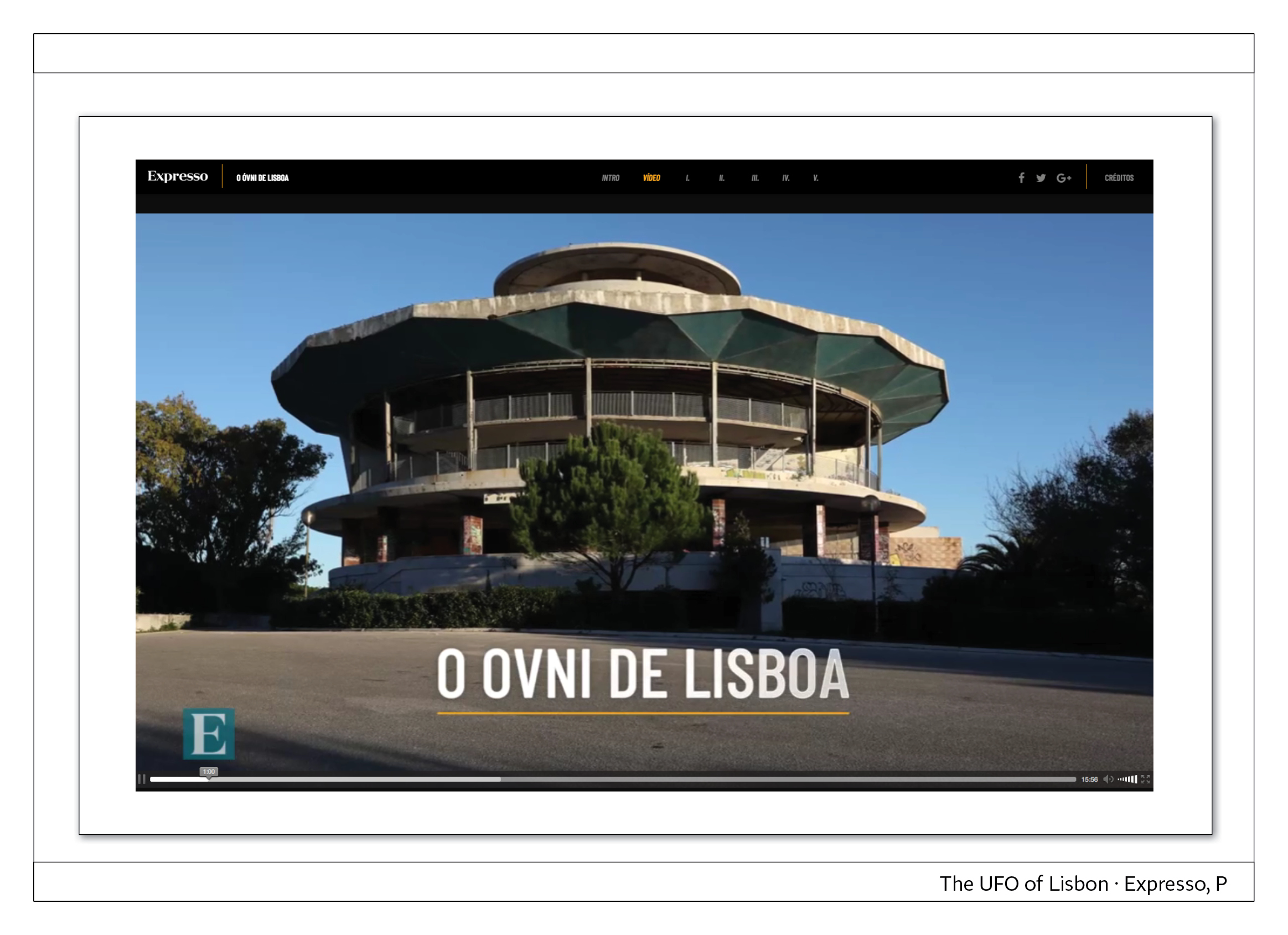
Expresso, P: Das UFO von Lissabon. Die Jury schreibt zu diesem Projekt: “Schöne Details beim Storytelling. Es wird das komplette Toolkit benutzt: 360-Grad-Videos, Drohnen, Zeitleiste, Fotos und Illustrationen. Man könnte annehmen, dass man es mit all diesen Werkzeugen übertreibt, aber die Bildsprache verbindet alles miteinander.” Zum Projekt geht es HIER.
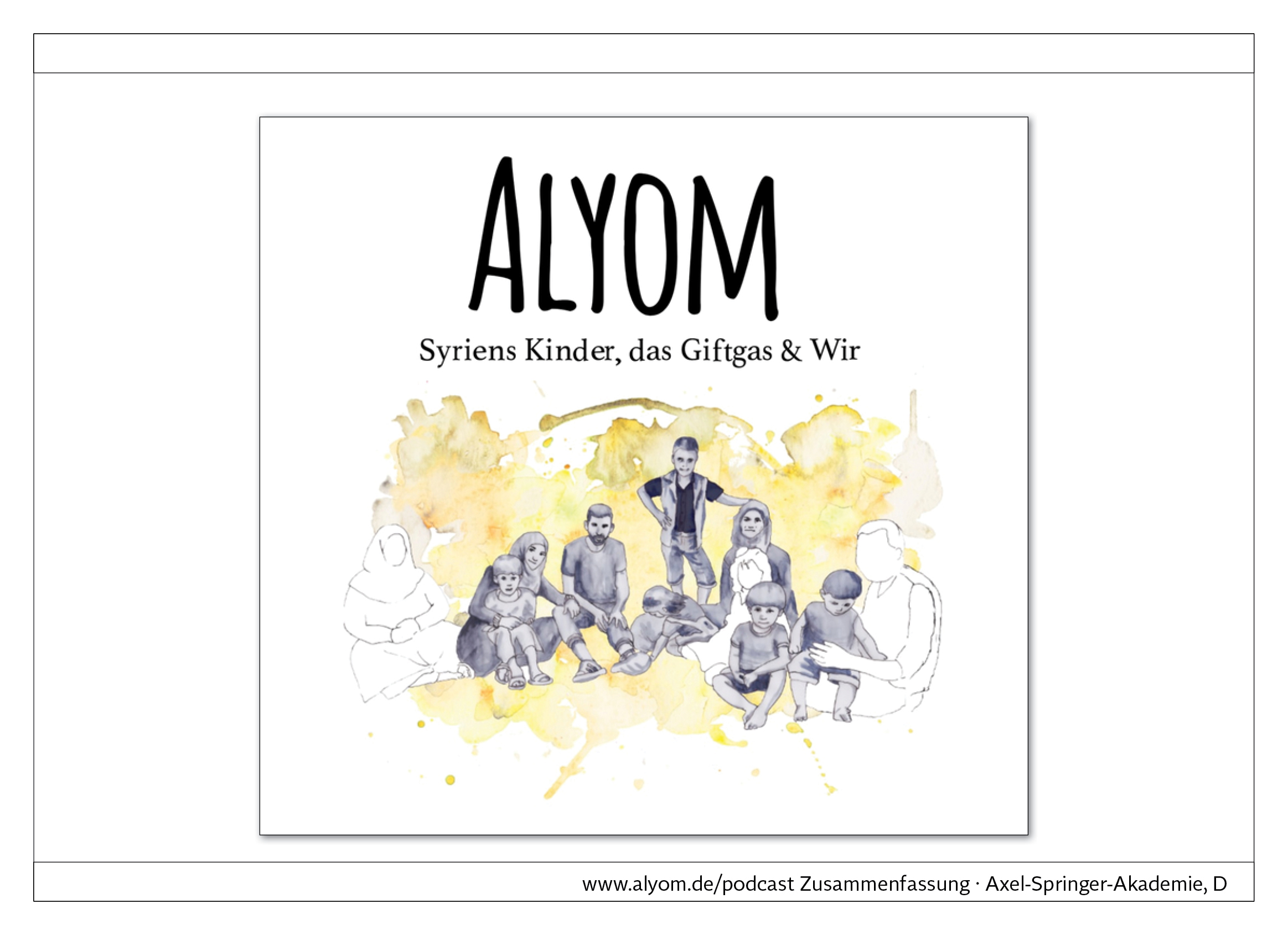
Axel-Springer-Akademie, D: Alyom. Syriens Kinder, Giftgas & Wir. Jurymitglied Professoer Joachim Blum schreibt dazu: „Jedes Jahr bin ich begeistert von den Projekten der Axel-Springer-Akademie. In diesem Jahr heißt es ‘Alyom – Syriens Kinder, das Giftgas & Wir’. Es ist einfach großartig. Zu hören sind neun eindringliche Audiobeiträge über den grauenvollen Giftgas-Einsatz in Syrien. Für ein internationales Publikum sind alle Audios zusätzlich auch in englischer Sprache mit englischen Begleittexten. Das ist vorbildlich.“ www.alyom.de/podcast/zusammenfassung
Kontakt
Norbert Küpper, Veranstalter des European Newspaper Award, Gutenbergstraße 4, 40670 Meerbusch, Telefon 0 21 59 91 16 15, Email nkuepper@newspaperaward.org
Der 20. European Newspaper Award hat 18 Kategorien. Es gibt wie immer Print- und Online-Kategorien. Hier werden ein paar beispielhafte Foto-Reportagen Print und Online aus dem 19. Wettbewerb vorgestellt. Den Call for Entries finden Sie hier: www.newspaperaward.org
Traditionell sind bei Foto-Reportagen skandinavische Zeitungen führend. Das sieht man auch bei den hier gezeigten Beispielen. In Skandinavien werden Text und Bild von jeher als gleichberechtigte Informationsträger gesehen. Im deutschen Sprachraum dominiert dagegen eher der Text. Die Situation hat sich in den letzten Jahren aber gebessert, denn wenn es um Multimedia-Reportagen geht, sind deutschsprachige Zeitungen mit sehr guten Beispielen im Wettbewerb vertreten.
Alle Preisträger des 19. European Newspaper Award finden Sie im Jahrbuch, das auf DVD oder USB-Stick erhältlich ist. Bestellung hier.

Die 18 Kategorien des European Newspaper Award. Rot markiert sind die Online-Kategorien

Politiken, DK. „Es wird ein …“ Mädchen oder Junge. In der kleinen Foto-Reportage werden vier Schwangere gezeigt, die gerade erfahren, ob es ein Junge oder ein Mädchen wird. Gratulation! Und: Eine Foto-Reportage kann tatsächlich nur aus wenigen Bildern bestehen. Wir sehen hier eine komplette Story, die überwiegend mit Bildern erzählt wird. Genau so wird die Foto-Reportage definiert.
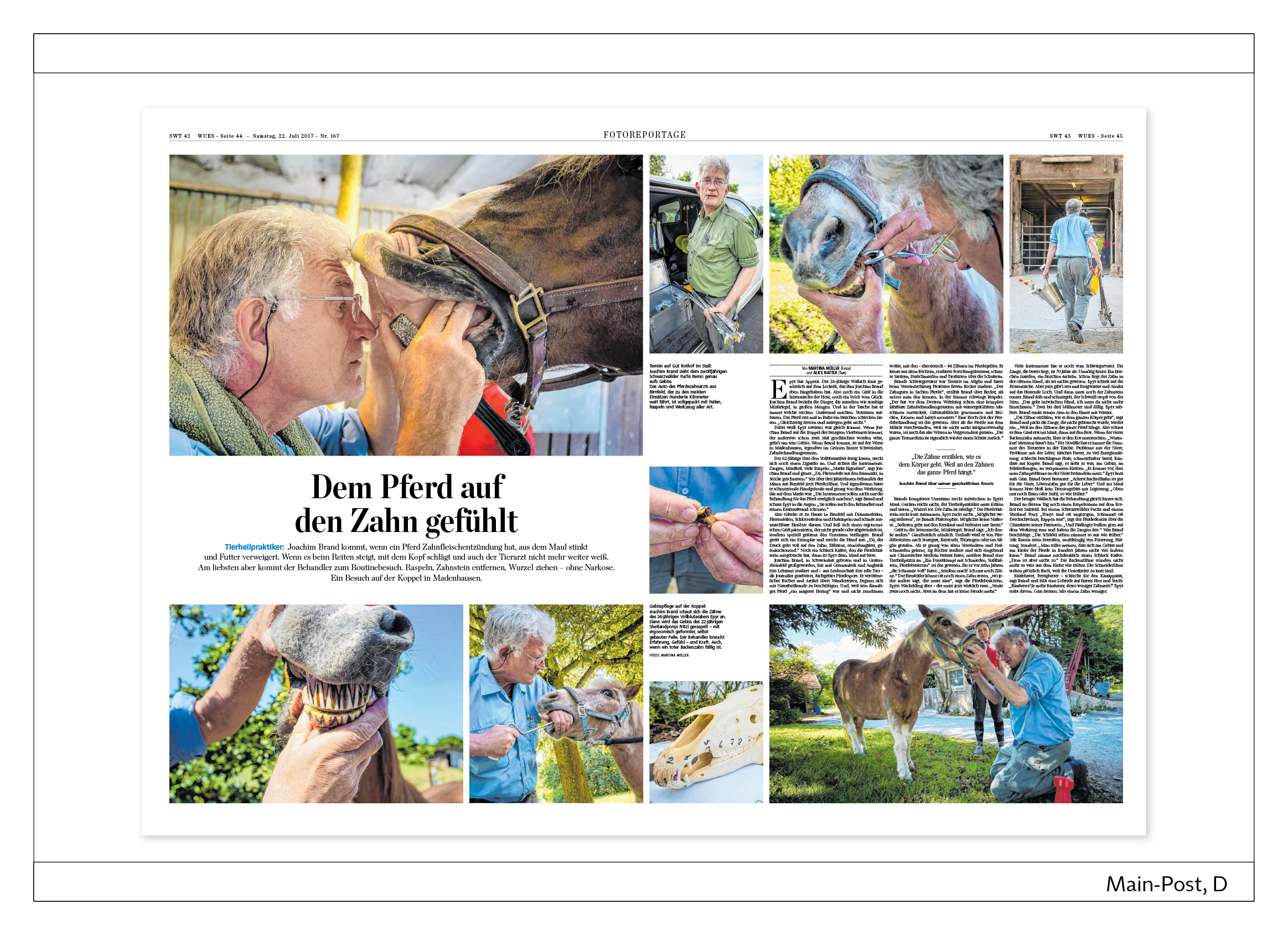
Main-Post, D. Auf der Doppelseite wird ein Tierheilpraktiker und seine Arbeit vorgestellt. Die Überschrift lautet „Dem Pferd auf den Zahn gefühlt.“ Die Bilder sind zu Blöcken arrangiert, wobei durch die Bildgrößen eine klare Hierarchie hergestellt wird.
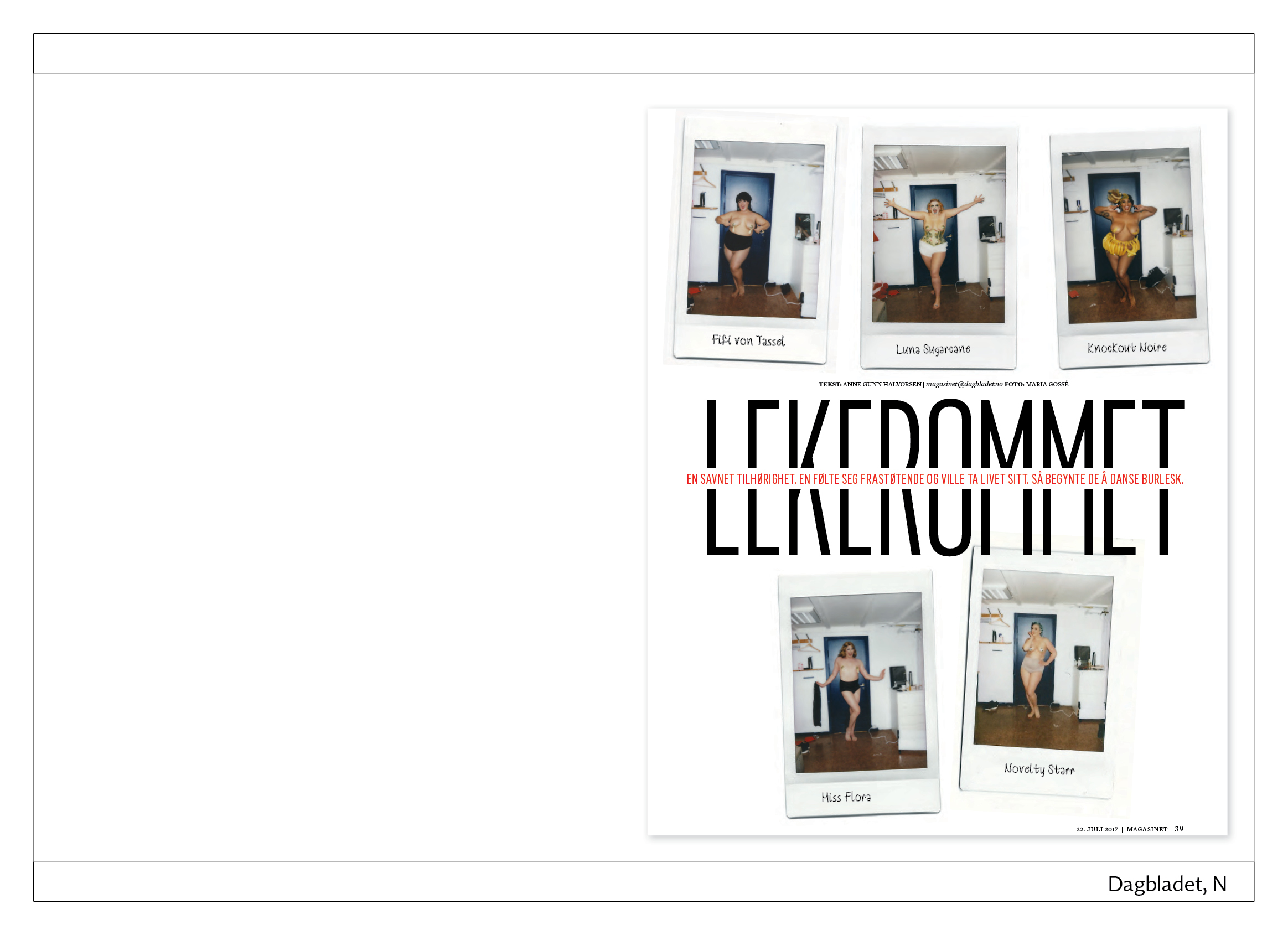
Dagbladet, N. Die Fotografin Maria Gossé folgt der norwegischen Bourlesque-Szene seit 2016. Die Fotos zeigen die Künstlerinnen und Künstler nicht auf der Bühne, sondern in ihrer privaten Umgebung. Die Foto-Reportage hat insgesamt neun Seiten Umfang: die Startseite und vier Doppelseiten.

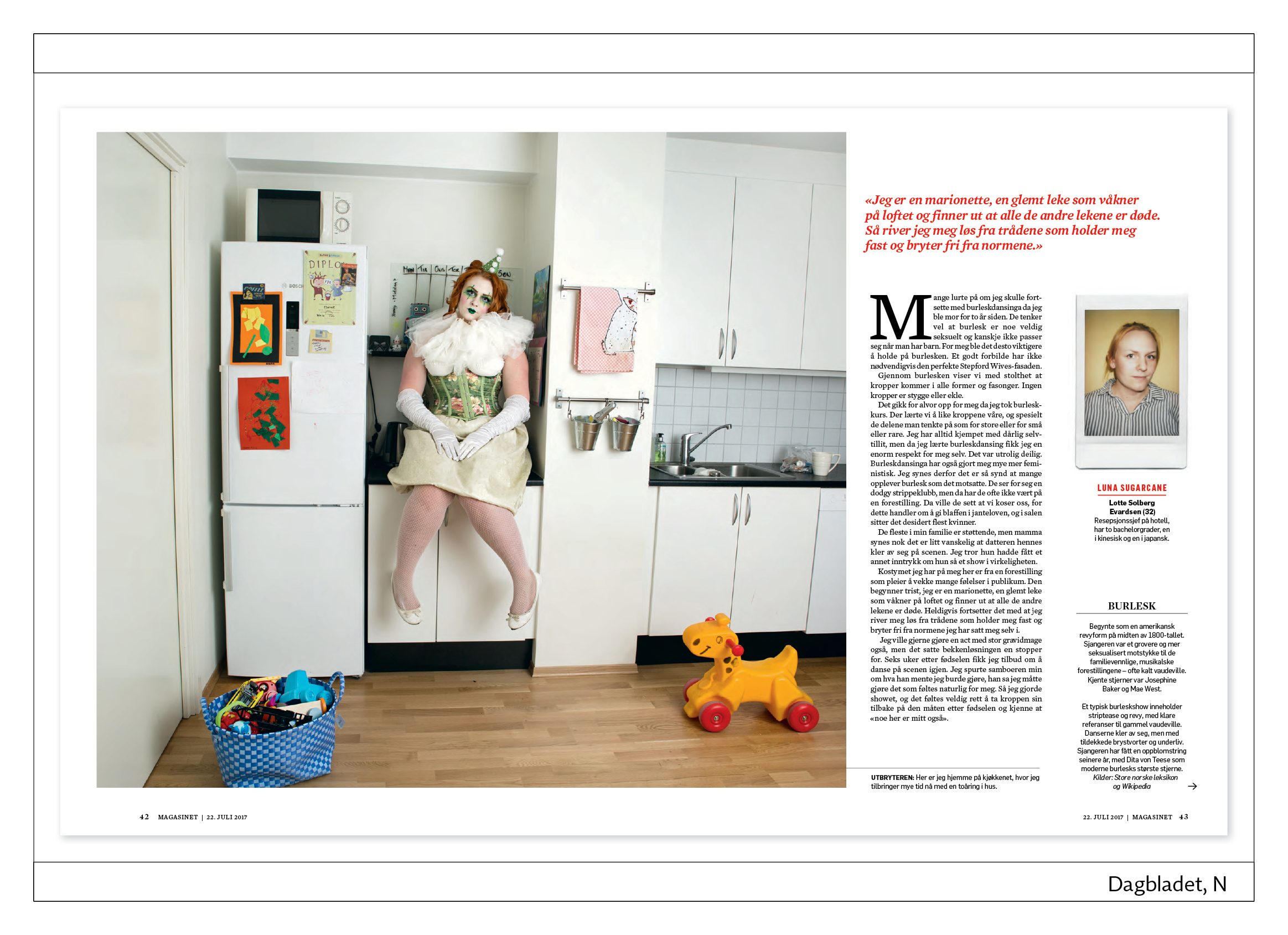
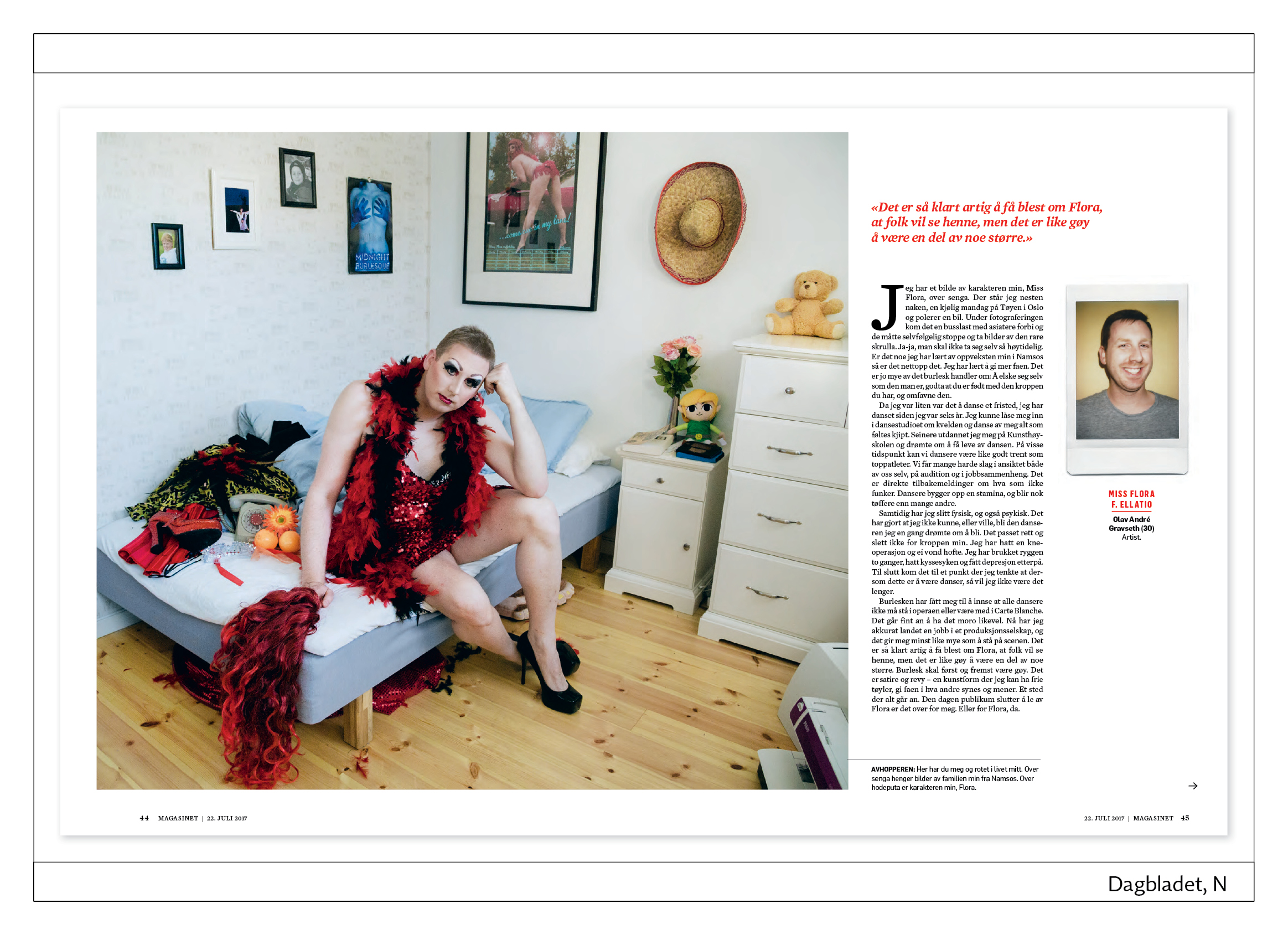
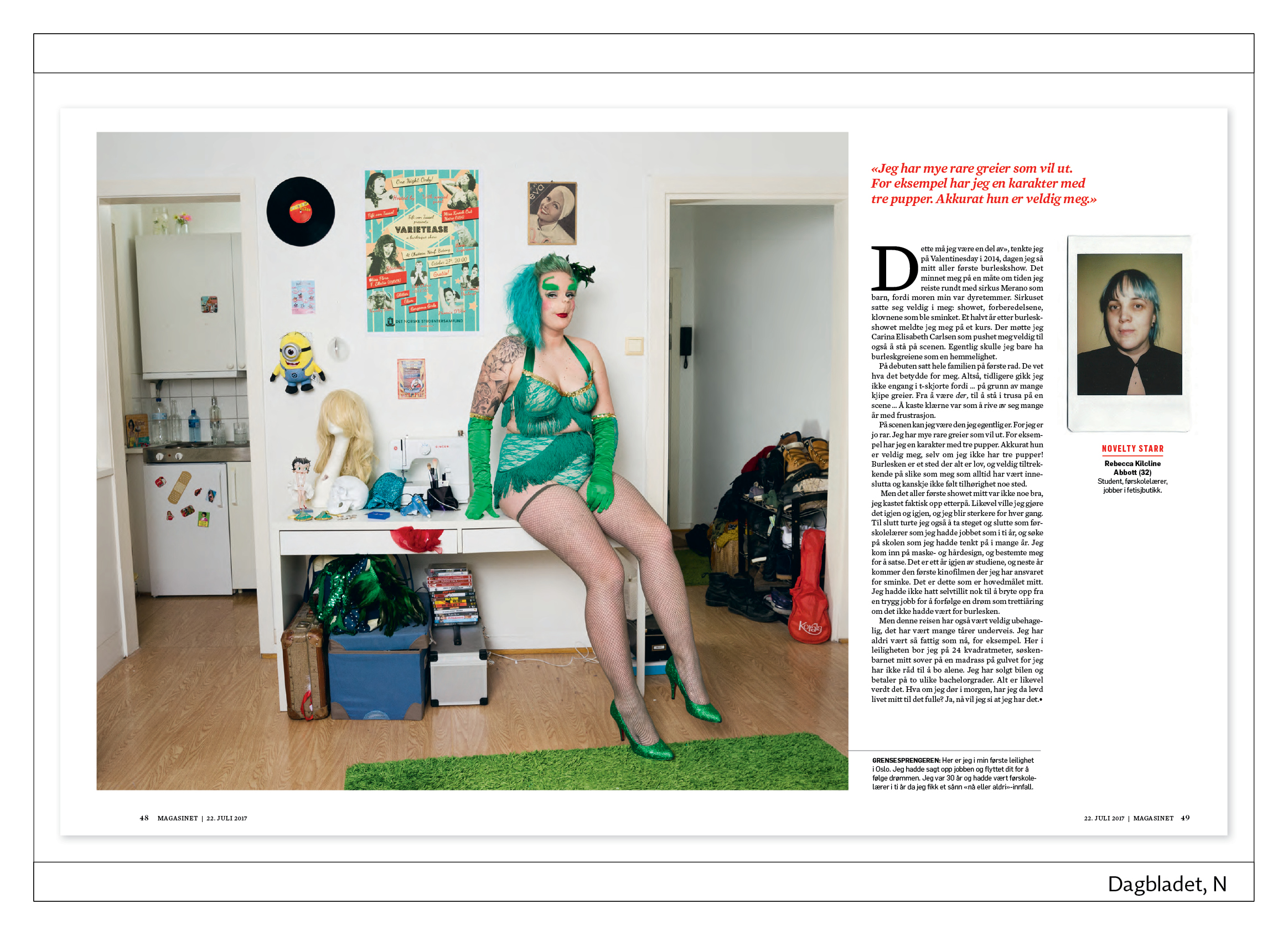
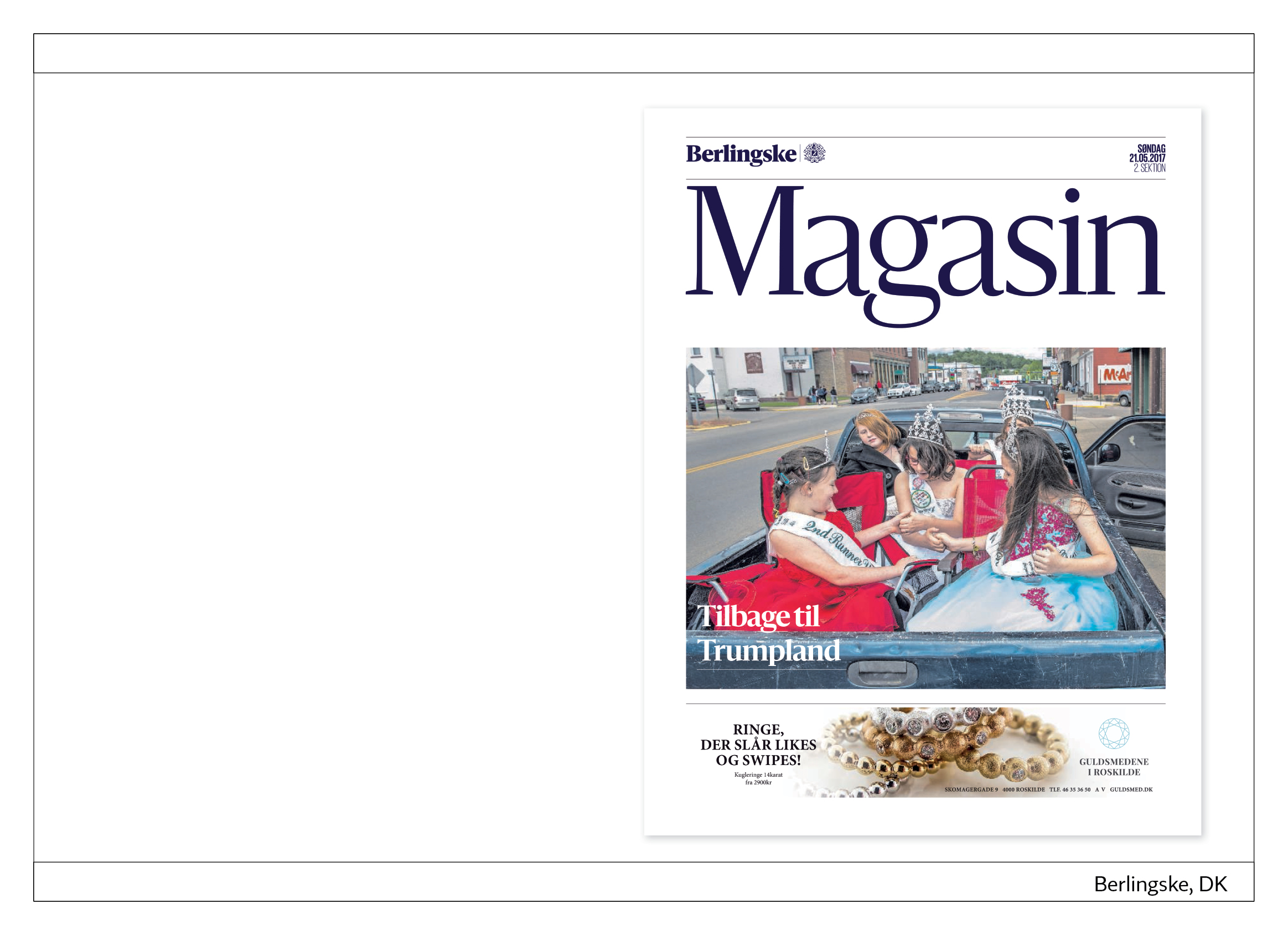
Berlingske, DK. „Hier teilen sie noch Donald Trumps Traum“ lautet die Headline. Im Vorspann heißt es: „Während die liberale Elite Trump für einen gefährlichen Clown hält, sehen Schönheitsköniginnen, Truthahnjäger und arme Leute im Rust Belt den Präsidenten als nationalen Retter.“ Rust Belt bedeutet Rost-Gürtel und bezeichnet die älteste und größte Industrieregion der USA. Die Story wird über vier Doppelseiten geführt.
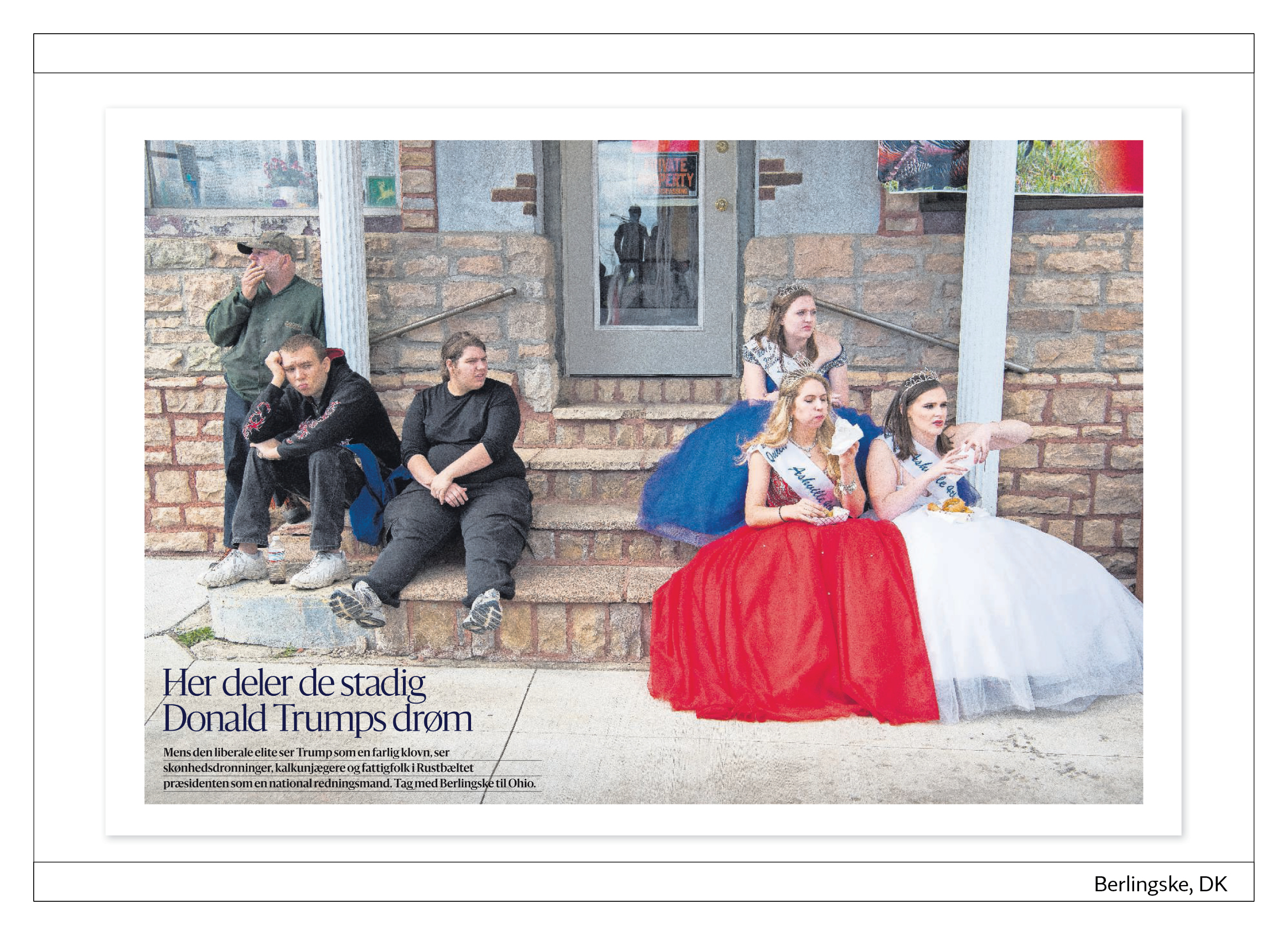
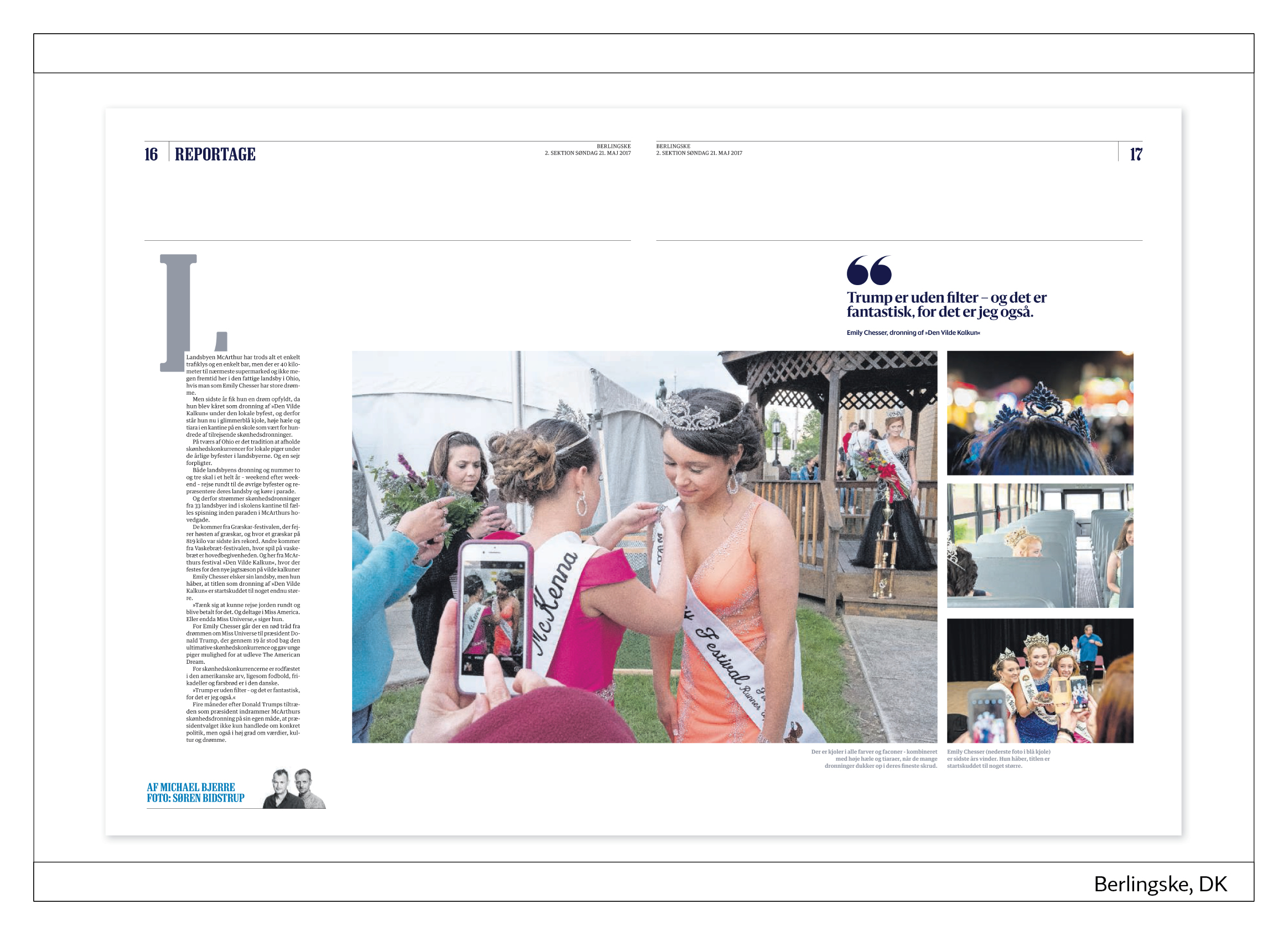
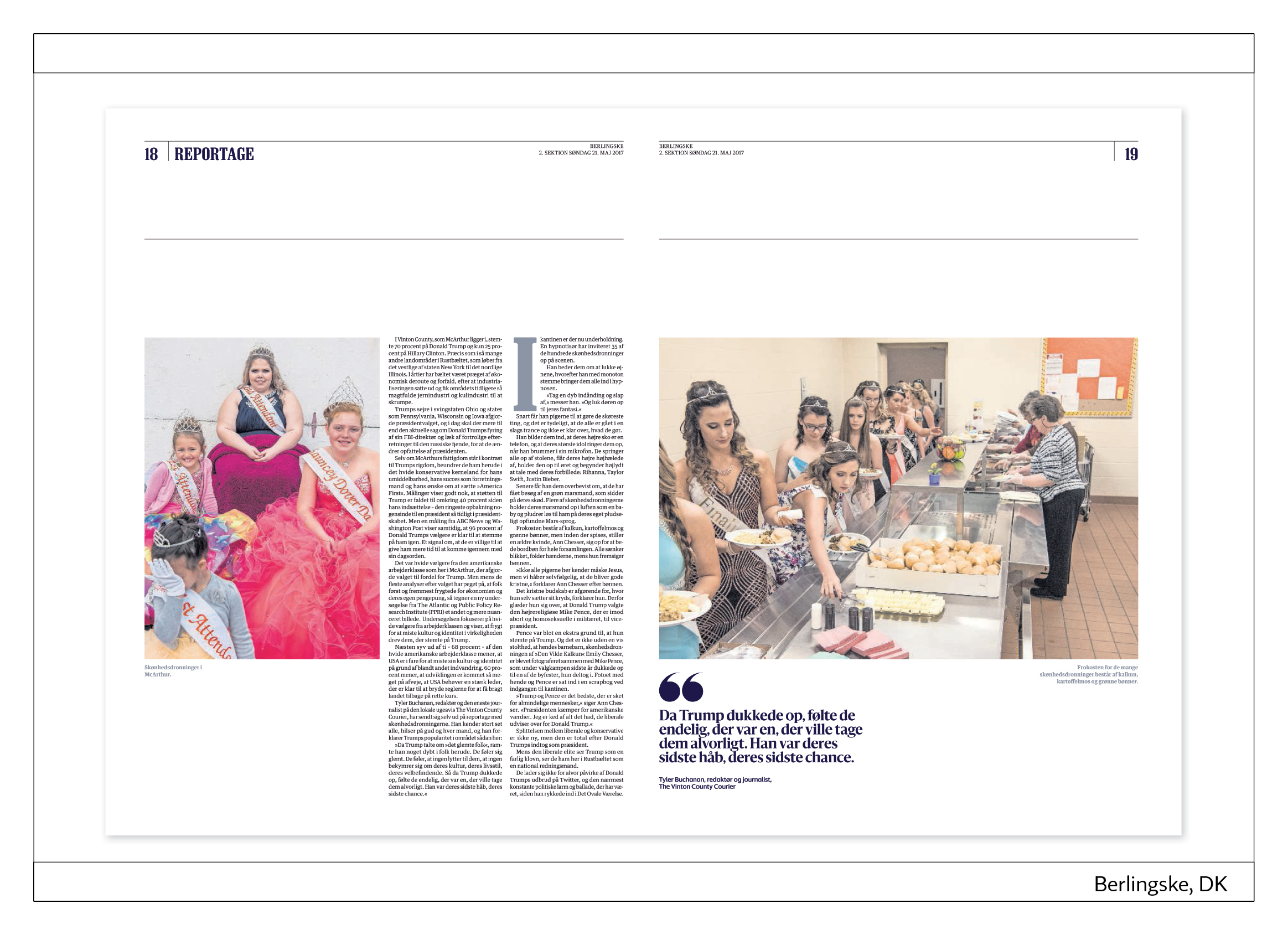
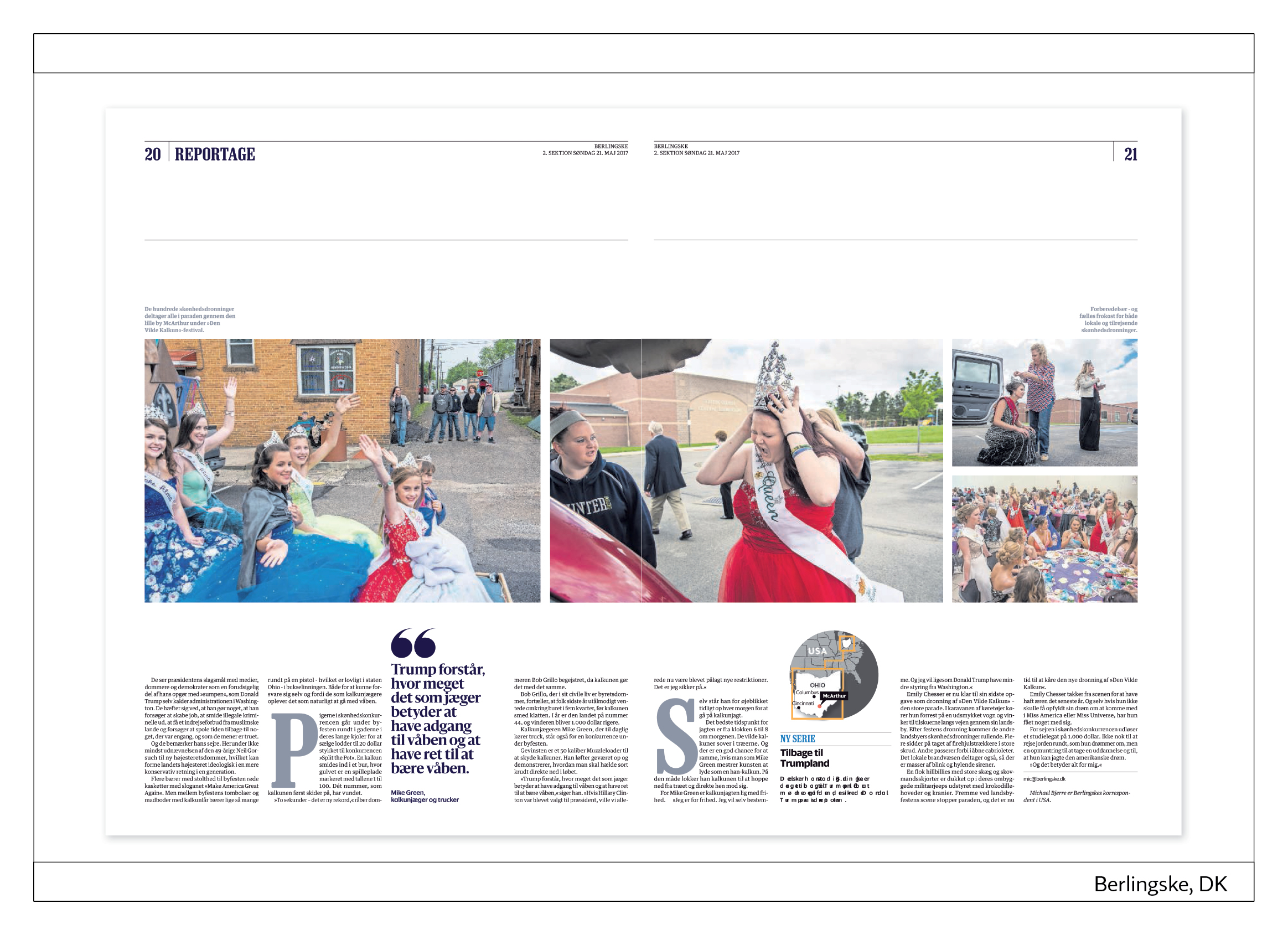
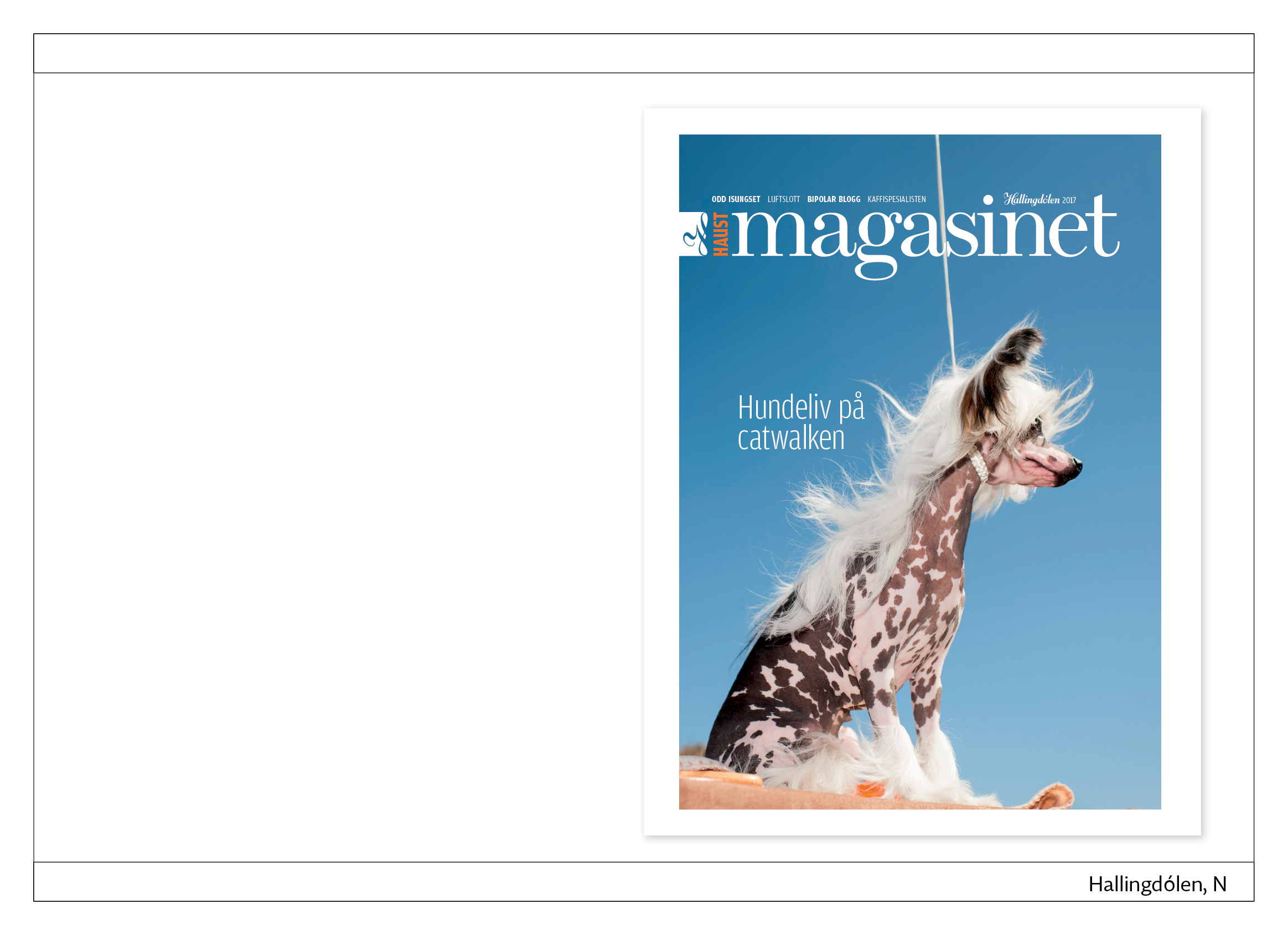
Hallingdølen, N. „Hundeleben auf dem Catwalk“ titelt die Zeitung auf dem Cover der Wochenend-Beilage. Die Foto-Reportage über eine Hunde-Schau wird im Innern über vier Doppelseiten geführt. Durch die Detail-Aufnahmen wird die Atmosphäre der Veranstaltung sehr gut eingefangen. Hallingdølen war im Jahr 2013 “European Newspaper of the Year”. Die Zeitung hat eine Auflage von 8.374 Exemplaren (2017) und erscheint drei Mal wöchentlich.

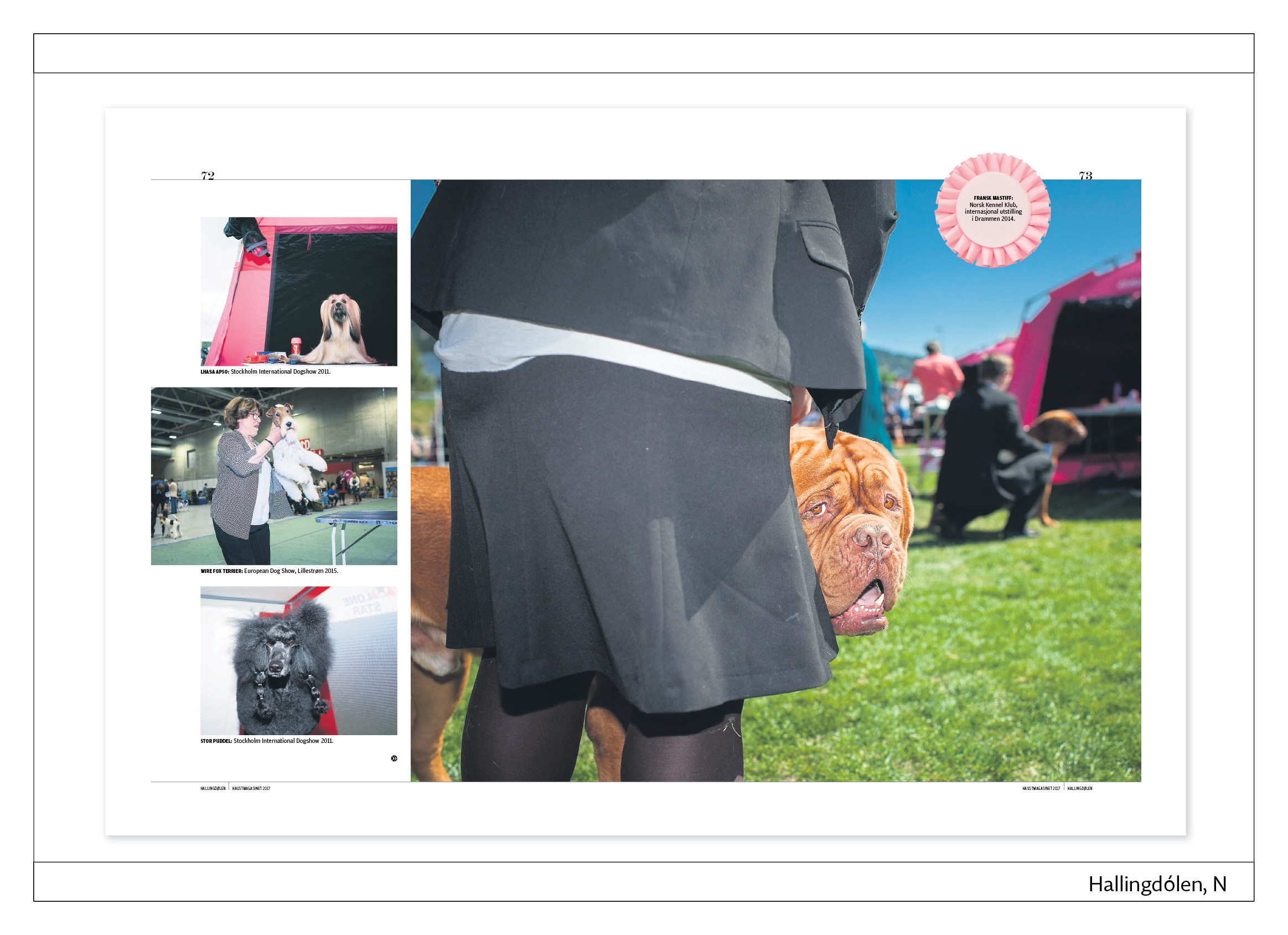
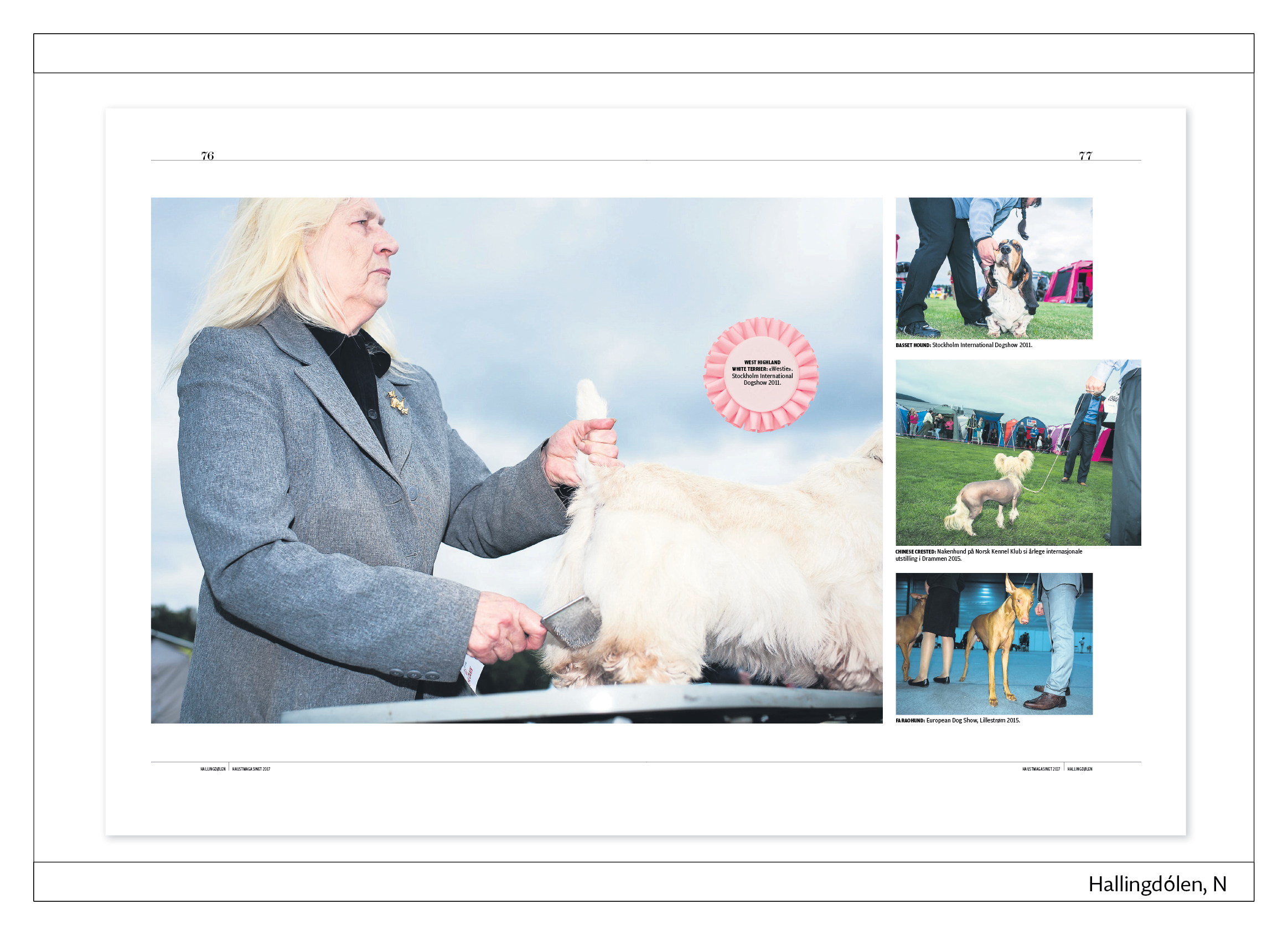
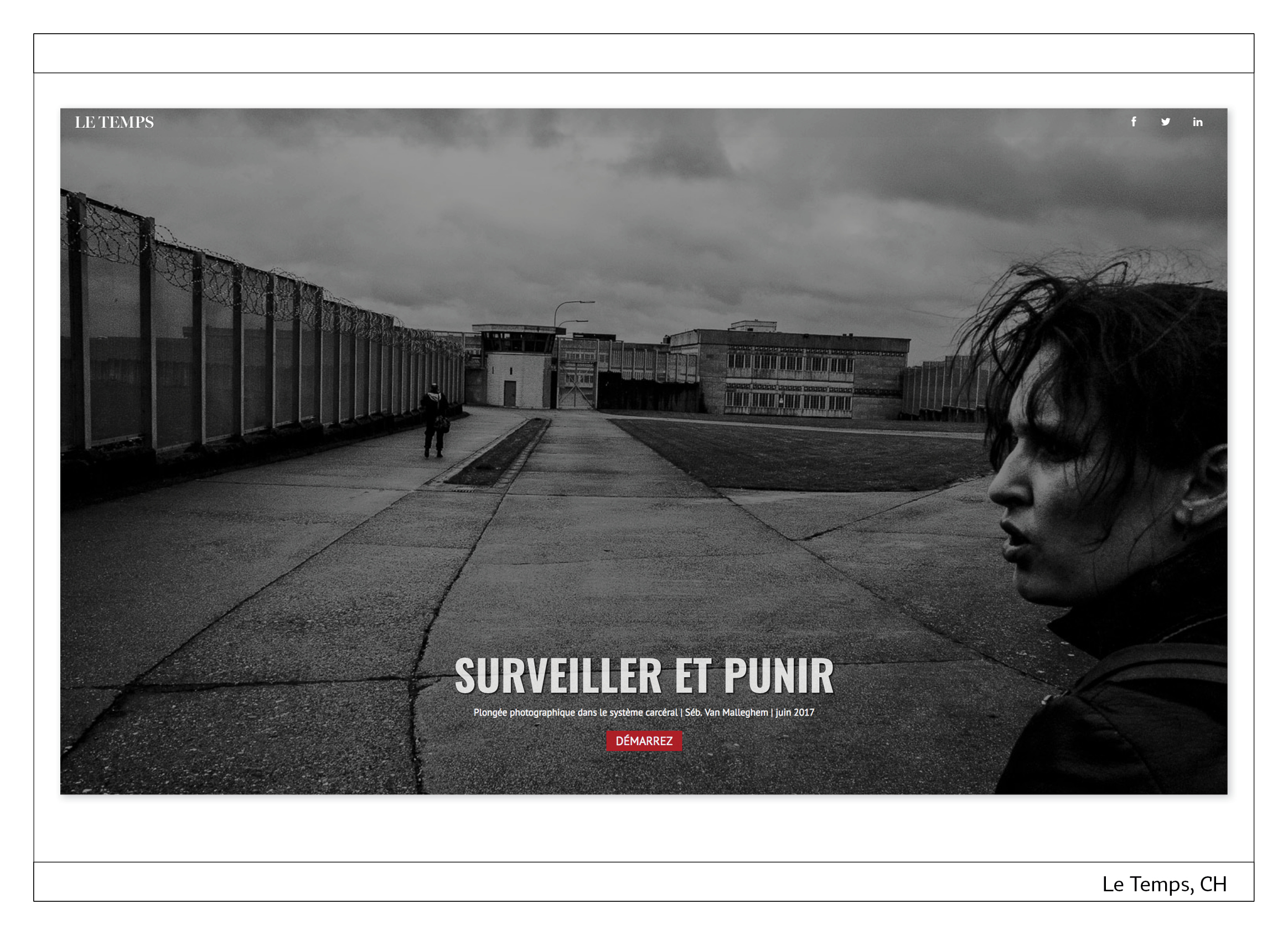
Le Temps, CH. „Surveiller et punir“ – Überwachen und bestrafen – lautet der Titel dieses Projekts. Zwischen 2011 und 2014 hat sich Fotograf Sébastien Van Malleghem in das tägliche Leben von einem Dutzend Gefängnissen in Belgien vertieft, um über die Fehler und den Bankrott des Strafvollzugs in Belgien zu berichten. Die Schwarzweiß-Fotos erzeugen eine düstere Atmosphäre der Hoffnungslosigkeit. Bildtexte, Tondokumente und Seiten mit Zitaten von Gefangenen ergänzen die Fotos. Link zur Story: tinyurl.com/y8ol3sc7
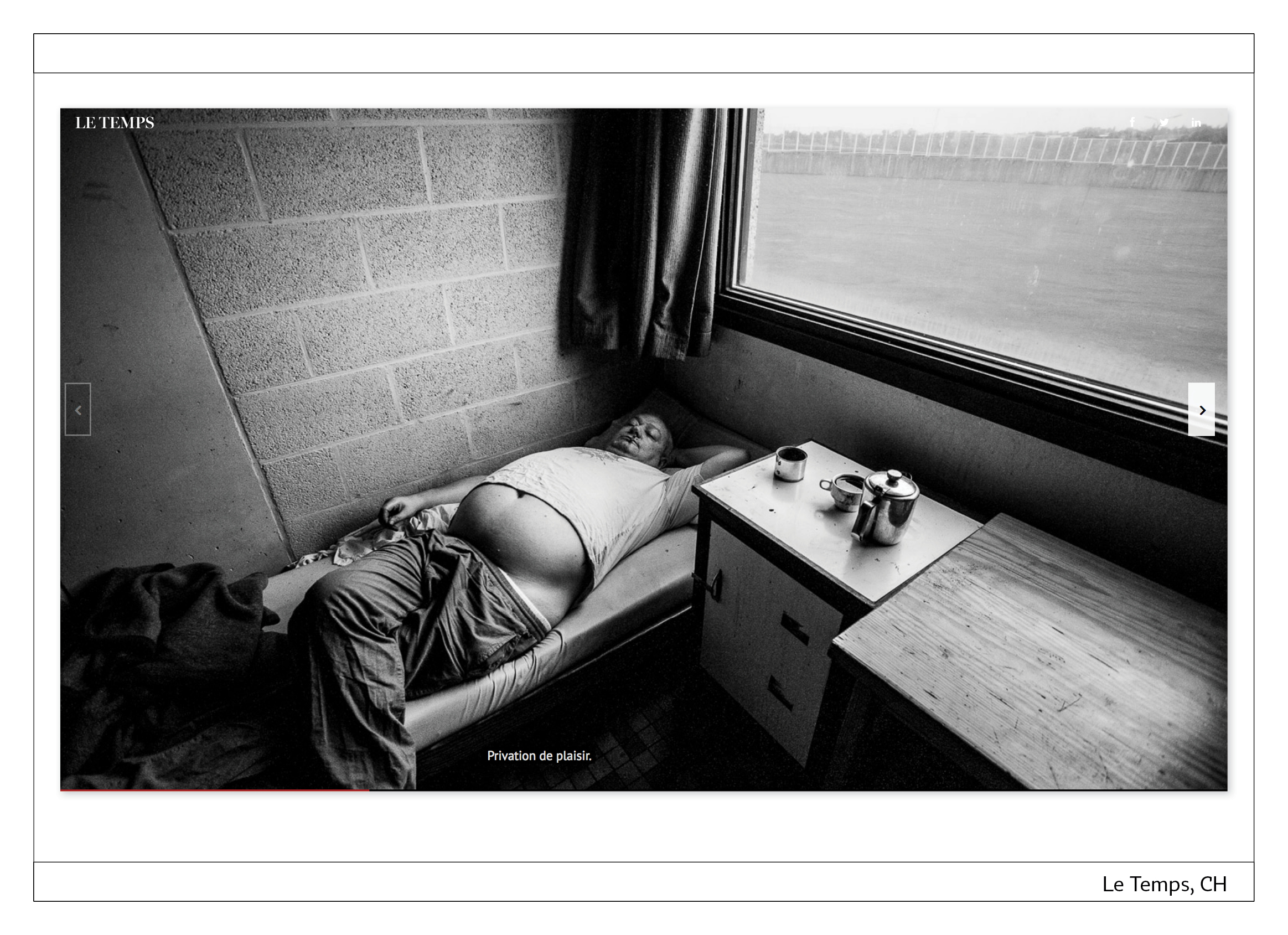
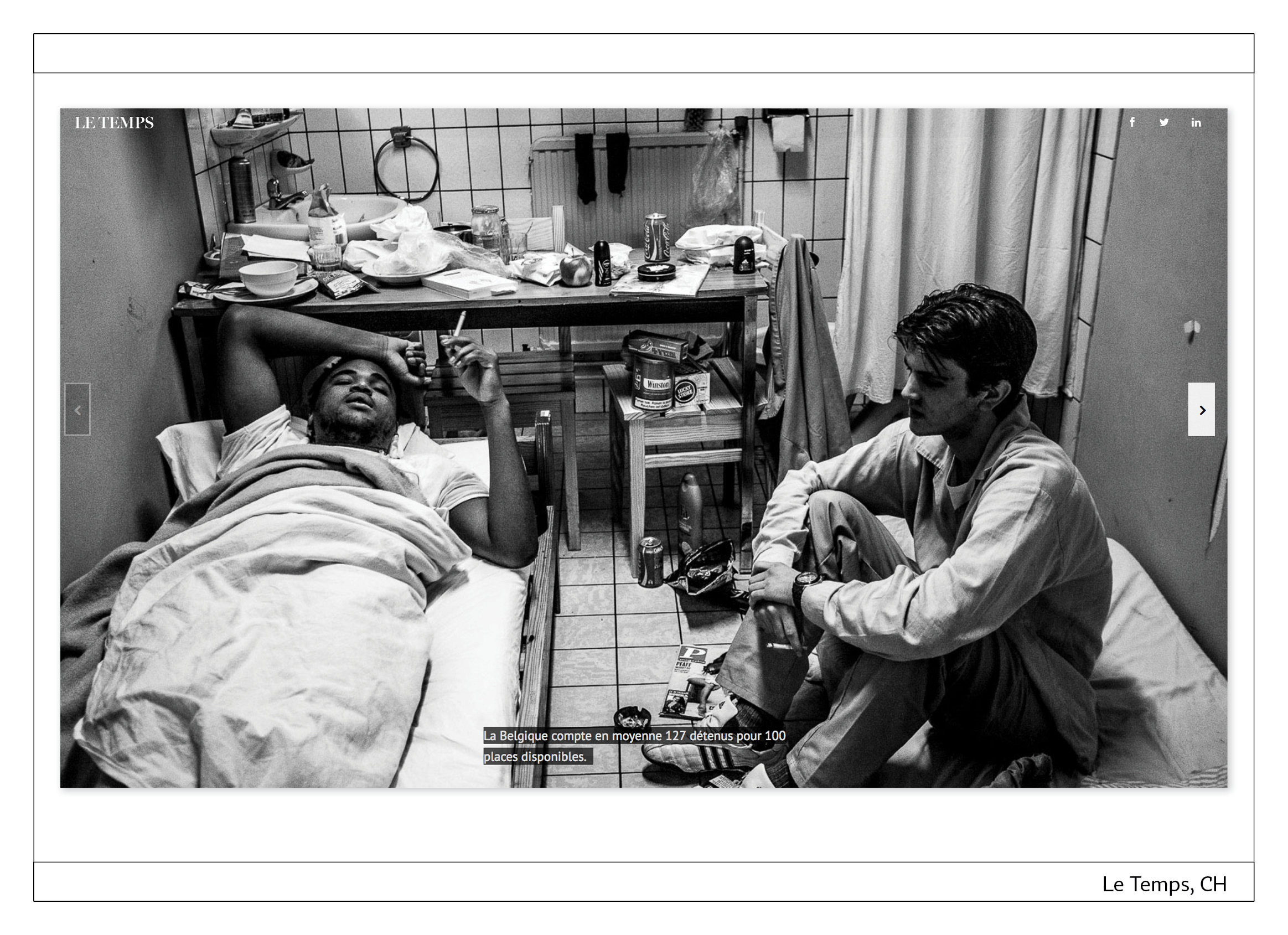
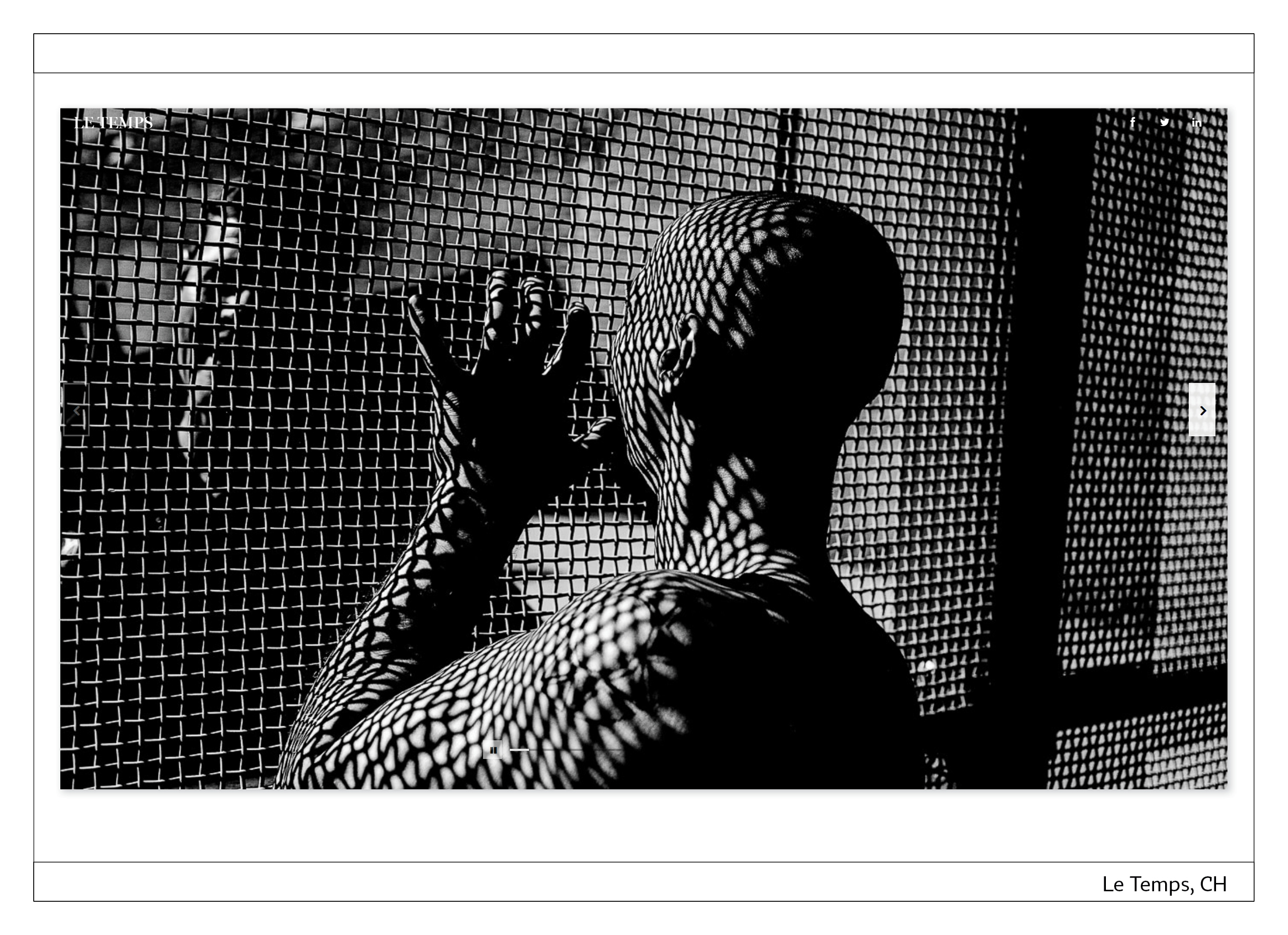
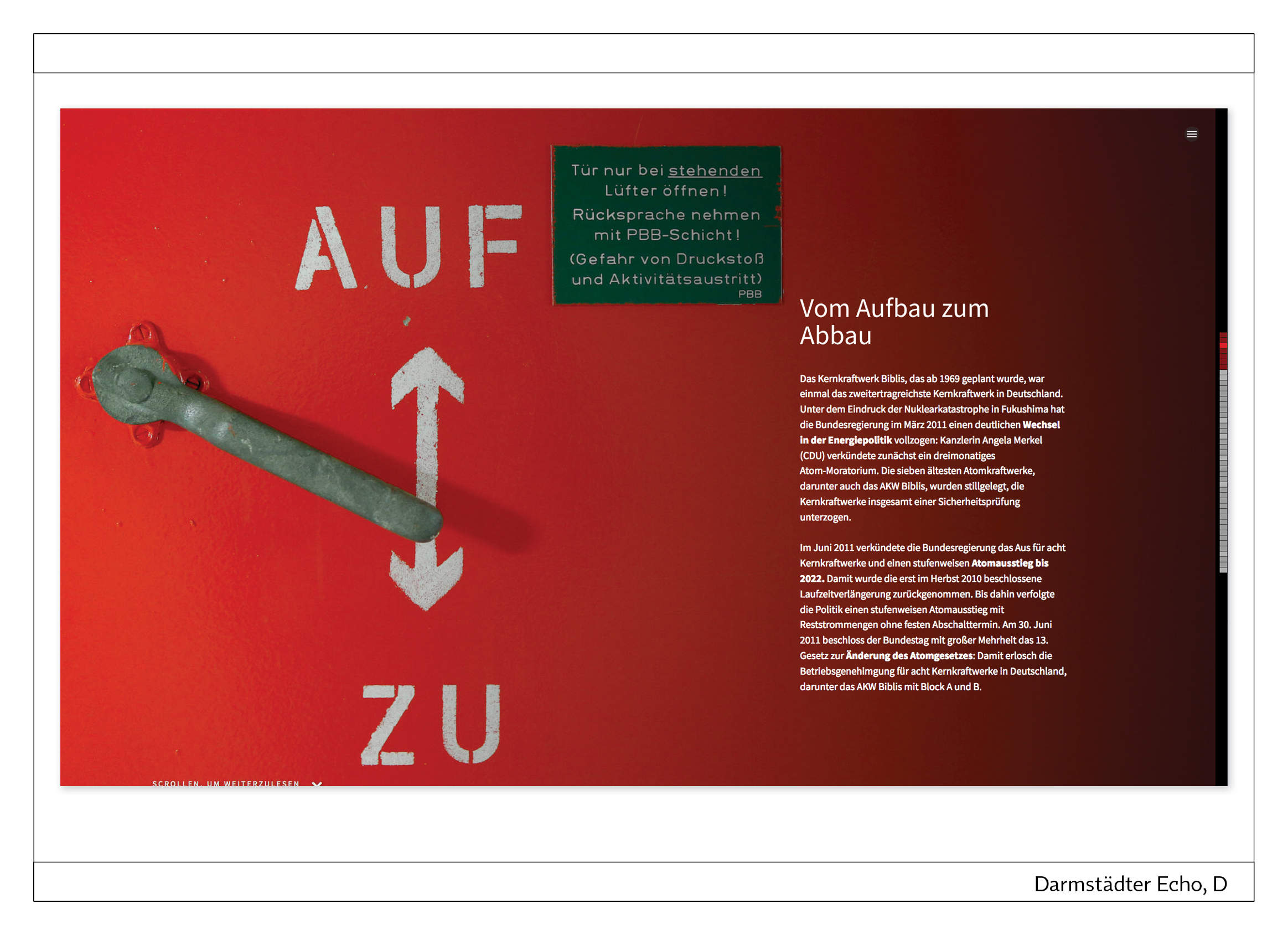
Darmstädter Echo, D. „Biblis. Und jetzt?“: Die Redaktion schreibt zu diesem Projekt: „In Südhessen geschieht etwas, das sich nur sehr selten ereignet und auch in Zukunft nur sehr selten ereignen wird: In Biblis wird ein Atomkraftwerk ‚zurückgebaut’. Wie sieht es überhaupt in so einem Kraftwerk aus? Wie geht so ein Rückbau von statten? Wie sehen die Bibliser diese Entwicklung? Welche Positionen gibt es? All diese Themen werden in der multimedialen Geschichte aufgegriffen.“ Um auf diese Story aufmerksam zu machen, gab es eine achtseitige Beilage in der gedruckten Zeitung. Link zur Story: tinyurl.com/ycoubgfr
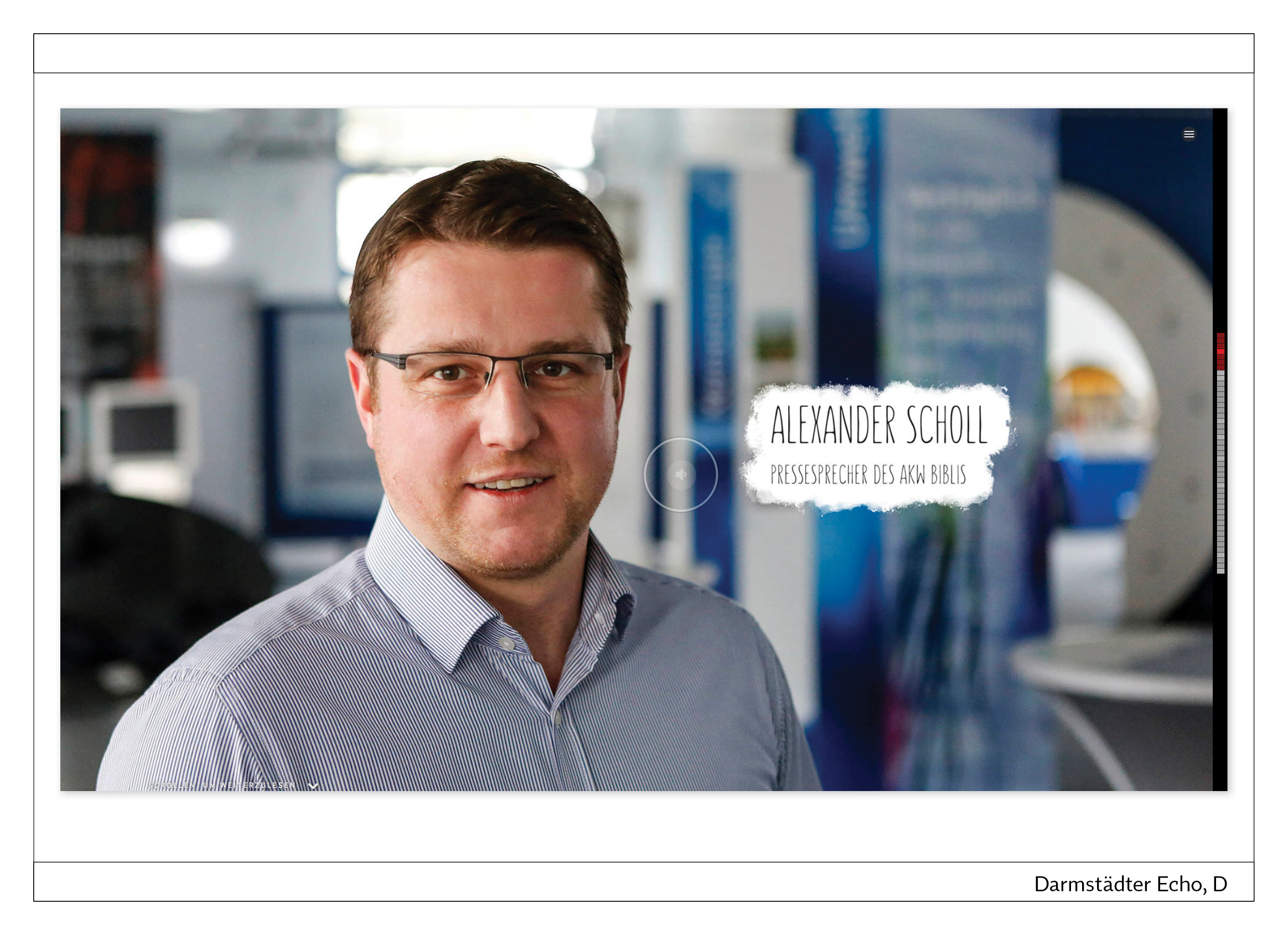

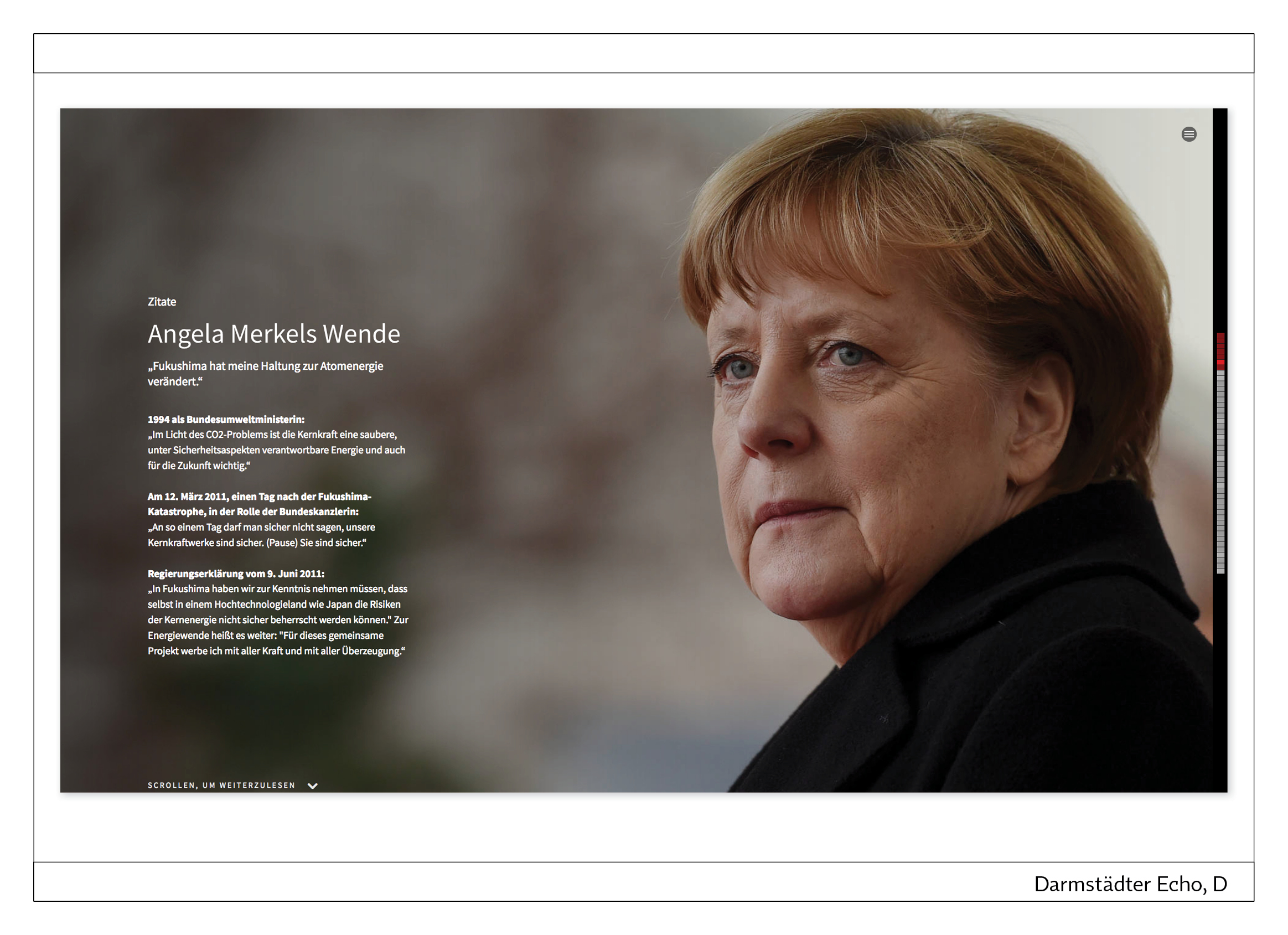
Kontakt:
Norbert Küpper, Büro für Zeitungsdesign, Gutenbergstr. 4, 40670 Meerbusch, Deutschland, Telefon +49 2159 911615, Email: nkuepper@newspaperaward.org Website: www.newspaperaward.org
Norbert Küpper ist Veranstalter des European Newspaper Award.
Newspapers continue to evolve, both in print and online. The European Newspaper Award shows the latest trends every year. If you look at the examples on the website www.newspaperaward.org or work through the yearbook (order HERE), you will notice that the slogan “Yes, we can!” By Barack Obama fits well with the positive, optimistic attitude that the makers of excellent work mediate.
This year, the best newspapers in Europe come from Luxembourg (Tageblatt), the Netherlands (De Limburger), Norway (Morgenbladet) and Germany (Handelsblatt). All in all, 185 newspapers from 27 countries took part in the 19th European Newspaper Award.
Large number of submissions in print and online. Once again newspapers from most European countries competed for the 19th European Newspaper Award. There is no drop in the number of pieces of work submitted, and the high quality impressed the jury.
Main trend: gradual further-development in the print sector. Newspapers have many subscribers who are not necessarily open to every new feature. That is why there tends here to be a gradual further-develop-ment rather than abrupt changes. The general trend is away from full, self-contained text and towards alternative story forms and visual storytelling. Major topics in many newspapers are spread across double-pages and presented with maps, infographics and charts.
120 online projects by 30 newspapers. The quality of online submissions has risen. The jury were presented with about 120 projects by 30 newspapers from all over Europe. One Judges‘ Special Recognition went to the Tages-Anzeiger, Zürich, for this newspaper’s numerous outstanding online projects.
Online trend: film projects and “Snow Fall” stories. Six film projects and 14 multimedia stories received awards. These related to, for example, portraits of people in the region (Main Post, Würzburg) or elucidating the voting system in the USA with the aid of animated infographics. Especially impressive was a reportage by Politiken, Denmark, on rescuing refugees from the Mediterranean.
Social media. Newspapers are naturally also active in the social media sector. For that reason there is a separate category for these. One distinction went, among others, to the Axel Springer Academy for the snapchat project “Sachor jetzt” (Hebrew for “Remember now.”). This was developed by 16 volunteers of the Academy. Documentation of this project can be found at: www.sachor.jetzt
Magazine look. A trend that started particularly in Northern Europe is that of designing newspapers to look like magazines. The Tageblatt, Luxembourg, has developed more in this direction in recent years. Cover stories that are carried on inside the paper and alternative story forms form part of the daily repertoire of this newspaper, which this year won one of the four main prizes.
Cover and cover story. The trend towards cover and cover story has been intensifying amongst Europe’s newspapers. Local and regional newspapers in Scandinavia and in Belgium and The Netherlands as well give prominence to a topic
1 The Saturday paper is transformed into a a weekly paper.
This is what‚ Allgemeine Zeitung Mainz‘ is doing together with their joint publishers. The volume has been extended and new topics have been inserted, which make for a relaxed leisure time reading. Each front page of the local sections on that day is almost devoted to a single issue.
2 Poster-like covers.
More and more newspapers have decided to use a big lead-in topic. In this respect, ‘Tageblatt‘ from Luxembourg, published in the Berlin format, is certainly prominent in the German language area. Many other newspapers like ‘Kleine Zeitung‘ from Graz (A), ‘Polska‘ or ‘Delovoy‘ from St. Petersburg use a tabloid format which makes it easier for their covers to resemble posters.
3 Professional ‘snow fall‘ projects.
In recent years, newspapers have experimented with this and other online-formats. In this year‘s competition it has become evident that this new journalistic tool is now common knowledge and professionally used.
4 Online trend towards text-driven news apps.
Already at the last competition, news apps that could be navi-gated intuitively had been awarded. Examples are ”Der Tag“ – The Day – of ‘Frankfurter Allgemeine Zeitung‘ (FAZ) and “app12” of ‘Tages-Anzeiger‘. Mostly lengthy texts are offered on smart phones. A high user rate is indicative of their success.
5 Visual journalism remains trendy.
Alternative story forms, visual story telling, photo reportages – all those journalistic genres continue to be used for the printed media. The trend towards a stronger visual presentation of contents is still there.
6 Data journalism: only few specialists.
‘Berliner Morgen-post‘ and ‘Tages-Anzeiger‘ stand out because of their great number of projects containing data journalism. But it seems that there are only few specialists who can make large amounts of data accessible online.
7 Increase in infographics in Central Europe.
For some time the Iberian Peninsula and Greece had been the trailblazers for double-page infographics. This journalistic feature has now crossed the borders of Denmark, Great Britain, the Benelux states and German speaking countries.
European Newspaper Award:
Since its foundation in 1998, the competition has been organized by newspaper designer Norbert Küpper. The 19th contest involved 185 newspapers from 27 countries.
European Newspaper Congress:
In the first four years, the award ceremony took place in the Coronation Hall of the Aachen City Hall. In 1993 Norbert Küpper founded the European Newspaper Congress, where innovative print and online projects from across Europe are presented. The European Newspaper Congress has been held in Vienna since 1994. It is carried out by the Verlag Oberauer from Salzburg in cooperation with Norbert Küpper.
Alongside the Awards of Excellence there are four main prizes. The European Newspaper Award has always been divided up into local newspaper, regional newspaper, nationwide and weekly newspaper categories, because these four newspaper types have different resources and target groups.
European Newspaper of the Year, Category Local Newspaper:
Tageblatt, Luxembourg
European Newspaper of the Year, Category Regional Newspaper:
De Limburger, the Netherlands
European Newspaper of the Year, Category Nationwide Newspaper:
Handelsblatt, Germany
European Newspaper of the Year, Category Weekly Newspaper:
Morgenbladet, Norway
This newspaper appears in Luxembourg in Berliner format and has a circulation of about 20,000. The newspaper employs 30 journalists, six photographers and four layouters.

Jury statement
The Tageblatt has been continuously developed as regards content and design in recent years. The front page shows just by its visually well-prepared theme that the paper is produced more in the style of a weekly newspaper. Instead of briefly touching upon a number of topics it presents a few well-chosen ones in detail for the reader. Not only text but also alternative story forms and infographics are employed. There is no doubt about it, the Tageblatt is European Newspaper of the Year and will be able to display the proof of this at its masthead for a year.
This newspaper appears in the province of Limburg in tabloid format. The newspaper has a circulation of 122,614. Editorial staff include 98 journalists, 17 photographers and 12 layouters. The newspaper was given an award during the very first European Newspaper Award competition. At that time it was still appearing in full format and bore the name „Dagblad de Limburger“.
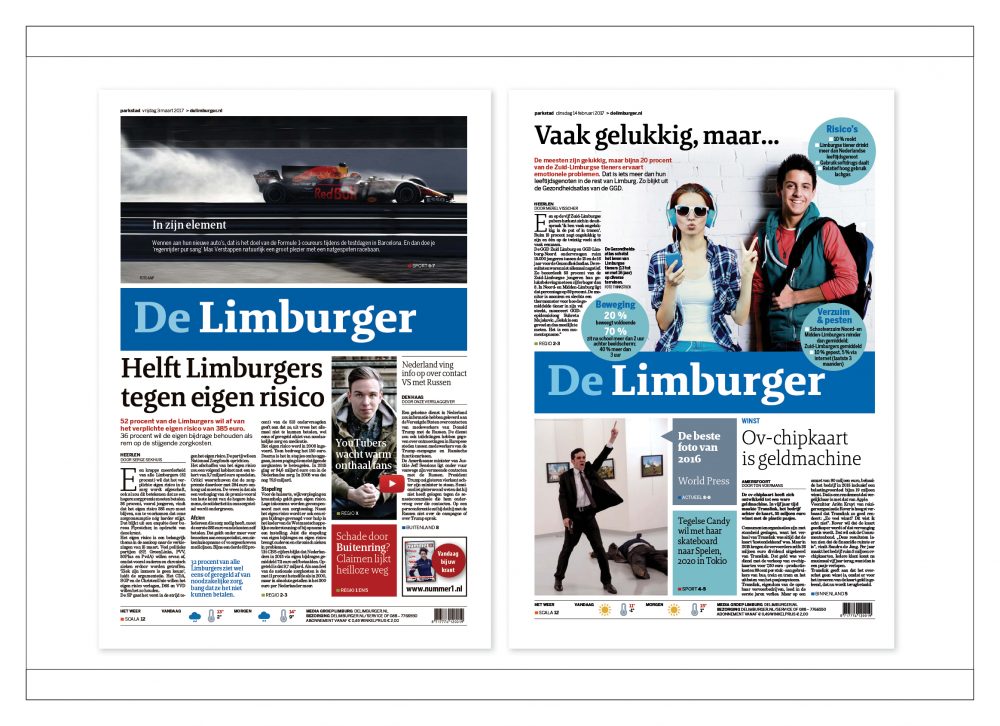
Jury statement
De Limburger has a very modern, visually emphatic front page. Two to three topics are presented here. New layout variants are always selected. In that way an impression of sameness is avoided. The newspaper has various sections, where the style of the front page is carried on. These include the local sections and Scala, Horizon and Sport. Here likewise a great deal of background is offered and fewer short reports. At the week-end there is the L Magazine – Lekker Weekend (Great Week-End). In this magazine the editors demonstrate creativity in their choice of topic and layout.
This newspaper has a circulation of 122,015. Of these 44, 537 are in e-paper form (German Audit Bureau of Circulation (IVW) 3/2017). Around 200 editors, correspondents and permanent employees work for the Handelsblatt, six of them layouters, five photo editors and seven infographic artists. The newspaper does not have its own photographers.
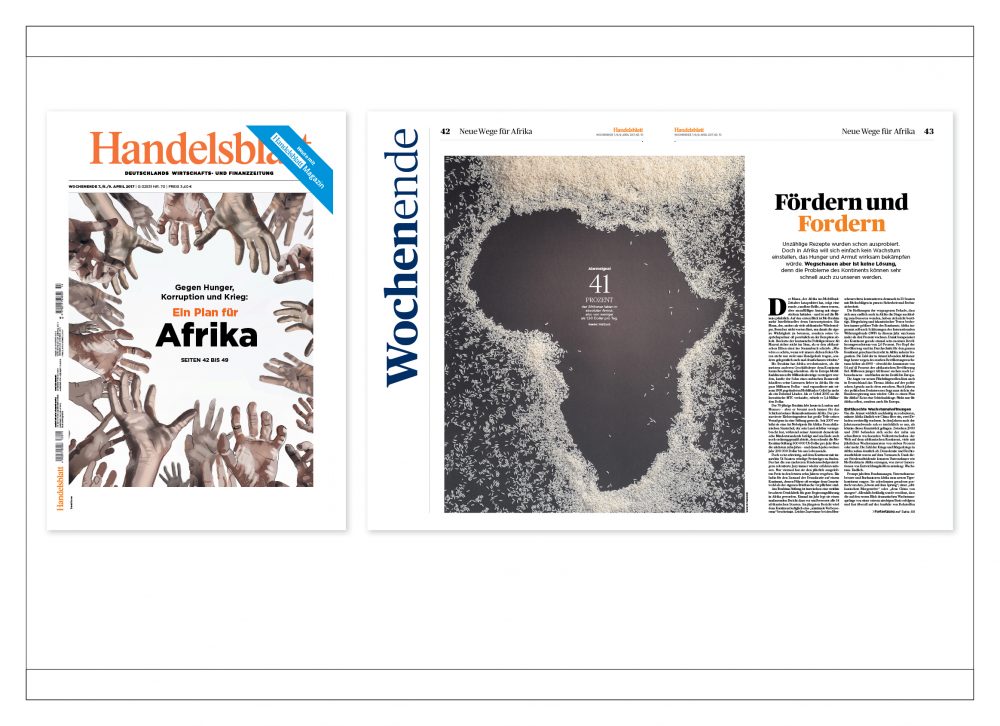
Jury-Statement
Because of its handy tabloid format the Handelsblatt is pleasantly different from other newspapers. Daily two-page infographics were recently introduced, and the cover stories at the week-end are virtually without equal in Europe for their level of detail and magazine-style layout. The process of transformation in the direction of electronic media is well under way here, because one-third of the circulation is in e-paper form. This means that customers are very open to innovation. A highlight of online activity is the publisher’s Morning Newsletter, which is often quoted in other media.
Morgenbladet is published in Oslo with a circulation of 29.000 copies and online on morgenbladet.no. The newspaper has an in-house staff of 29 editors, journalists, photographers, Art Director and marketing as well as a large portfolio of freelancers.
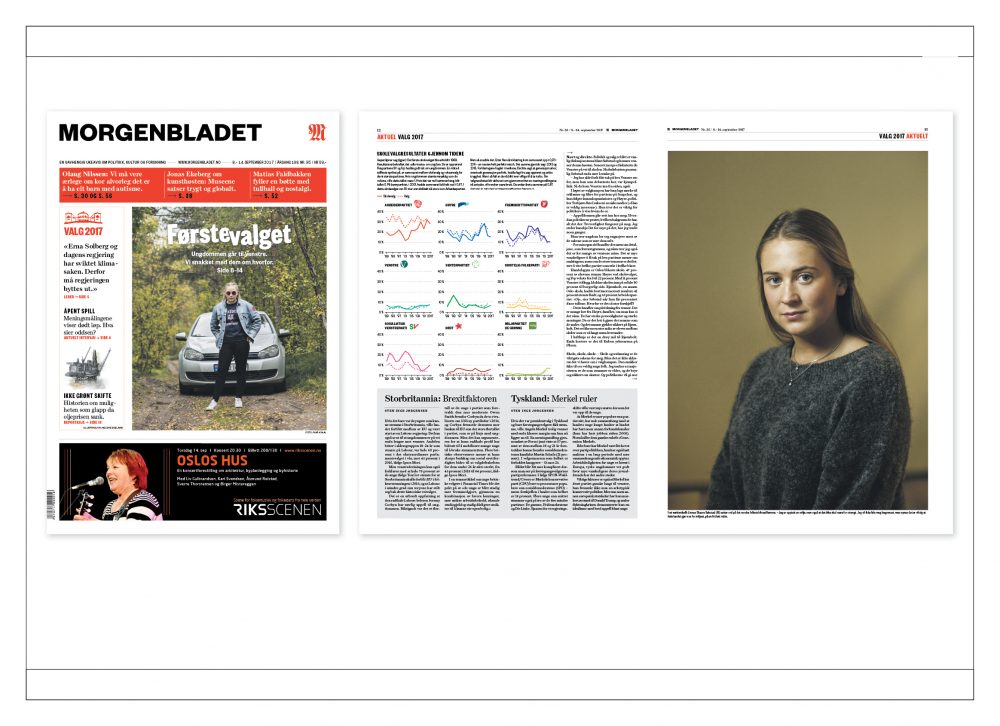
Jury-Statement
The Morgenbladet can be described in three short phrases: 1. cover and cover stories, 2. big photo-reportage and 3. topics that are visually got up with illustrations. The front page is usually devoted to a single topic. On the inside pages the treatment of images and page layout is very varied and because of the tabloid format very magazine-like. One highlight is cartoons on international-political topics. An attractive detail is the infographic of the week at the bottom of page two. All in all Morgenbladet offers an unmistakable profile content- and designwise.
The 16 members of the jury are from nine different countries: Greece, Denmark, Finland, the Netherlands, Portugal, Switzerland, Ireland, Norway, and Germany. They are journalists, scientists and designers.
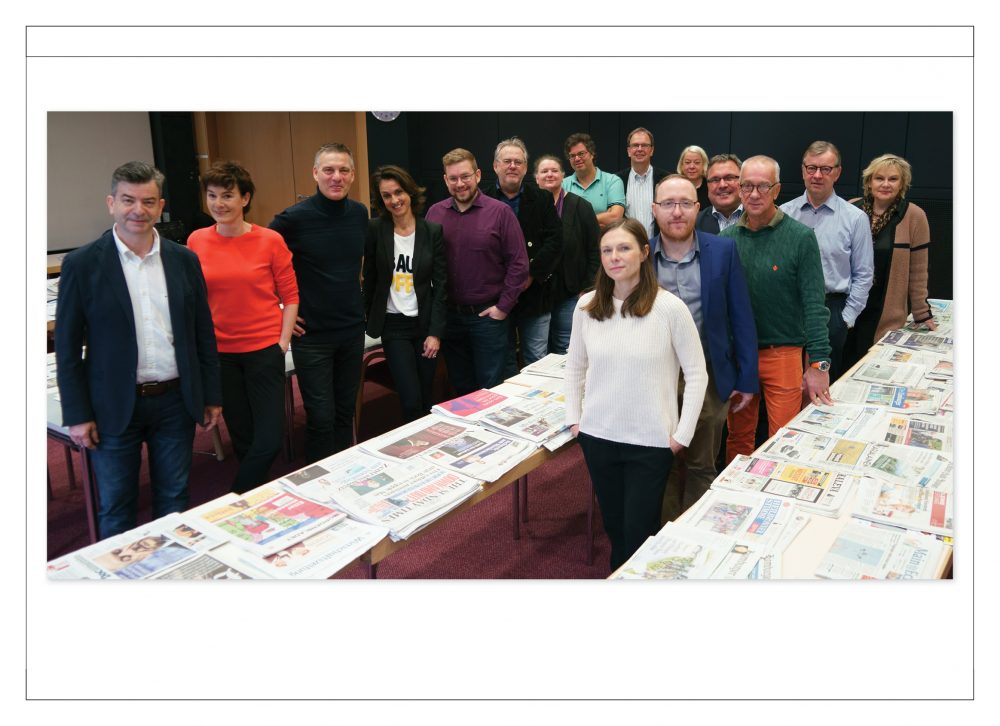
The jury of the 19th European Newspaper Award (from left):
– Dimitris Nikas, art director, H Kathimerini, GR
– Eva Dähne, art director, Stuttgarter Nachrichten, D
– Søren Nyeland, art director, Politiken, DK
– Marianne Bahl, art director, Børsen, DK
– Björn Heselius, principal designer, Nitor, FIN
– Theo Dersjant, Director Fontys School of Journalism, NL
– Alie Veenhuizen, art director, Leeuwarder Courant, NL
– Marco Grieco, art director, Expresso, P
– Detlev Scheerbarth, Märkische Allgemeine, Potsdam D
– Marianne Hartz, art director, Lebensmittel Zeitung, D
Second row:
– Tanja Starkowski, picture editor, St. Galler Tagblatt, CH
– Kevin Loftus, art director, The Mayo News, IRL
– Walter Jensen, art director, Bergens Tidende, N
– Andreas Kemper, member of the chief editorial staff, Main-Post, D
– Prof. Joachim Blum, media consultant, D
– Annette Milz, editor-in-chief, MediumMagazin, D
The members of the jury are excluded from the assessment of their own contributions.
Contact: Norbert Küpper · Office for Newspaper Design · Gutenbergstr. 4 · 40670 Meerbusch · Germany · E-Mail mail@newspaperaward.org · Phone +49 21 59 91 16 15 · Website www.newspaperaward.org
Zeitungen entwickeln sich kontinuierlich weiter, in Print und Online. Der European Newspaper Award zeigt jedes Jahr die aktuellen Trends. Wenn Sie auf der Website www.newspaperaward.org die Beispiele ansehen oder das Jahrbuch durcharbeiten, (Bestellung HIER) werden auch Sie feststellen: Der Slogan „Yes, we can!“ von Barack Obama passt sehr gut zur positiven, optimistischen Haltung, die die Macher der ausgezeichneten Arbeiten vermitteln.
Die besten Zeitungen Europas kommen in diesem Jahr aus Luxemburg (Tageblatt), den Niederlanden (De Limburger), Deutschland (Handelsblatt) und Norwegen (Morgenbladet). Insgesamt nahmen 185 Zeitungen aus 27 Ländern am 19. European Newspaper Award teil. Die Preisverleihung findet am 14. und 15. Mai im Rahmen des European Newspaper Congresses in Wien statt. Website www.newspaper-congress.eu
Auffällig ist dabei die schrittweise Weiterentwicklung im Print-Bereich. Die naheliegende Erklärung: Zeitungen haben in der Regel Abonnenten, die nicht unbedingt jeder Neuerung aufgeschlossen gegenüber stehen. Darum neigen Zeitungsmacher auch eher zu schrittweisen Weiterentwickungen und nicht zu sprunghaften Veränderungen.
Es zeigt sich quer durch alle Einreichungen ein genereller Trend weg von geschlossenen Texten hin zu alternativen Storyformen und visual Storytelling. Große Themen werden von vielen Zeitungen auf Doppelseiten angelegt und mit Landkarten, Infografiken und Schaubildern präsentiert.
Bemerkenswert auch, wie deutlich die Qualität der Online-Einreichungen gestiegen ist. Für den 19. Wettbwerb wurden der Jury rund 120 Projekte von 30 Zeitungen aus ganz Europa vorgelegt mit deutlichem Fokus auf Bewegtbild und aufwändigeren „Snow-Fall“-Projekten. Sechs Bewegtbild-Projekte und 14 Multimedia-Stories wurden ausgezeichnet. Besonders beeindruckte übrigens eine Reportage von „Politiken“, Dänemark, über die Rettung von Flüchtlingen aus dem Mittelmeer.
Zeitungen sind natürlich auch im Bereich Social-Media aktiv. Darum gibt es dafür eine eigene Kategorie. Eine Auszeichnung ging unter anderem an die Axel-Springer-Akademie für das Snapchat-Projekt „Sachor jetzt“. Es wurde von 16 Volontären der Akademie entwickelt. Eine Dokumentation dieses Projektes ist hier zu finden: www.sachor.jetzt
Ein Trend, der besonders aus Nordeuropa kommt, ist die magazinähnliche Gestaltung der Zeitung. Das Tageblatt, Luxemburg, hat sich in den letzten Jahren in diese Richtung weiter entwickelt. Coverstories, die im Innern weiter fortgesetzt werden und alternative Storyformen gehören zum täglichen Repertoire dieser Tageszeitung, die in diesem Jahr einen der vier Hauptpreise gewonnen hat.
Der Trend zu Cover- und Coverstory hat sich bei Europas Zeitungen weiter verstärkt. Lokal- und Regionalzeitungen in Skandinavien, aber auch in Belgien und den Niederlanden präsentieren ein Thema des Tages groß auf der Titelseite und führen es dann auf zwei bis fünf Seiten im Innern fort. In Deutschland folgt das „Handelsblatt“ diesem Trend besonders deutlich in jeder Freitags-Ausgabe.
1. Die Samstags-Zeitung wird zur Wochenzeitung.
Diesen Weg beschreitet die Allgemeine Zeitung Mainz mit ihren 34 Partner-Verlagen. Der Umfang wurde erweitert und neue Themen eingebaut, die für eine entspannte Freizeit-Lektüre sorgen. Das bedeutet auch, dass jeder Lokalteil an diesem Tag eine nahezu monothematische Startseite hat.
2. Titelseite als Poster
Mehr und mehr Zeitungen gehen dazu über, ein großes Aufmacher-Thema zu präsentieren. Der Hauptpreisträger in er Kategorie überregionale Zeitung, das Handelsblatt ist auch dafür ein markanter Vertreter. Von den Zeitungen im im Berliner Format ist das Tageblatt aus Luxemburg dabei im deutschen Sprachraum sicher führend. Viele andere Zeitungen, wie z.B. die Kleine Zeitung aus Graz, Polska oder Delovoy St. Petersburg tun sich damit noch leichter, weil sie im Tabloid-Format erscheinen.
3. Professionelle „Snow-Fall“-Projekte.
In den letzten Jahren haben Zeitungen mit diesem und anderen neuen journalistischen Online-Formaten experimentiert. Beim diesjährigen Wettbewerb sieht man, dass dieses neue Werkzeug inzwischen im Alltag professionell genutzt wird.
4. Online-Trend zu textgetriebenen News-Apps.
Schon im vorigen Wettbewerb wurden intuitiv zu navigierende News-Apps ausgezeichnet. Beispiel: Der Tag von der FAZ und die App 12 des Tages-Anzeigers. Hier werden vor allem lange Texte auf dem Smartphone angeboten. Hohe Nutzerzahlen dieser Apps zeigen den Erfolg.
5. Visueller Journalismus bleibt im Trend.
Alternative Storyformen, visual Storytelling, Foto-Reportagen – all diese journalistischen Genres werden mehr und mehr in Print eingesetzt. Es gibt also nach wie vor einen Trend zu stärkerer visueller Präsentation von Inhalten.
6. Datenjournalismus: wenige Spezialisten.
Die Berliner Morgenpost und der Tages-Anzeiger fallen auf durch eine Vielzahl datenjournalistischer Projekte. Es scheint, dass sich nur wenige Spezialisten damit befassen, größere Datenmengen online zugänglich zu machen.
7. Infografiken auch in Zentraleuropa häufiger.
Die iberische Halbinsel und Griechenland waren in Europa Vorreiter bei doppelseitigen Infografiken. Diese journalistische Darstellungsform findet sich nun auch häufiger in Dänemark, Großbritannien, den Benelux-Ländern und im deutschen Sprachraum.
European Newspaper Award:
Der Wettbewerb wird seit seiner Gründung im Jahr 1998 von Zeitungsdesigner Norbert Küpper veranstaltet. Am 19. Wettbewerb haben sich 185 Zeitungen aus 27 Ländern beteiligt.
European Newspaper Congress:
In den ersten vier Jahren fand die Preisverleihung im Krönungssaal des Aachener Rathauses statt. 1993 gründete Norbert Küpper den European Newspaper Congress, bei dem innovative Projekte im Bereich Print und Online aus ganz Europa vorgestellt werden. Der European Newspaper Congress findet seit 1994 in Wien statt. Er wird vom Verlag Oberauer aus Salzburg in Kooperation mit Norbert Küpper durchgeführt.
Neben den Awards of Excellence gibt es vier Hauptpreise. Der European Newspaper Award wird von jeher in die Kategorien Lokalzeitung, Regionalzeitung, überregionale Zeitung und Wochenzeitung gegliedert, weil diese vier Zeitungstypen unterschiedliche Ressourcen und Zielgruppen haben.
European Newspaper of the Year, Kategorie Lokalzeitung:
Tageblatt, Luxemburg
European Newspaper of the Year, Kategorie Regionalzeitung:
De Limburger, Niederlande
European Newspaper of the Year, Kategorie überregionale Zeitung:
Handelsblatt, Deutschland
European Newspaper of the Year, Kategorie Wochenzeitung:
Morgenbladet, Norwegen
Die Zeitung erscheint in Luxemburg im Berliner Format und hat eine Auflage von ca. 20.000 Exemplaren. Die Zeitung beschäftigt 30 Journalisten, sechs Fotografen und vier Layouter.

Jury-Statement
Das Tageblatt hat sich in den letzten Jahren inhaltlich und gestalterisch kontinuierlich weiterentwickelt. Die Titelseite signalisiert bereits durch das visuell sehr gut aufbereitete Thema, dass hier eher im Stil einer Wochenzeitung gearbeitet wird. Es werden nicht viele Themen kurz angerissen, sondern wenige gut ausgewählte Themen ausführlich für den Leser aufbereitet. Man arbeitet dabei nicht nur mit Text, sondern es werden auch alternative Storyformen und Infografiken eingesetzt. Kein Zweifel: Das Tageblatt ist „European Newspaper of the Year“ und kann diese Auszeichnung nun ein Jahr lang im Zeitungskopf führen.
Die Zeitung erscheint in der Provinz Limburg im Tabloid-Format. Die Zeitung hat eine Auflage von 122.614 Exemplaren. In der Redaktion sind 98 Journalisten, 17 Fotografen und 12 Layouter. Beim ersten European Newspaper Award wurde die Zeitung schon einmal ausgezeichnet. Damals war sie noch im Vollformat und hieß „Dagblad de Limburger“.

Jury-Statement
De Limburger hat eine sehr moderne, visuell angelegte Titelseite. Zwei bis drei Themen werden hier vorgestellt. Es werden immer neue Layout-Varianten gewählt. Dadurch wird der Eindruck der Gleichförmigkeit vermieden. Die Zeitung hat verschiedene Sektionen, bei denen der Stil der Titelseite fortgesetzt wird. Dazu gehören die Lokalteile sowie Scala, Horizon und Sport. Auch hier wird viel Hintergrund angeboten und weniger kleine Meldungen. Am Wochenende gibt es das „L Magazine – Lekker Weekend“ – schönes Wochenende. In diesem Magazin beweist die Redaktion Kreativität bei Themenfindung und Layout.
Die Zeitung hat eine Auflage von 122.015 Exemplaren, davon 44.537 e-paper (IVW 3/2017). Für das Handelsblatt arbeiten rund 200 Redakteure, Korrespondenten und ständige Mitarbeiter, davon sechs Layouter, fünf Bildredakteure und sieben Infografiker. Die Zeitung hat keine eigenen Fotografen.

Jury-Statement
Durch das handliche Tabloid-Format hebt sich das Handelsblatt angenehm von anderen Zeitungen ab. Vor kurzem wurde die tägliche doppelseitige Infografik eingeführt und die Coverstories am Wochenende sind in ihrer Ausführlichkeit und in ihrem magazinigen Layout in Europa schwer zu übertreffen. Der Transformationsprozess in Richtung elektronische Medien ist weit fortgeschritten, denn ein Drittel der Auflage sind e-paper. Das bedeutet, dass die Kundschaft Innovationen sehr aufgeschlossen gegenüber steht. Ein Highlight der Online-Aktivitäten ist der Morning-Newsletter des Herausgebers, der oft in anderen Medien zitiert wird.
Morgenbladet, N
Morgenbladet erscheint in Oslo mit einer Auflage von 29.000 Exemplaren. Das Team besteht aus 29 Personen: Journalisten, Fotografen, Layouter. Zum Team gehört auch ein Art-Director sowie eine ganze Reihe von Freelancern. Morgenbladet erscheint im Tabloid-Format. Website: morgenbladet.no

Jury-Statement
Das Morgenbladet läßt sich mit drei Stichworten beschreiben: 1. Cover und Coverstories, 2. große Foto-Reportagen und 3. Themen, die durch Illustrationen visuell aufbereitet werden. Die Titelseite ist meist einem einzigen Thema gewidmet. Auf den Innenseiten ist der Umgang mit Bildern und das Seitenlayout variantenreich und durch das Tabloid-Format sehr zeitschriftenähnlich. Ein Highlight bilden Karikaturen zu weltpolitischen Themen. Ein schönes Detail ist die Infografik der Woche, die auf Seite zwei unten steht. Insgesamt: Morgenbladet bietet inhaltlich und gestalterisch ein ganz unverwechselbares Profil.
Die 16 Jury-Mitglieder kamen aus neun Ländern: Griechenland, Dänemark, Norwegen, Finnland, Niederlande, Portugal, Schweiz, Irland und Deutschland. Es sind Journalisten, Wissenschaftler und Designer.

Die Jury des 19. European Newspaper Award (von links):
– Dimitris Nikas, Art-Director, H Kathimerini, GR
– Eva Dähne, Art-Directorin, Stuttgarter Nachrichten, D
– Søren Nyeland, Art-Director, Politiken, DK
– Marianne Bahl, Art-Director, Børsen, DK
– Björn Heselius, Principal Designer, Nitor, FIN
– Theo Dersjant, Director Fontys School of Journalism, NL
– Alie Veenhuizen, Art-Director, Leeuwarder Courant, NL
– Marco Grieco, Art-Director, Expresso, P
– Detlev Scheerbarth, Märkische Allgemeine, Potsdam, D
– Marianne Hartz, Art-Director, Lebensmittel Zeitung, D
Zweite Reihe:
– Tanja Starkowski, Bildredakteurin, St. Galler Tagblatt, CH
– Kevin Loftus, Art-Director, The Mayo News, IRL
– Walter Jensen, Art-Director, Bergens Tidende, N
– Andreas Kemper, Mitglied der Chefredaktion, Main-Post, D
– Prof. Joachim Blum, Media-Consultant, D
– Annette Milz, Chefredakteurin MediumMagazin, D
Mitglieder der Jury sind von der Bewertung der eigenen Arbeit ausgeschlossen.
Kontakt: Norbert Küpper · Büro für Zeitungsdesign · Gutenbergstr. 4 · 40670 Meerbusch · Deutschland · E-Mail mail@newspaperaward.org · Telefon +49 21 59 91 16 15 · Website www.newspaperaward.org
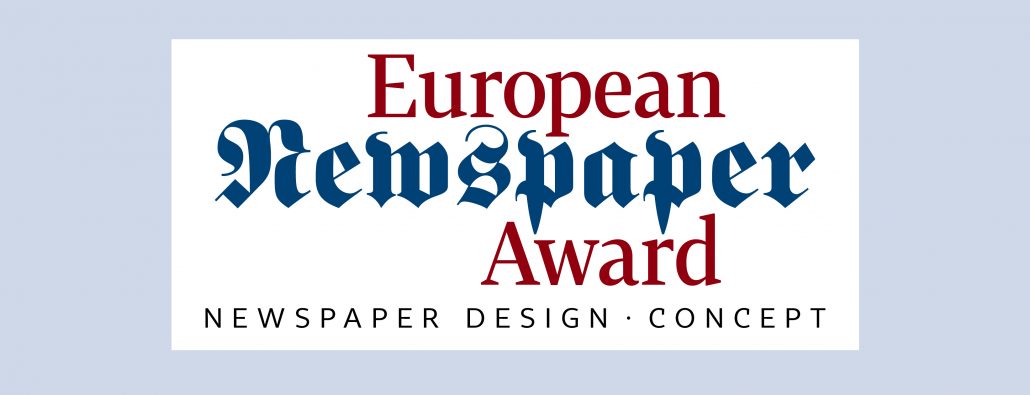
Logo European Newspaper Award.
Der European Newspaper Award wurde 1999 gegründet. Auf der Website www.editorial-design.com ist nun ein Archiv aller Hauptpreisträger veröffentlicht worden. In manchen Jahren ist auch ein Trendreport beigefügt. Man kann sich die Zeitungen und Jury-Statements aus allen Jahrgängen ansehen.
In welche Länder gingen die Hauptpreise? Man hat das Gefühl, dass die meisten Hauptpreise nach Skandinavien gingen, gefolgt von der iberischen Halbinsel. Andere Regionen scheinen deutlich weniger oft ausgezeichnet worden zu sein. Hier ist eine genauere Statistik: In skandinavische Länder gingen 21 Auszeichnungen, davon allein 12 nach Norwegen. Nach Spanien, Portugal und Griechenland gingen ebenfalls 21 Auszeichnungen, davon entfallen drei auf Griechenland. Nach Deutschland, Österreich und in die Schweiz gingen 15 Hauptpreise, davon 11 nach Deutschland. In die Niederlande, Belgien und Luxemburg gingen ebenfalls 15 Hauptpreise, davon 10 in die Niederlande. Nach Großbritannien und Irland gingen insgesamt acht Hauptpreise, vier nach Großbritannien, vier nach Irland. Je ein Hauptpreis ging nach Italien, Russland, Kroatien und Syrien – für Souriatna, eine unabhängige Wochenzeitung
Hier ist die Liste aller Hauptpreisträger. Die Links führen zur Website der jeweiligen Zeitung (Stand 4/2018).
1. European Newspaper Award (1999)
Local newspaper: Firda, Norway
Regional newspaper: Dagblad de Limburger, The Netherlands
Nationwide newspaper: Die Welt, Germany
Weekly newspaper: no award
2. European Newspaper Award (2000)
Local newspaper: Laagendalsposten, Norway
Regional newspaper: El Correo, Spain
Nationwide newspaper: The Guardian, Great Britain
Weekly newspaper: Die Woche, Germany
3. European Newspaper Award (2001)
Local newspaper: no award
Regional newspaper: no award
Nationwide newspaper: Diário de Noticias, Spain
Nationwide newspaper: Trouw, The Netherlands
Weekly newspaper: Independent on Sunday, Great Britain
4. European Newspaper Award (2002)
Local newspaper: Tønsbergs Blad, Norway
Regional newspaper: Bergens Tidende, Norway
Nationwide newspaper: Ta Nea, Greece
Weekly newspaper: Frankfurter Allgemeine Sonntagszeitung, Germany
5. European Newspaper Award (2003)
Local newspaper: Goienkaria, Spain
Regional newspaper: Heraldo de Aragón, Spain
Nationwide newspaper: Corriere della Sera, Italy
Weekly newspaper: Sunday Tribune, Ireland
Judges‘ Special Recognition: La Voz de Galicia, Spain
6. European Newspaper Award (2004)
Local newspaper: Diario de Noticias, Spain
Regional newspaper: Het Parool, The Netherlands
Nationwide newspaper: De Morgen, Belgium
Weekly newspaper: Sentinel Sunday, Great Britain
Weekly newspaper: Bergens Tidende, Norway
7. European Newspaper Award (2005)
Local newspaper: Östersunds-Posten, Sweden
Regional newspaper: Kleine Zeitung, Austria
Nationwide newspaper: The Guardian, Great Britain
Weekly newspaper: Die Zeit, Germany
Weekly newspaper: Presso, Finland
8. European Newspaper Award (2006)
Local newspaper: Hufvudstadsbladet, Finland
Regional newspaper: Bergens Tidende, Norway
Nationwide newspaper: De Morgen, Belgium
Weekly newspaper: Expresso, Portugal
Judges‘ Special Recognition: Superdeporte, Spain
9. European Newspaper Award (2007)
Local newspaper: The Mayo News, Ireland
Regional newspaper: el Periódico de Catalunya, Spain
Nationwide newspaper: Eleftheros Tipos, Greece
Weekly newspaper: Welt am Sonntag, Germany
10. European Newspaper Award (2008)
Local newspaper: Diári de Balears, Spain
Regional newspaper: Basler Zeitung, Switzerland
Nationwide newspaper: Svenska Dagbladet, Sweden
Weekly newspaper: Athens Plus, Greece
Judges‘ Special Recognition: nrc next, The Netherlands
11. European Newspaper Award (2009)
Local newspaper: Smålandsposten, Sweden
Regional newspaper: Stuttgarter Zeitung, Germany
Nationwide newspaper: i, Portugal
Judges‘ Special Recognition: 24 sata, Croatia
12. European Newspaper Award (2010)
Local newspaper: Diário de Notícias da Madeira, Portugal
Regional newspaper: Bergens Tidende, Norway
Nationwide newspaper: Politiken, Denmark
Weekly newspaper: Sunday Herald, Scotland
Judges‘ Special Recognition: Gealscéal, Ireland
Judges‘ Special Recognition: Frankfurter Rundschau iPad, Germany
12+1. European Newspaper Award (2011)
Local newspaper: Hordaland, Norway
Regional newspaper: Berliner Morgenpost, Germany
Nationwide newspaper: Berlingske, Denmark
Weekly newspaper: NZZ am Sonntag, Switzerland
14. European Newspaper Award (2012)
Local newspaper: Bygdanytt, Norway
Regional newspaper: El Correo, Spain
Nationwide newspaper: De Tijd, Belgium
Nationwide newspaper: Trouw, The Netherlands
Weekly newspaper: Die Zeit, Germany
Judges‘ Special Recognition: Welt am Sonntag Kompakt, Germany
15. European Newspaper Award (2013)
Local newspaper: Hallingdólen, Norway
Regional newspaper: Leeuwarder Courant, the Netherlands
Nationwide newspaper: de Volkskrant, the Netherlands
Weekly newspaper: Welt am Sonntag, Germany
Judges‘ Special Recognition: Moskovskie Novosti, Russia
Judges‘ Special Recognition: público.pt, Portugal
16. European Newspaper Award (2014)
Local newspaper: The Mayo News, Ireland
Regional newspaper: De Twentsche Courant Tubantia, the Netherlands
Nationwide newspaper: Público, Portugal
Weekly newspaper: Sonntagszeitung, Switzerland
17. European Newspaper Award (2015)
Local newspaper: Kvinnheringen, Norway
Regional newspaper: Ara, Spain
Nationwide newspaper: De Morgen, Belgium
Weekly newspaper: Expresso, Portugal
Judges‘ Special Recognition: publico.pt, Portugal
Judges‘ Special Recognition: Souriatna, Syria
18. European Newspaper Award (2016)
Local newspaper: Hufvudstadsbladet, Finland
Regional newspaper: Het Parool, the Netherlands
Nationwide newspaper: Politiken, Denmark
Weekly newspaper: Frankfurter Allgemeine Sonntagszeitung, Germany
19. European Newspaper Award (2017)
Local newspaper: Tageblatt, Luxemburg
Regional newspaper: De Limburger, the Netherlands
Nationwide newspaper: Handelsblatt, Germany
Weekly newspaper: Morgenbladet, Norway
20. European Newspaper Award (2018)
Local newspaper: Sunnhordland, Norway
Regional newspaper: Adresseavisen, Norway
Nationwide newspaper: fd. Het Financieele Dagblad The Netherlands
Weekly newspaper: der Freitag, Germany
Alle Ergebnisse werden in den Jahrbüchern des European Newspaper Award veröffentlicht. Die kann man über den Bookstore auf www.editorial-design.com bestellen.
Dieser Artikel stammt vom April 2018. Er wurde im Hinblick auf den 20. Europen Newspaper Award aktualisiert. Der 20. European Newspaper Award hat 18 Kategorien. Darunter sind auch einige Online-Kategorien, die in diesem Artikel beispielhaft vorgestellt werden. Es sind auch jeweils Links zu den Projekten angegeben. Den Call for Entries für den 20. Wettbewerb finden Sie hier: www.newspaperaward.org

Die 18 Kategorien des European Newspaper Award. Rot markiert sind die Online-Kategorien.
Jury-Mitglieder zeigen hier beispielhafte Online-Projekte aus dem 19. Wettbewerb, die ihnen besonders positiv aufgefallen sind. Manche Texte sind in englischer Sprache, manche in deutsch. Alle Preisträger des 19. European Newspaper Award finden Sie im Jahrbuch, das gerade auf DVD erschienen ist. Man kann es hier bestellen: https://editorial-design.com/de/buchbestellung/
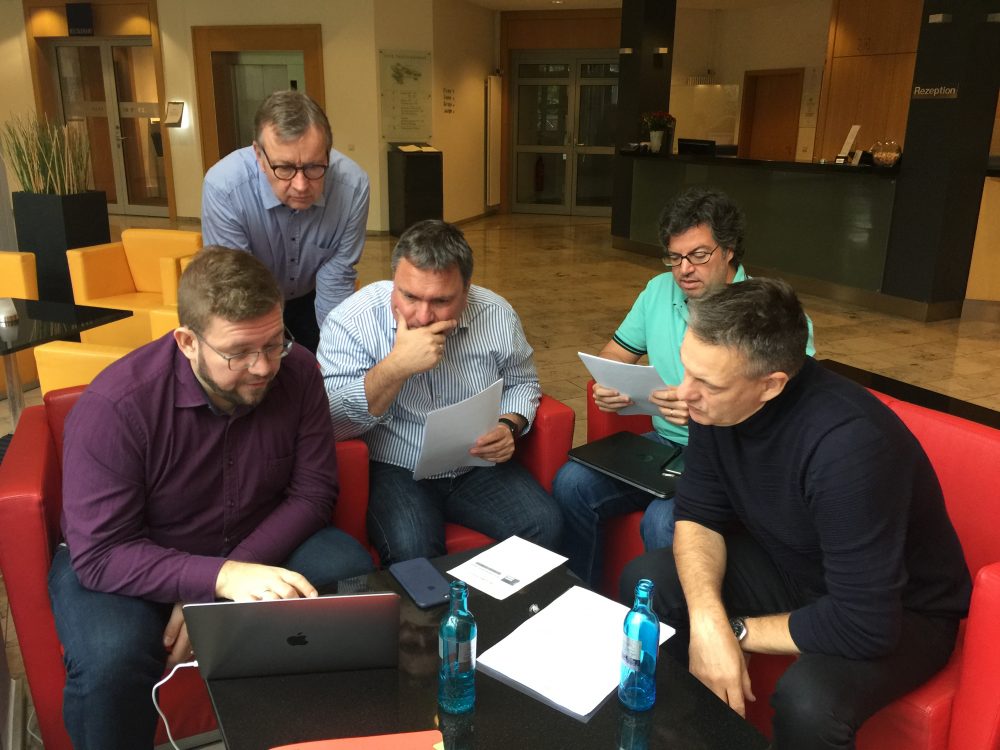
Die Jury des 19. European Newspaper Award hatte 16 Mitglieder aus neun Ländern. Fünf haben die Online-Kategorien bewertet (von links): Björn Heselius, Principal Designer, Nitor, FIN; Professor Joachim Blum, Media Consultant, D; Andreas Kemper, Mitglied der Chefredaktion, Main-Post, D; Marco Grieco, Art-Director, Expresso, P; Søren Nyeland, Art-Director, Politiken, DK. Jury-Mitglieder sind von der Bewertung der eigenen Arbeiten ausgeschlossen. Die Online-Jury bekommt die Einreichungen vorab zugeschickt. Beim Jury-Treffen wird dann nur kurz über die Award-Vergabe diskutiert.
Marco Grieco is Art-Director of Expresso, Portugal. Marco has won the main award “European Newspaper of the Year” two times, 2006 and 2015. He has chosen these projects:
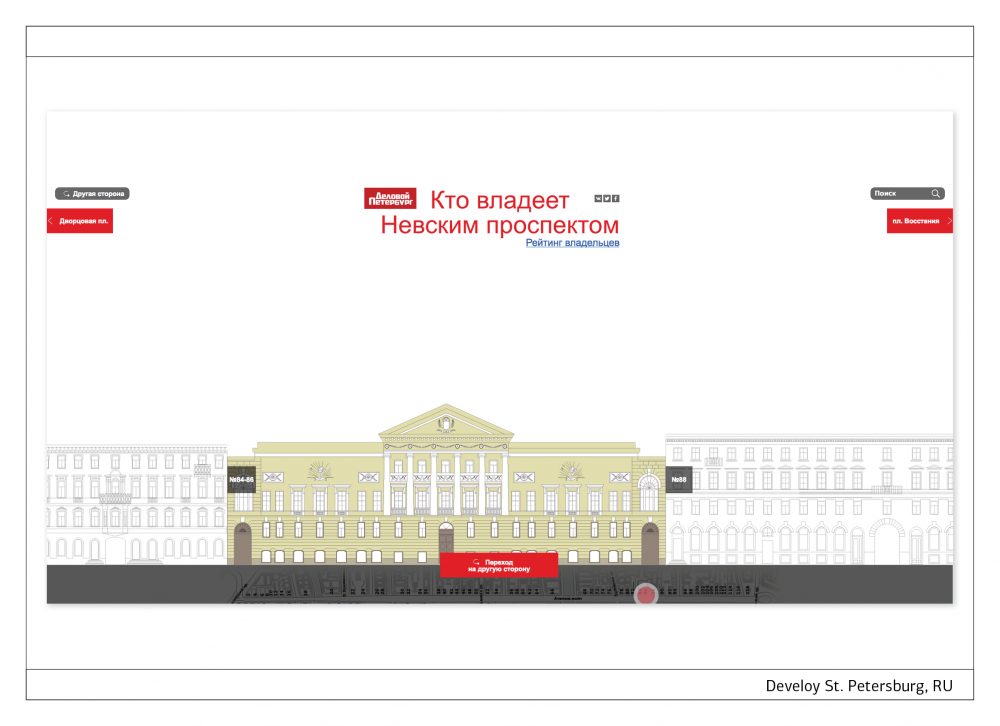
Delovoy St. Petersburg
Is it data journalism? Is it an infographic? Is it an architecture or history class? Well, this wonderful piece from the Delovoy Peterburg is all of these and even more. It is an elegant object of refined design that presents all the buildings of the main avenue of St. Petersburg city, with their most relevant information. The user can navigate it for hours and always discover some hidden treasures and curiosities. A work that meets the objective and encourage the viewer to visit that Russian wonderful city.
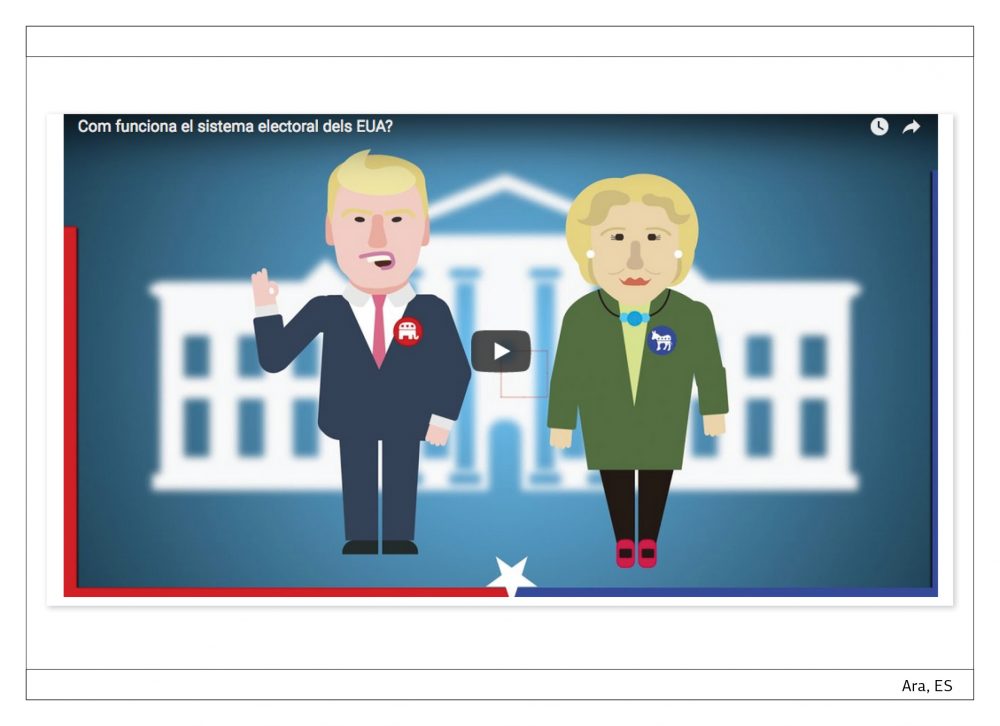
Ara.com
The United States electoral system is a little bit awkward for the regular European citizen. It is one of the biggest democracies in the world but actually with a kind of indirect voting process… So, the Catalan “Ara” tried to explain it through an animated cartoon. And succeeded, I have to say! Well designed and with a simple and funny – but not exaggerated – language that hooks the viewer, it is a good example of unpretentious multimedia format.
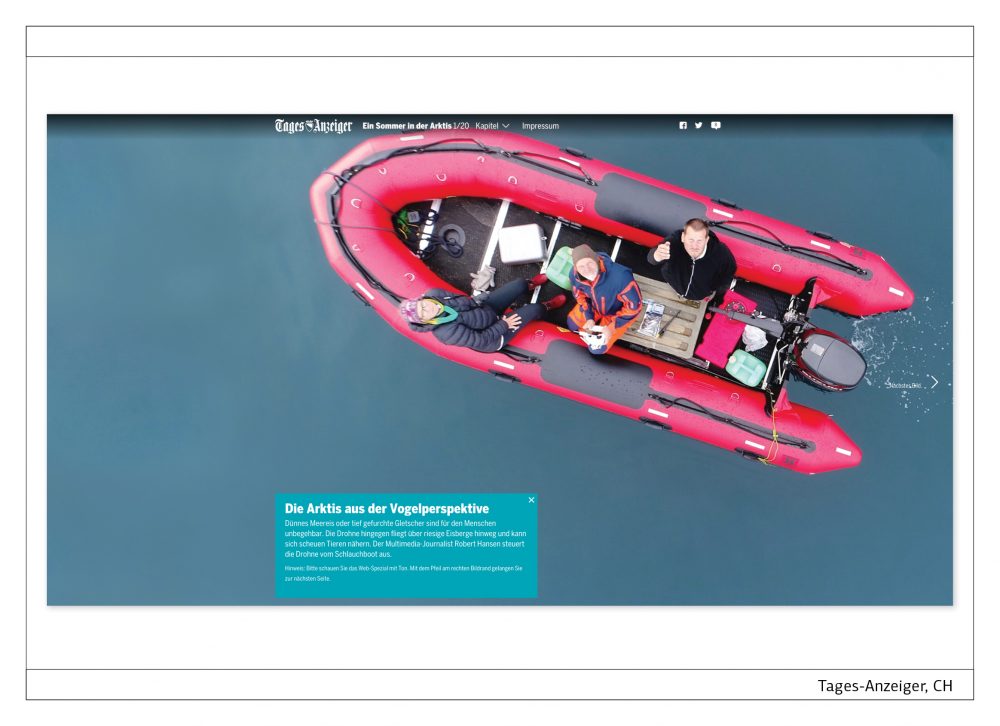
Tages-Anzeiger
Some may say that it is just a summary of drone’s videos. Maybe. And maybe it is even more overwhelming when you are showing a place that is not accessible for the most part of the common mortals. But I should say that it is not fair. It is an overwhelming example of how you/we can use the new tools to tell a rather old story. And the suspicious face of the sea lion in the chapter 5/20 is priceless… (After the start you have to click the arrow in the middle of the right side.)
Andreas Kemper ist Mitglied der Chefredaktion der Main-Post, Würzburg. Die Zeitung hat in den letzten zehn Jahren regelmäßig Awards of Excellence in Print- und Online-Kategorien des European Newspaper Award gewonnen. Er hat die folgenden drei Projekte ausgewählt:
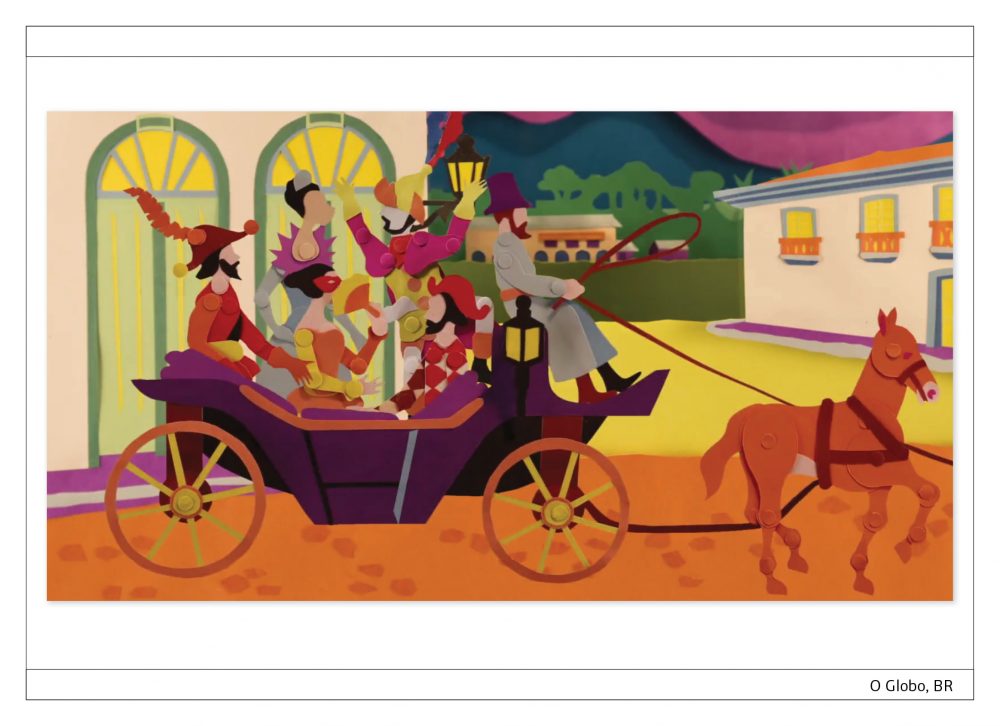
O Globo, BR
In 16 animierten Bildern zeichnet O Globo die Geschichte des Karnevals in Rio de Janeiro nach – vom Beginn des 19. Jahrhunderts bis ins Sambadrom der Neuzeit. In fünf Wochen Produktionszeit mit aufwändiger Stop-Motion-Technik ist ein wundervoll farbenprächtiges und witzig detailreiches Projekt realisiert worden, das den Betrachter in Staunen versetzt. Der eigene Stil der Figuren und Hintergründe, die Musik und die Animation loten die Grenze aus zwischen Zeichentrickfilm, Erklärvideo und Digital Storytelling. Kein Schnellschuss, sondern ein Evergreen-Content, den man sich immer wieder anschauen möchte.
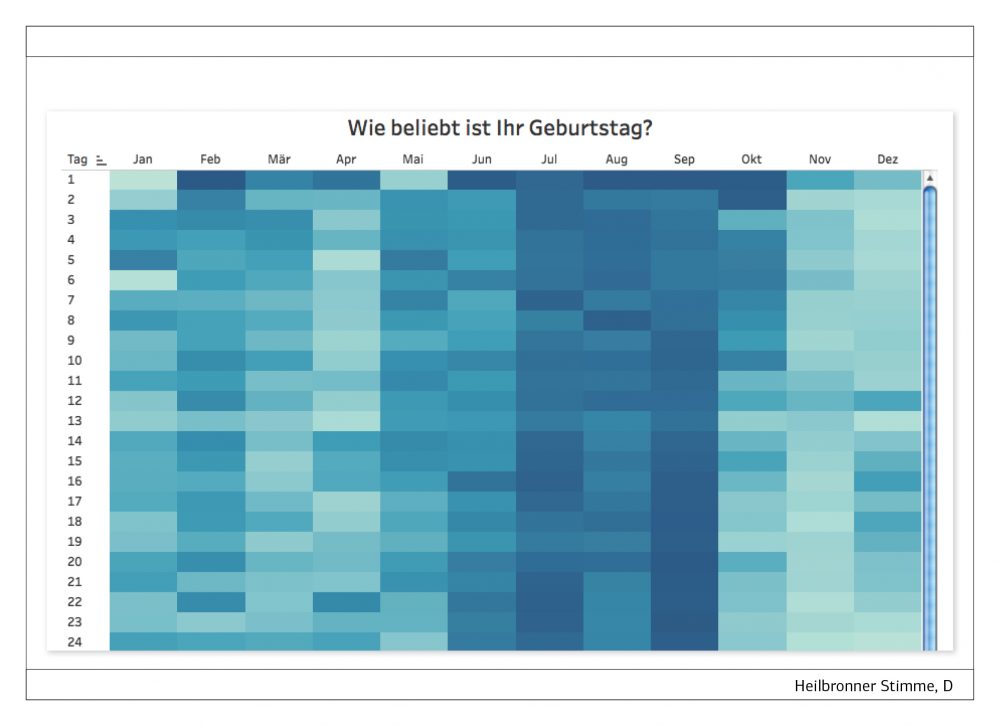
Heilbronner Stimme, D
Daten-Journalismus gilt im Allgemeinen als sehr aufwändig und als was für Spezialisten. Ist er ja normalerweise auch. Die Heilbronner Stimme zeigt, wie eine ziemlich einfache Idee kombiniert mit Big Data eine ebenso einfache aber umso überraschendere Nutzererfahrung möglich macht. Eine Heatmap zeigt die Gesamtzahl der Geburten pro Tag in Baden-Württemberg, zusammengefasst aus 35 Jahren. Faszinierend, wie in den Tagen vor Weihnachten kaum jemand auf die Welt kommen möchte, aber nach dem Fest um so mehr. Und plötzlich steht der Nutzer fast allein da, sieht er doch, dass es nicht viele sind, die mit ihm gemeinsam Geburtstag feiern. Es ergeben sich Fragen über Fragen, die natürlich nicht alle beantwortet werden – aber den Lesern der Heilbronner Stimme eine spannende interaktive Nutzererfahrung ermöglichen.
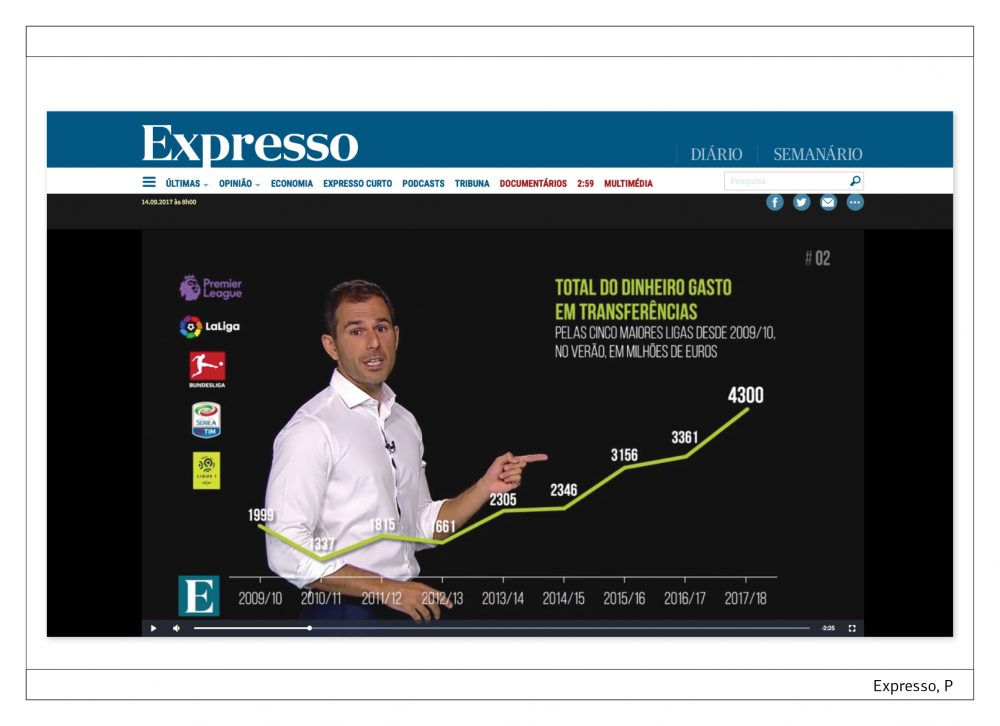
Expresso, P
http://expresso.sapo.pt/multimedia/259#gs.40bpgzI
Die Videos von Expresso überraschen mit einer innovativen Verbindung von Erklärstück und animierter Infografik. Streng in der Form und elegant in der Optik widmen sich die nicht länger als drei Minuten langen Beiträge jeweils einem einzigen Thema. Fotos, Videos, Zahlen, Karten, Balkengrafiken und viele andere Elemente wechseln in schneller Folge. Alles wird zusammengehalten vom schwarzen Hintergrund – und vom Anchor Woman oder dem Anchor Man, der nach weniger Sekunden ins Bild tritt und es auch nicht mehr verlässt, bis die Geschichte zu Ende erklärt ist. Das Format hat hohen Wiedererkennungswert und lässt keine Langeweile aufkommen. Aufklärung, die im besten Sinne unterhaltsam ist.
Björn Heselius used to be Art Diretor of Hufvudstadsbladet, Finland. This newspaper has twice been awarded the title „European Newspaper of the Year“, in 2006 and 2016. Since 2017 he is Principal Designer at Nitor, a company offering digital development, design, insight and lean-agile transformation. He has chosen these three projects:
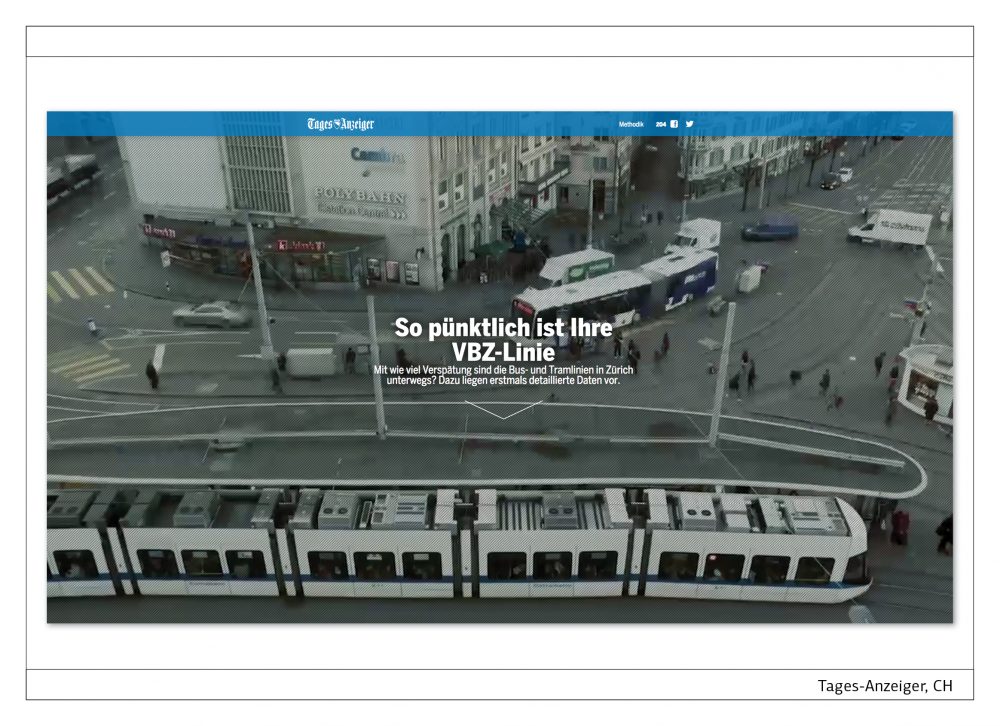
Tages-Anzeiger, CH
https://interaktiv.tagesanzeiger.ch/2016/so-puenktlich-ist-ihre-vbz-linie
The commuter traffic in Zürich has published data on the punctuality of bus and tram routes in the city. The visualizations show the three most rush prone stations during rush hour – lead by the Central, where around 46 000 people enter or exit a commuter vehicle in a typical Monday.
By analyzing the data for each bus or tram line, the fleet, each stop and station as well as the infrastructure at each stop, Tages Anzeiger has made a very useful data presentation that lets us as users know what lines probably will be delayed due to construction work or busy traffic. In other words, by opening up the data the commuter traffic company let citizens make decisions on how to avoid getting stuck in traffic and as a result they might even ease the pressure on some of the most heavily used routes.
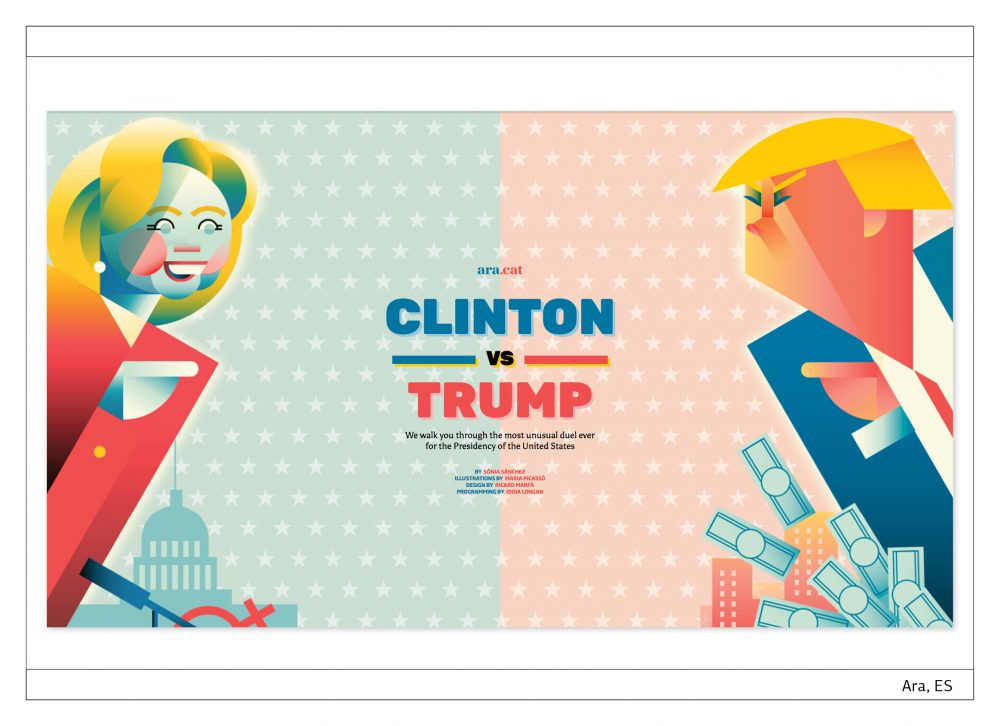
Ara.com
http://interactius.ara.cat/clinton-trump/en
With the delicate but still intense visual touch that we have come to expect from Catalonian Ara, they present a beautifully designed and developed comparison of the two candidates for the office of President of the USA – Hillary Clinton and Donald Trump.
As you scroll down the classical side-by-side comparison, it will focus on one story field at a time, helping you read and understand the story before you. Also, the most important points of comparison are highlighted, making it easy to both fast forward through the story, only comparing the most remarkable highlights for each candidate.
Needless to say, the story works just as smoothly on mobile as it does on desktop.
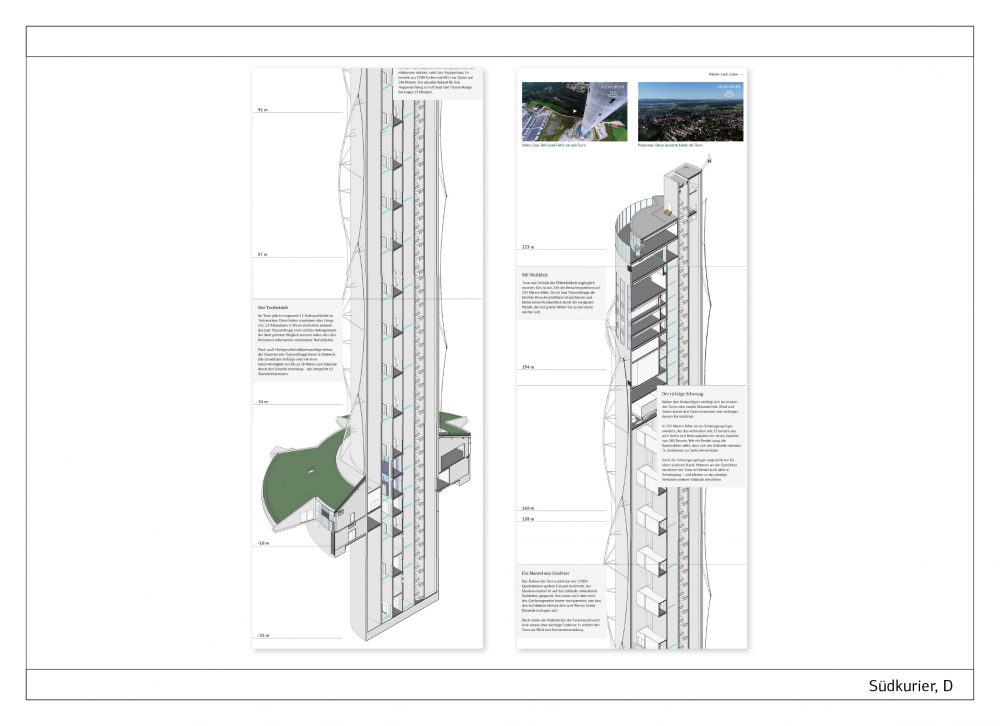
Südkurier
The tallest building in Baden-Württemberg is the test tower outside Rottweil, used by Thyssen Krupp elevators to test and develop new technologies. Beginning at 32 meters below ground, the scrollytelling story by Südkurier takes us on a tour of the landmark, floor by floor until we have scrolled ourselves up to 246 meters above ground. By the time you reach the top of the tower, and have been served selected pieces of information, you can also check out the 360 degree video from the construction of the tower, but be adviced – it is not suitable for anyone with even the mildest fright of heights.
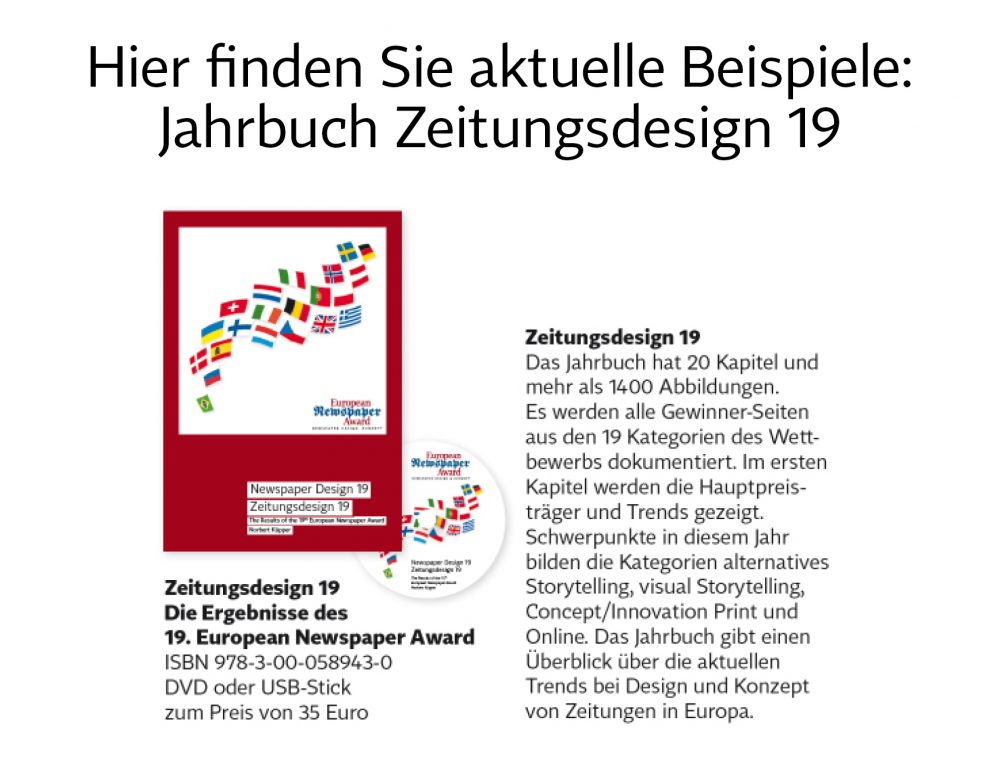
Das Buch gibt es ausschließlich auf DVD oder USB-Stick. Bestellung am besten über den Bookstore auf https://editorial-design.com/de/buchbestellung/ in jeder Buchhandlung und bei Amazon.
